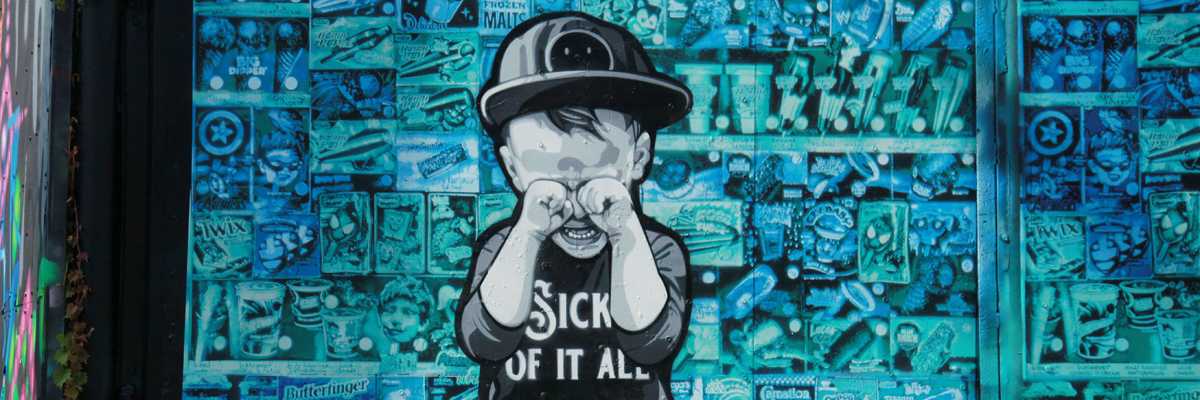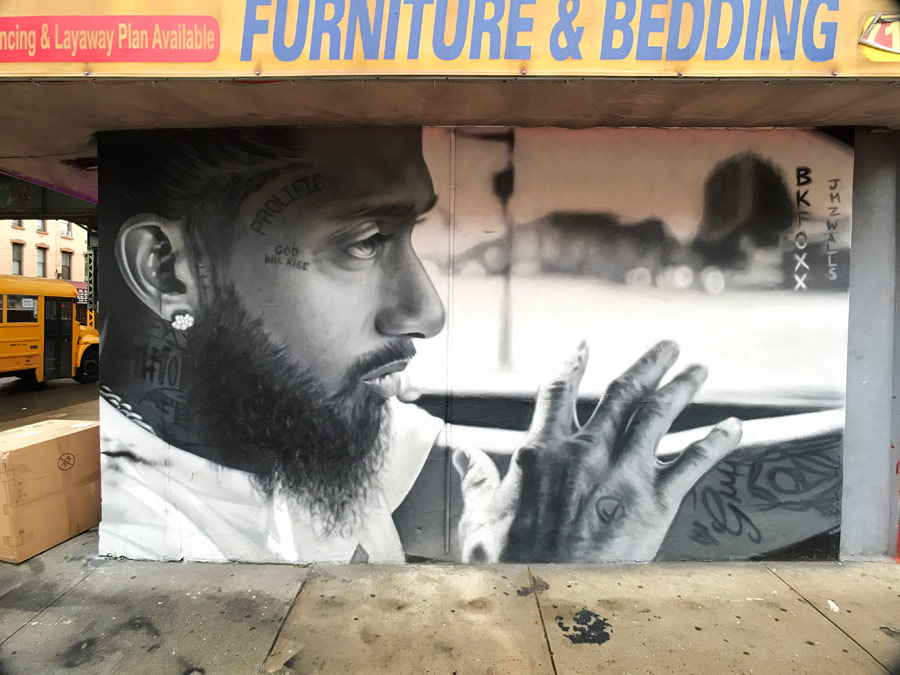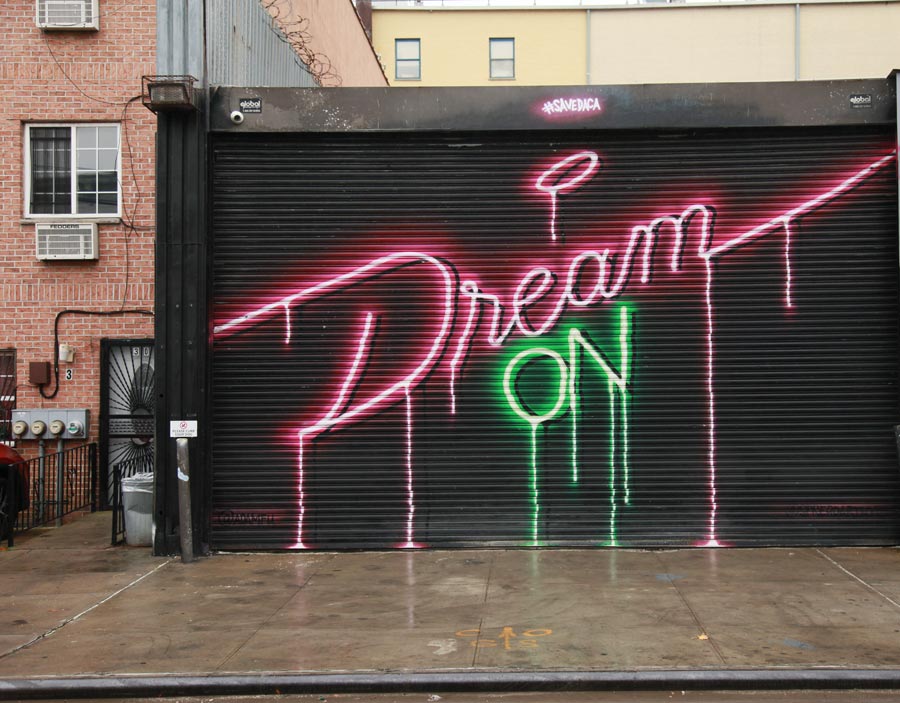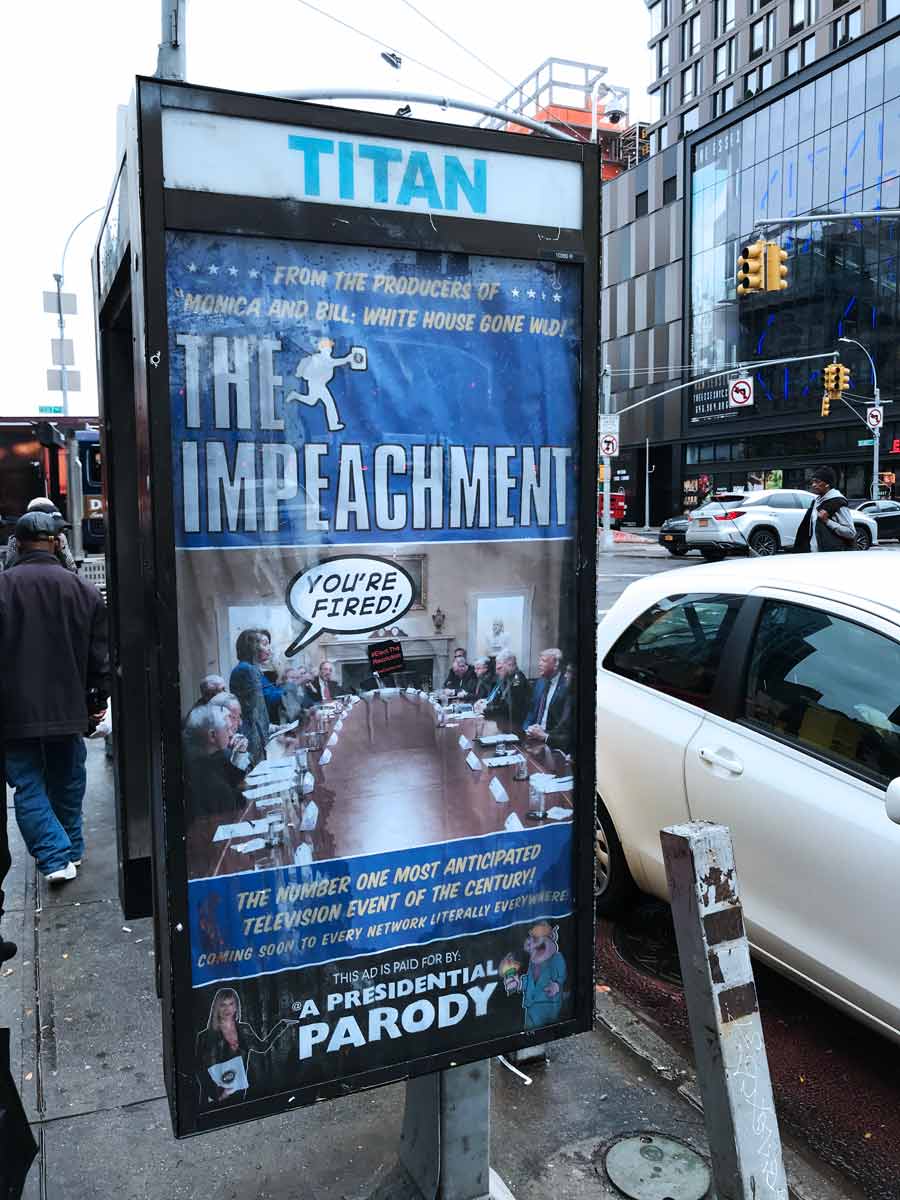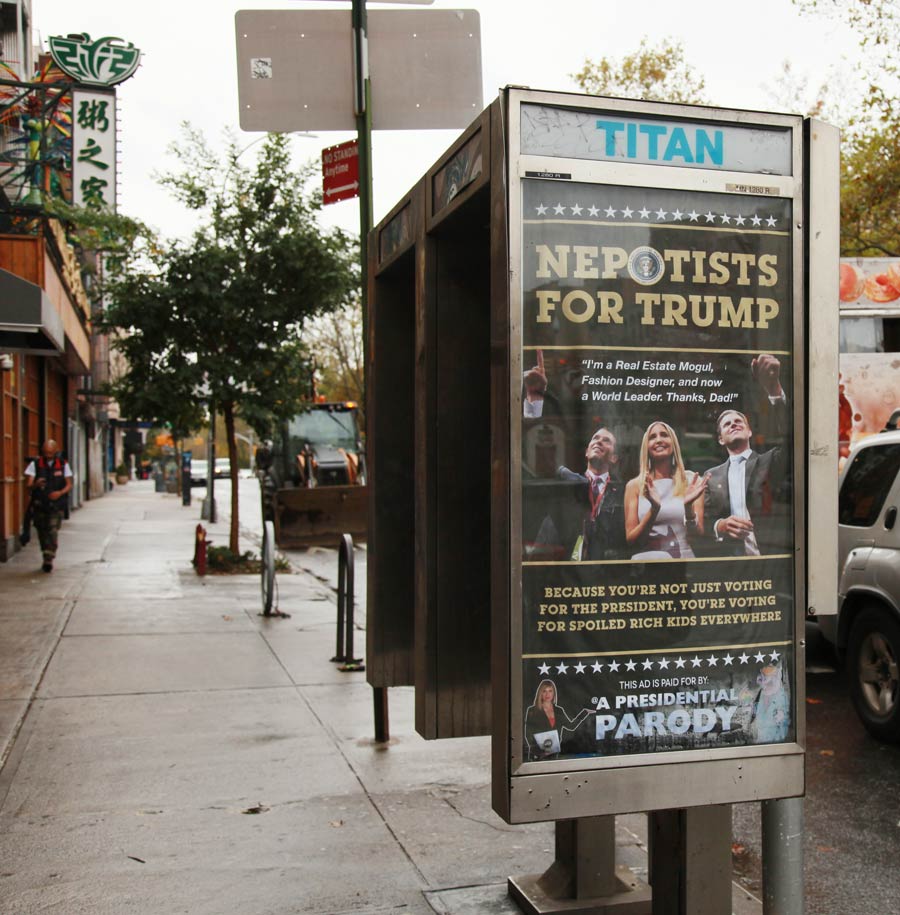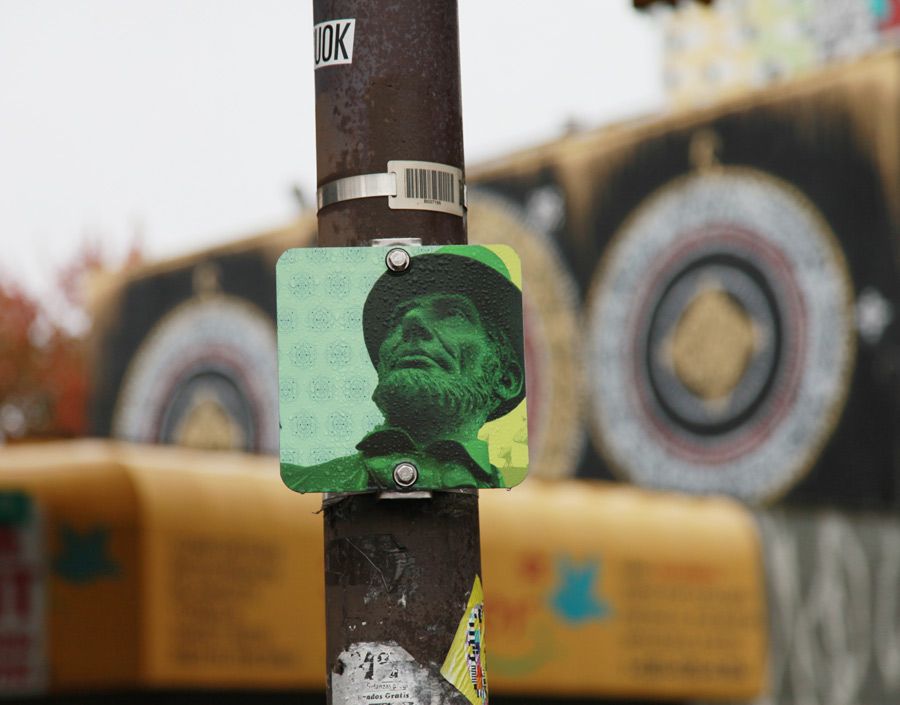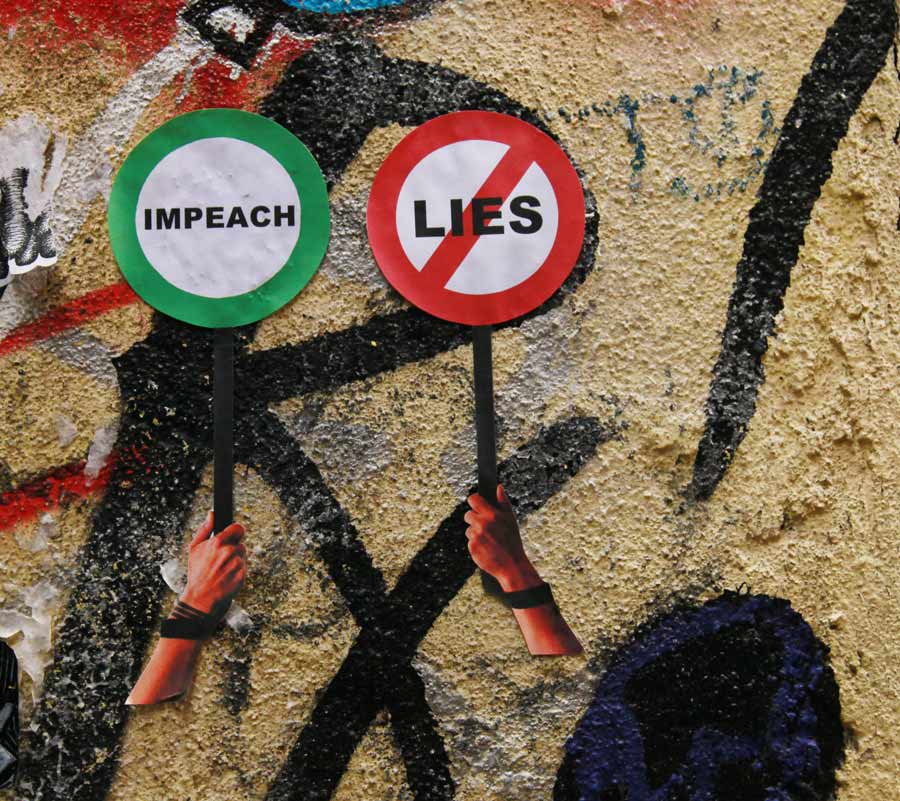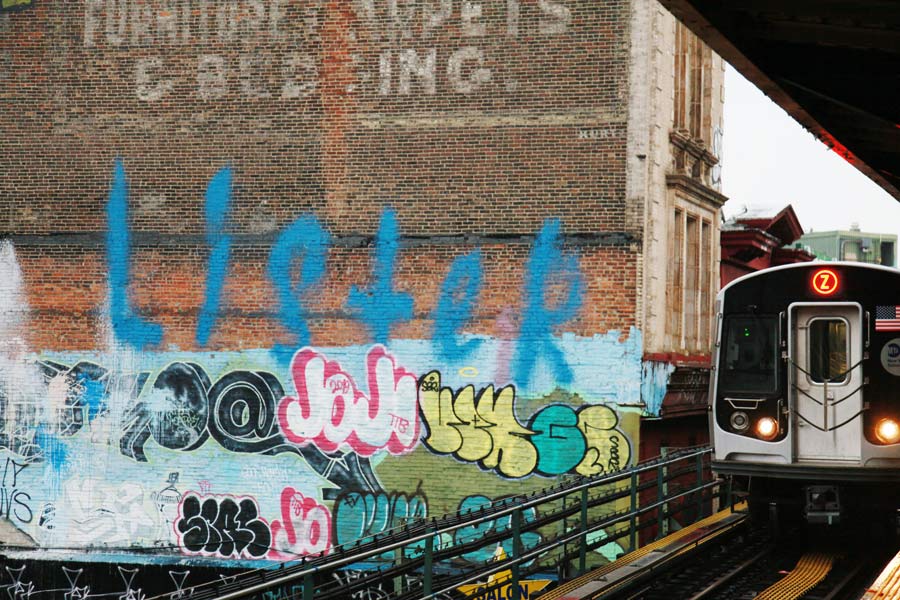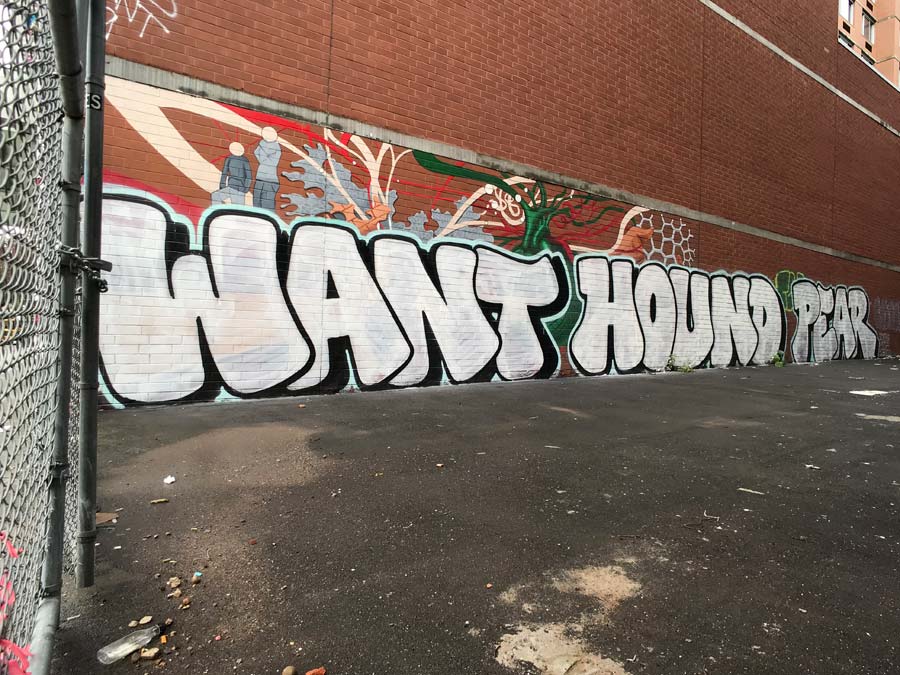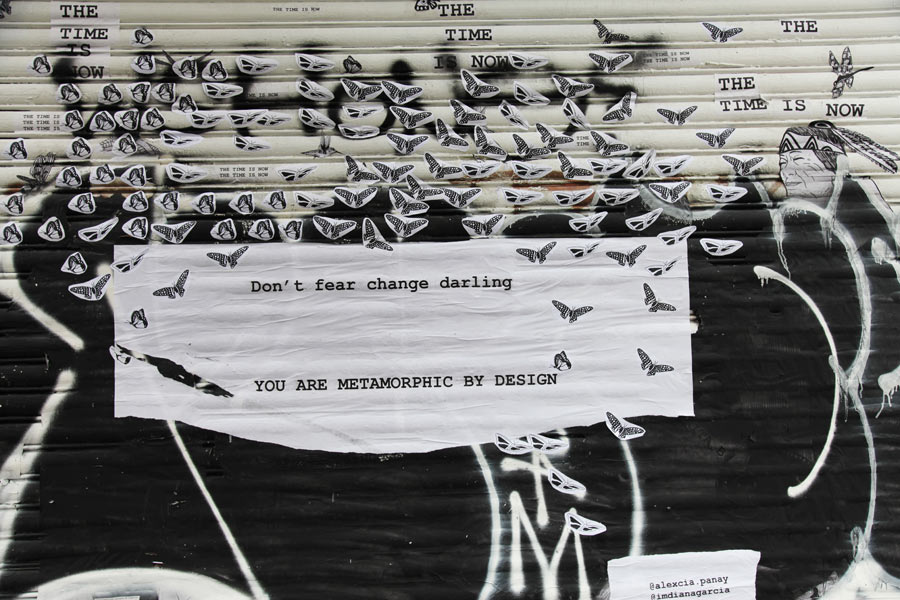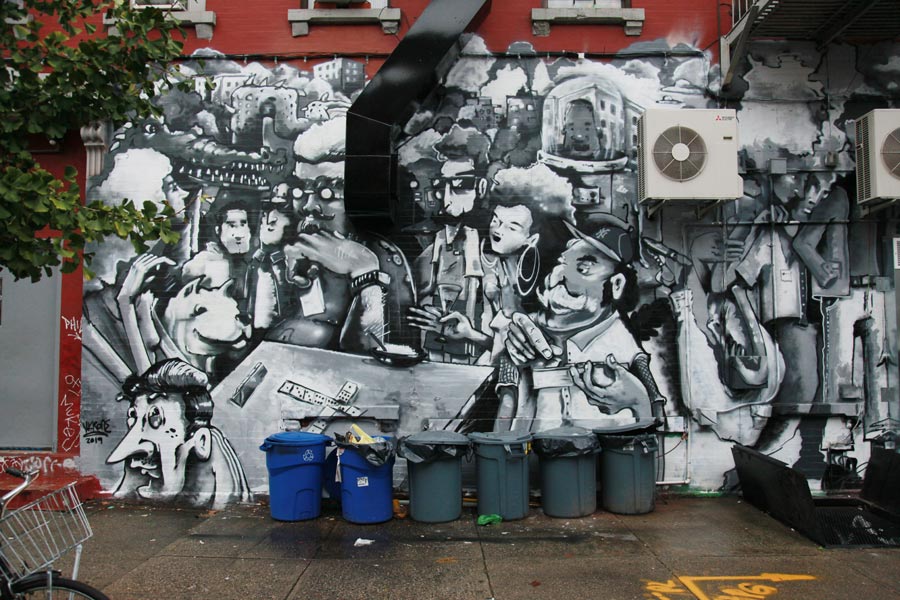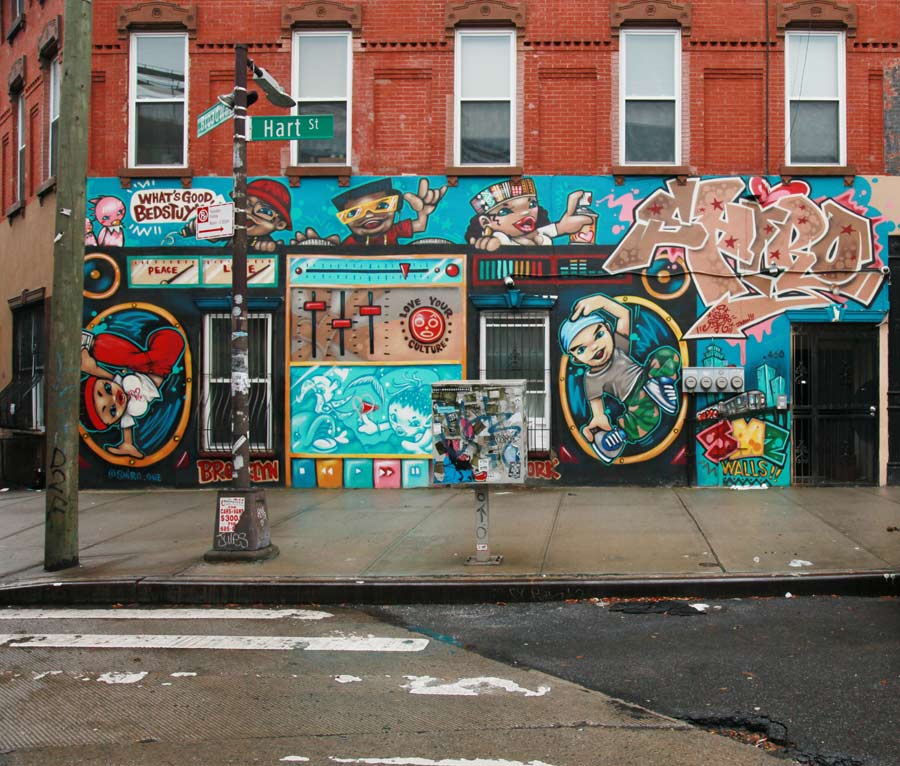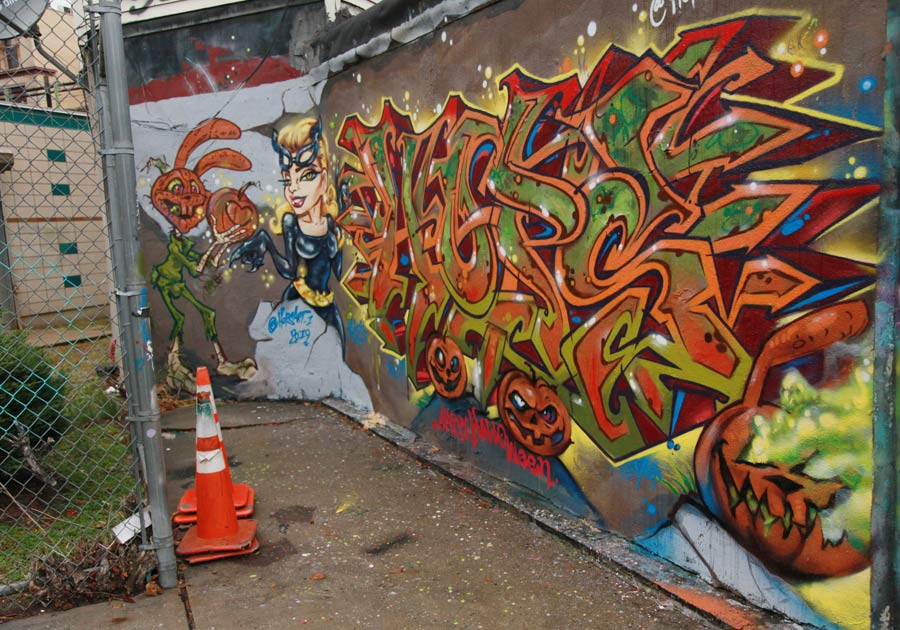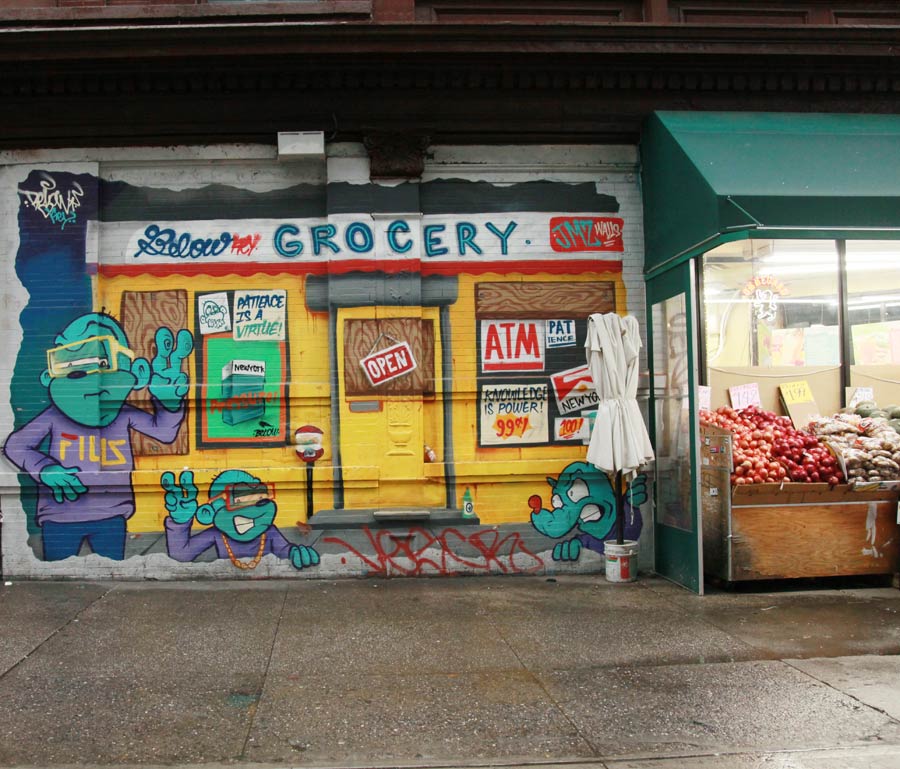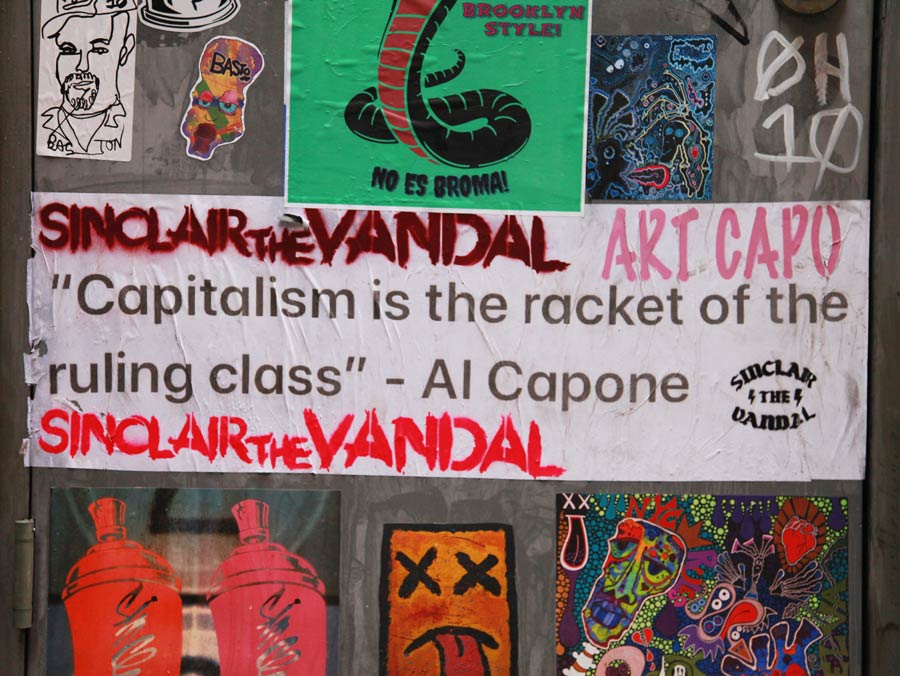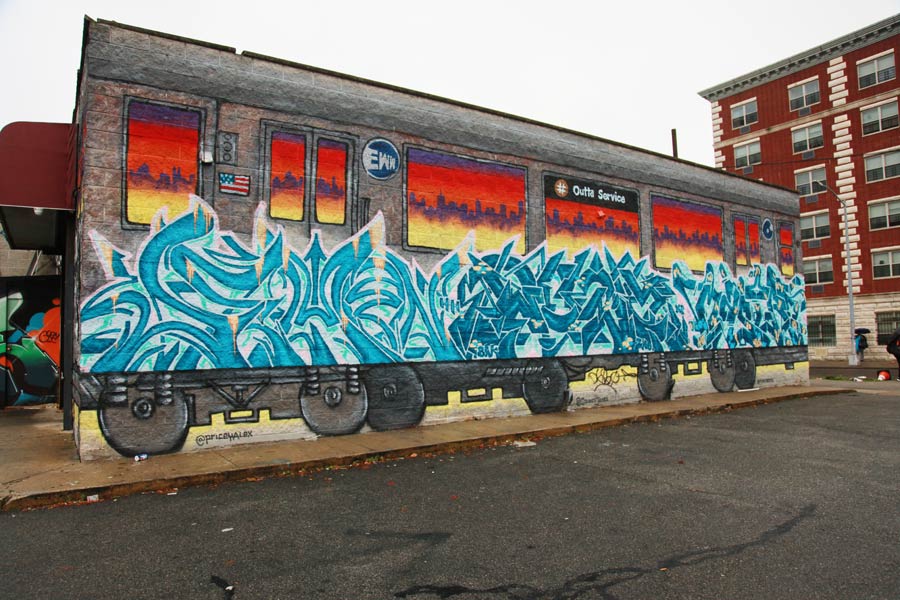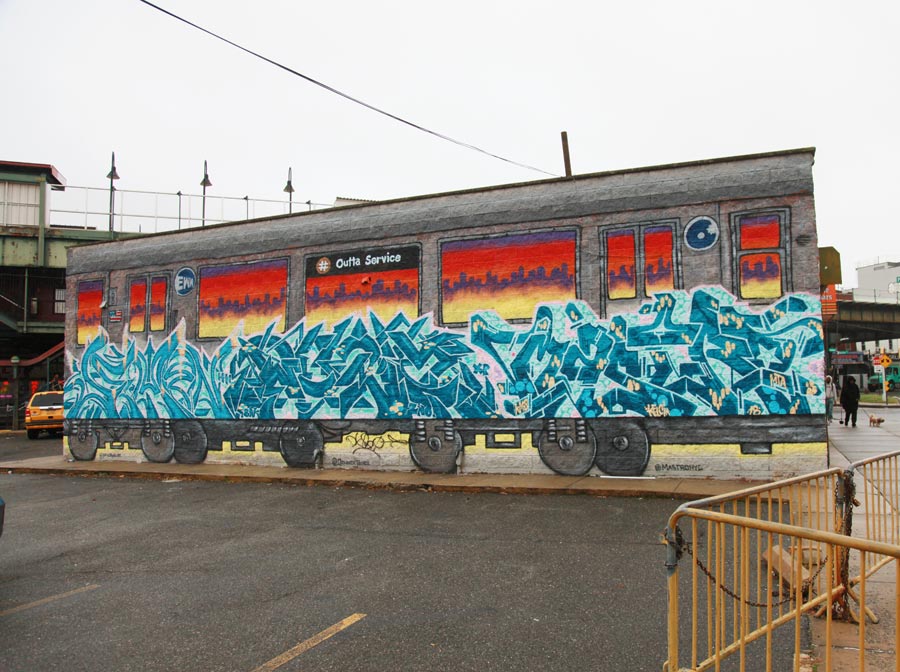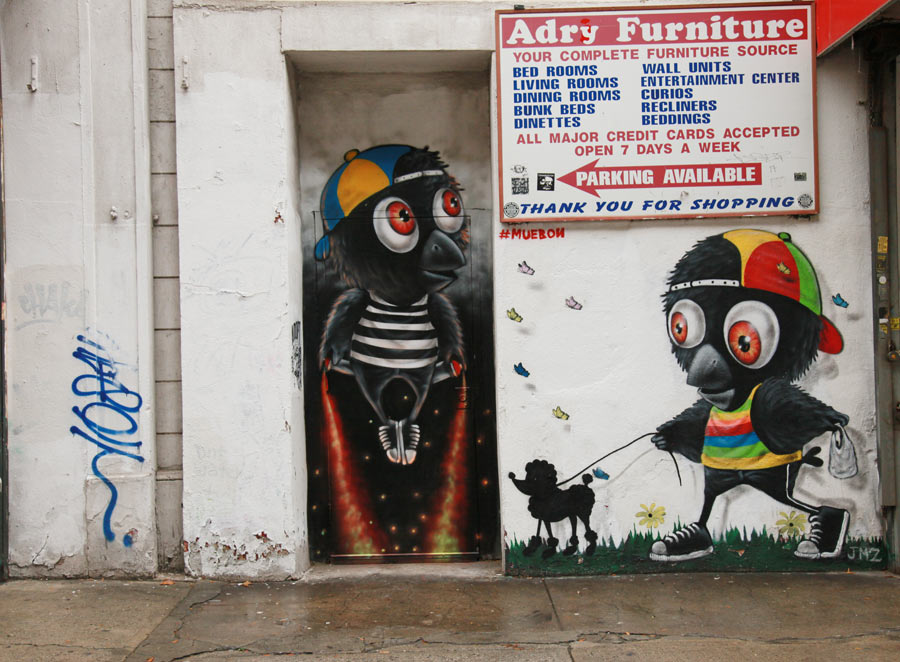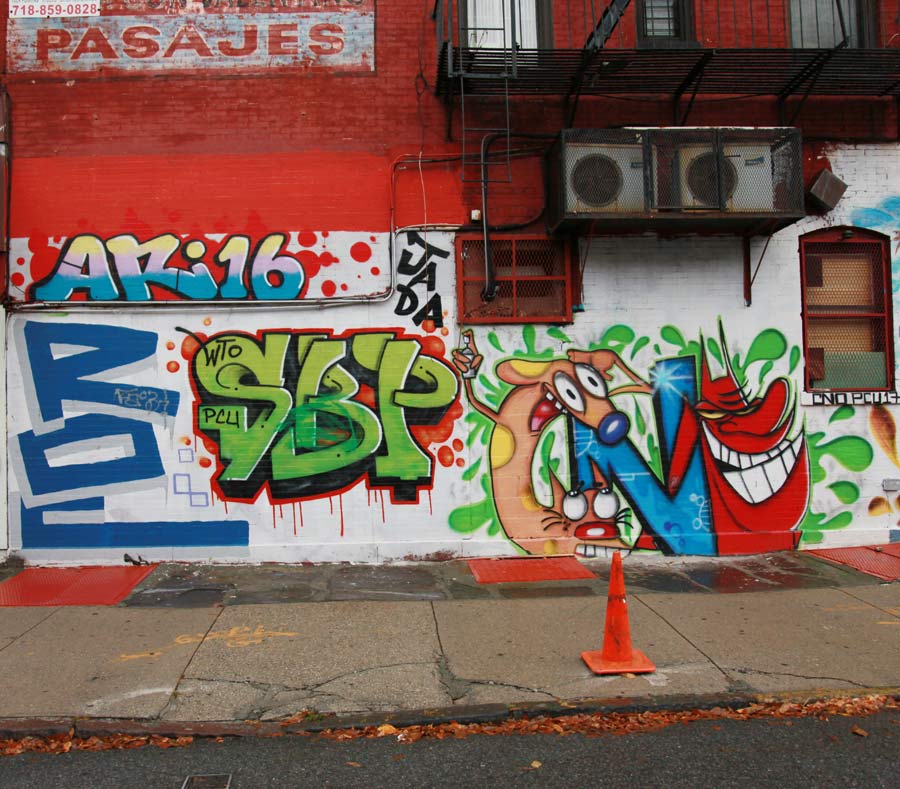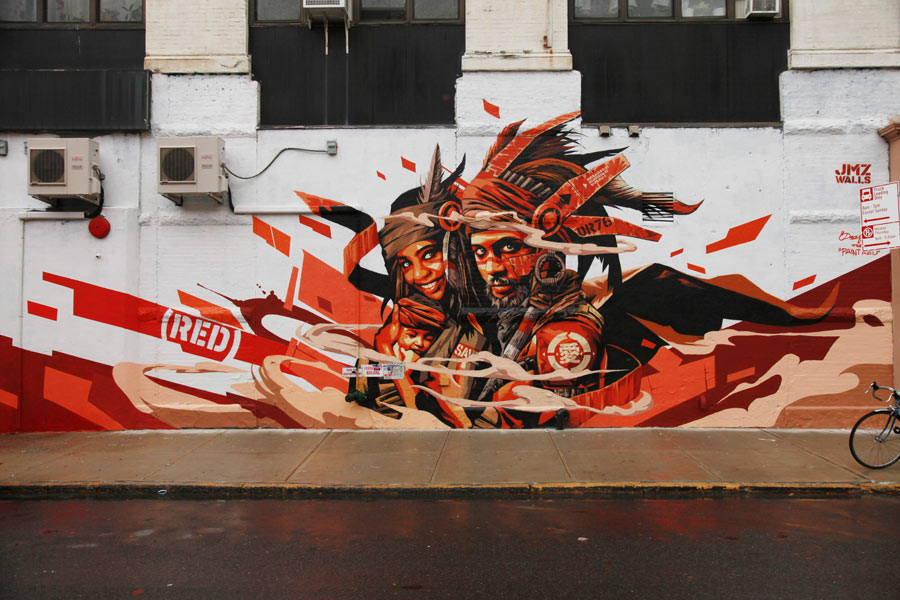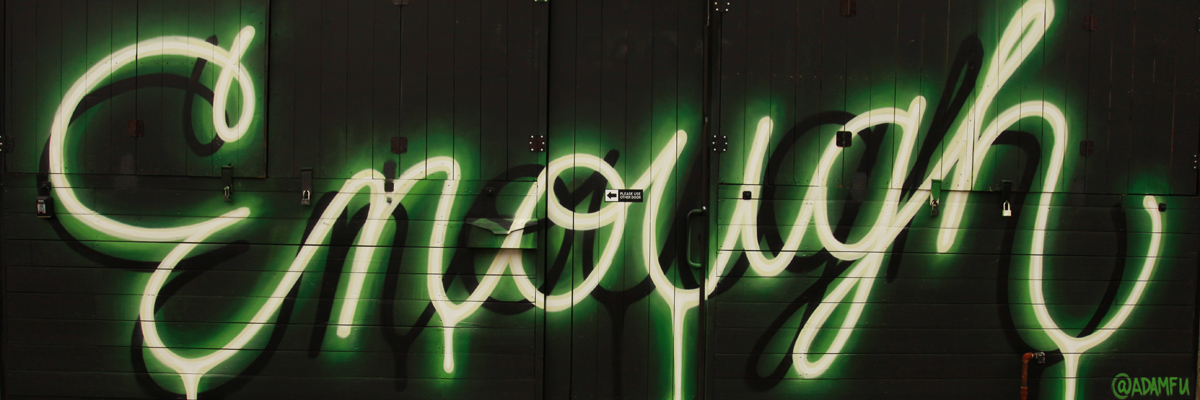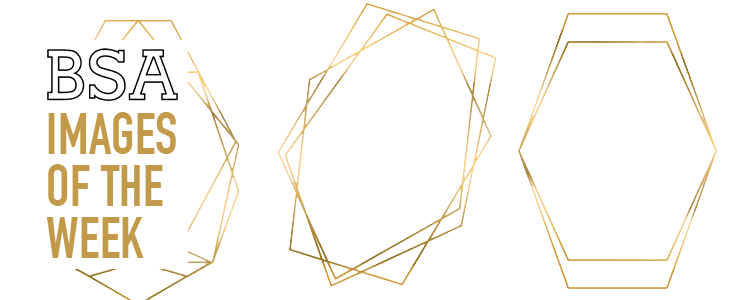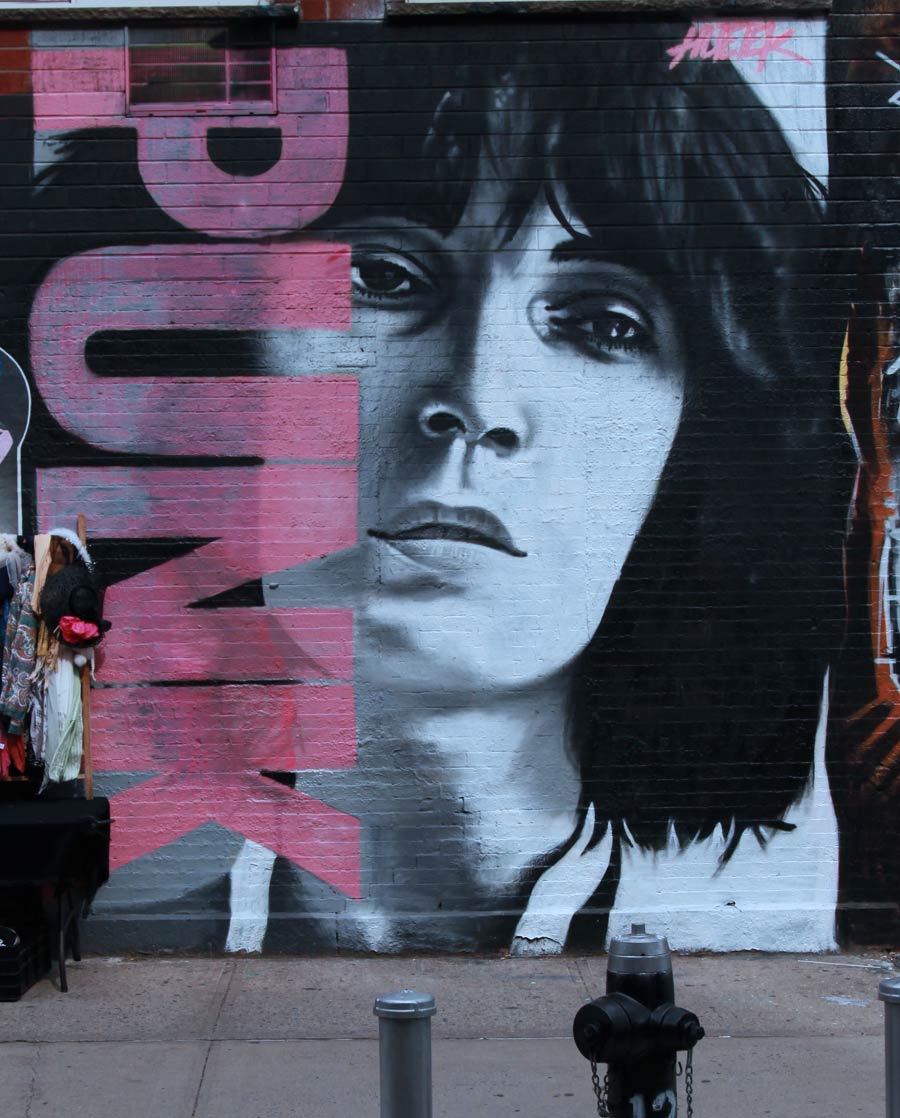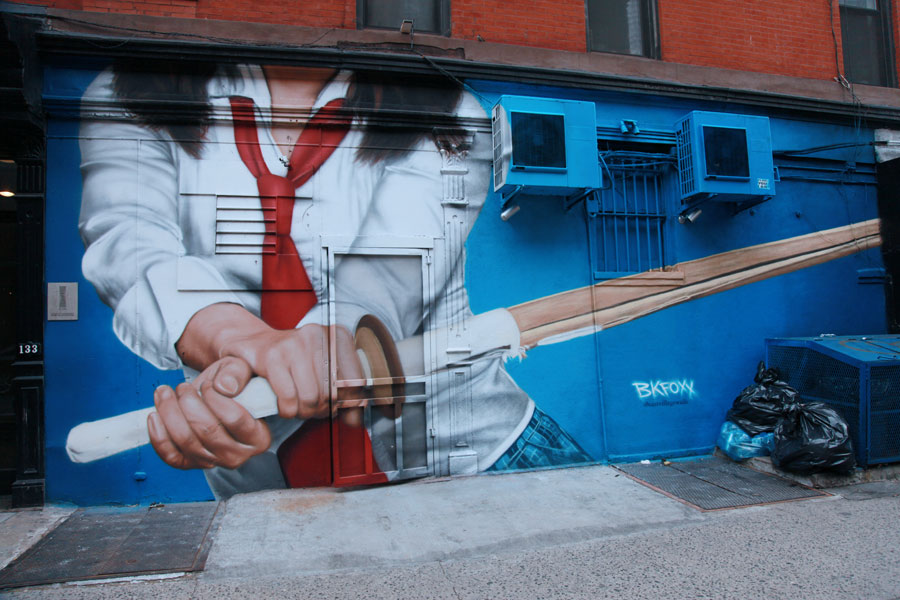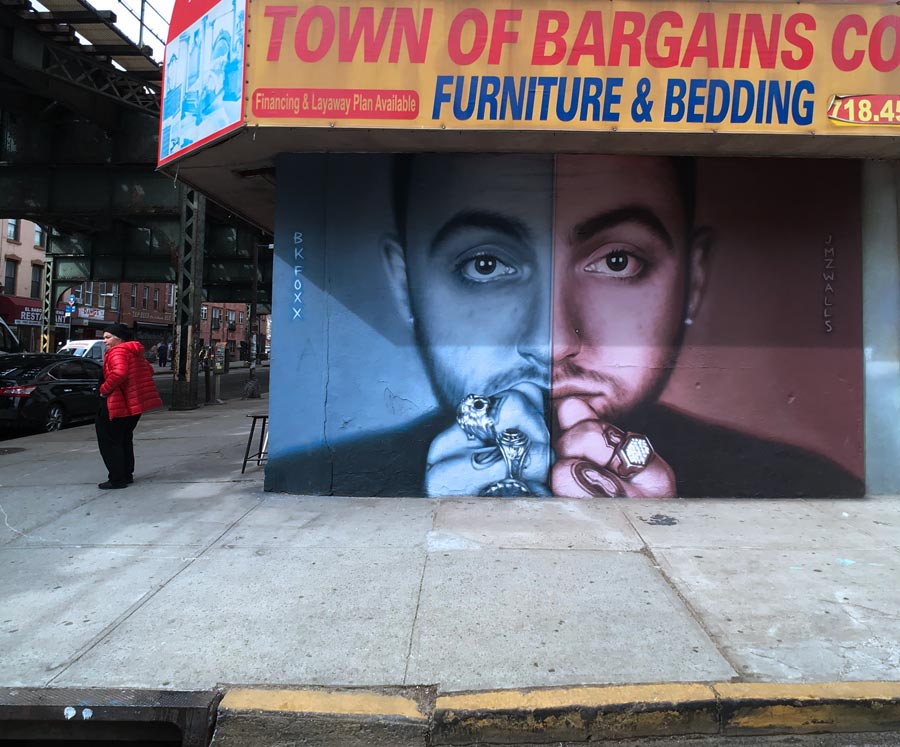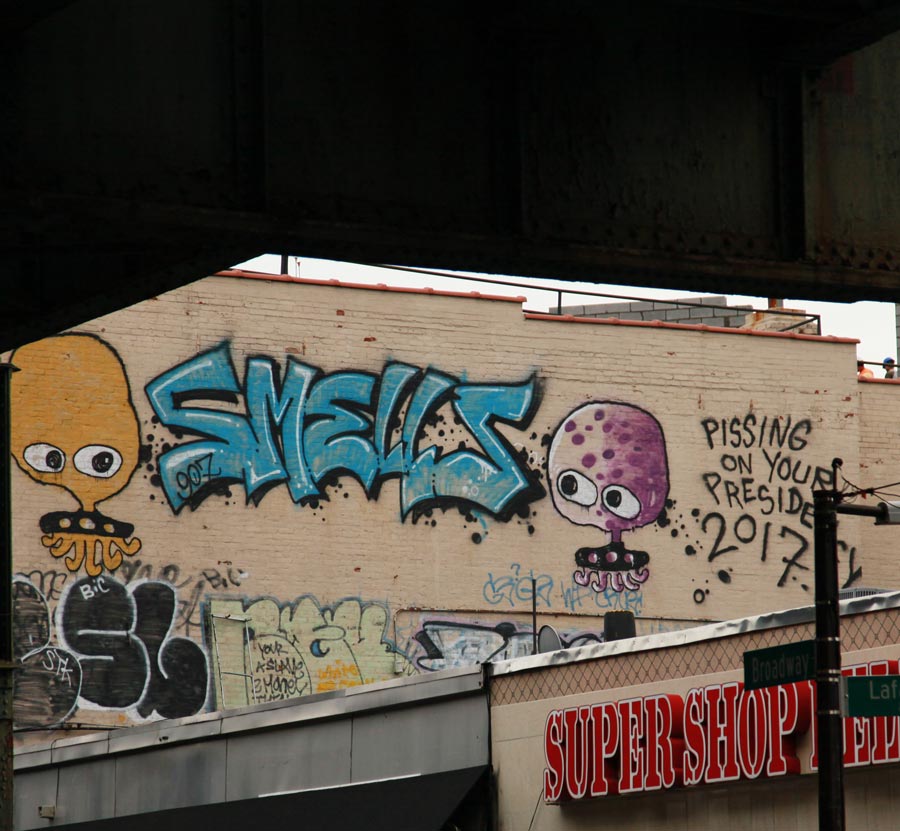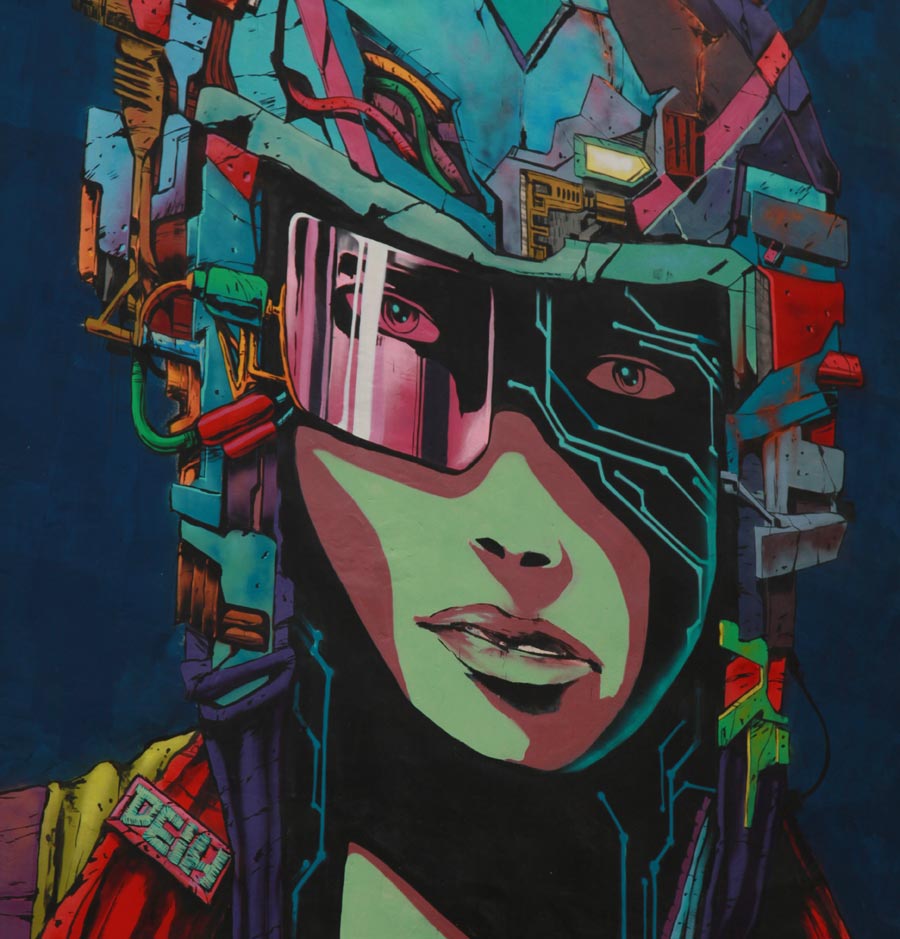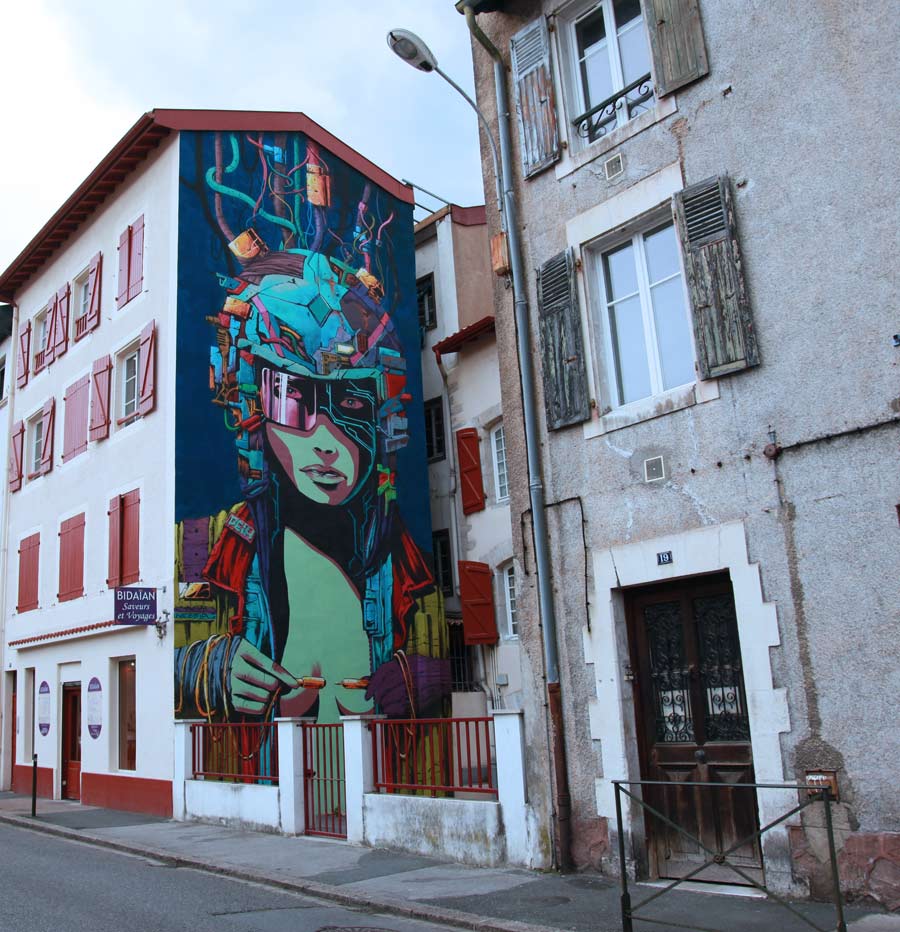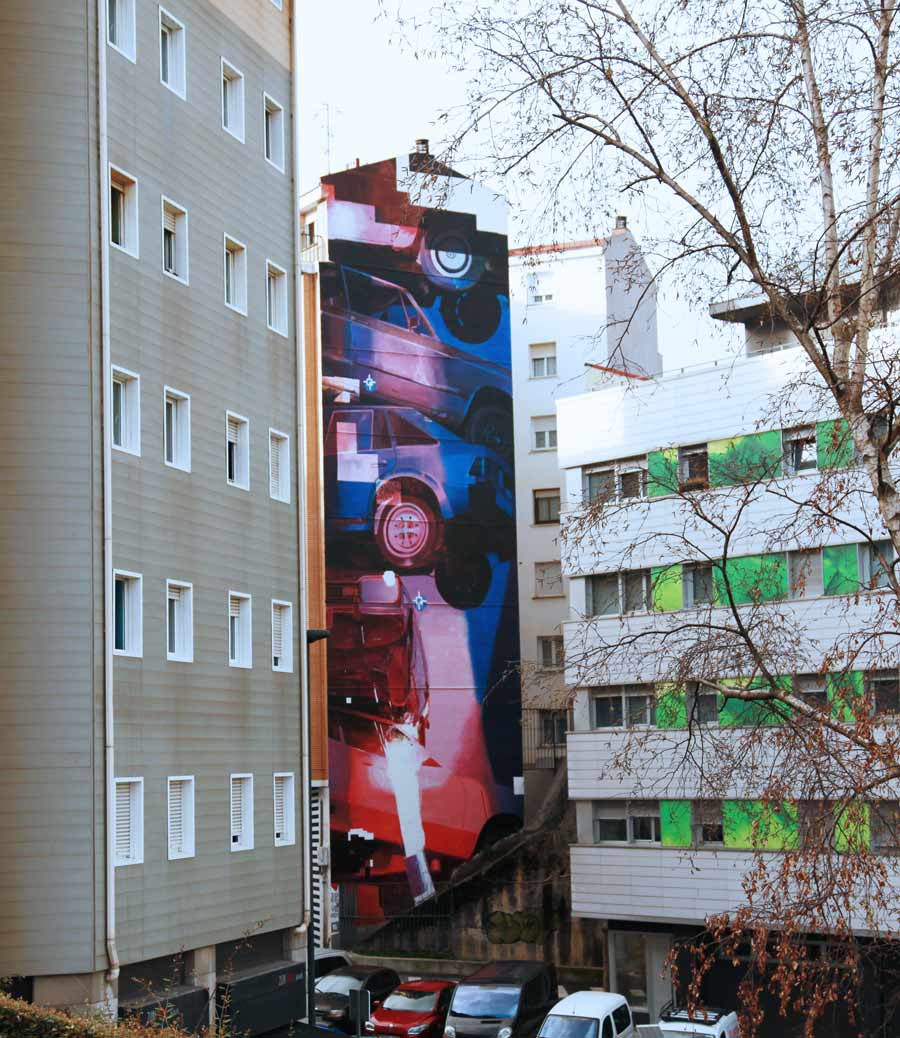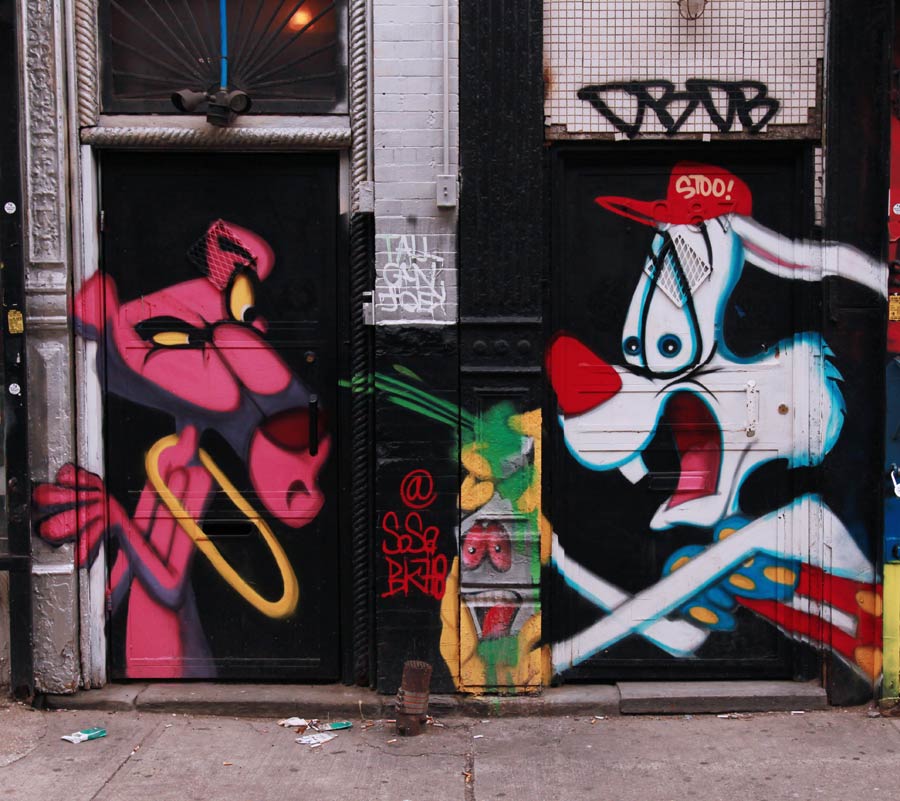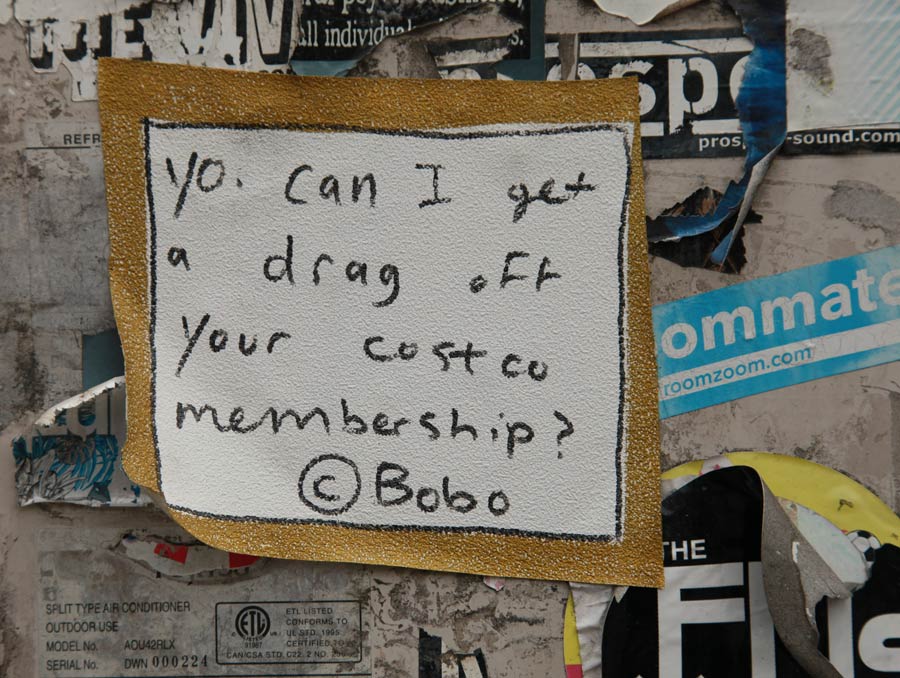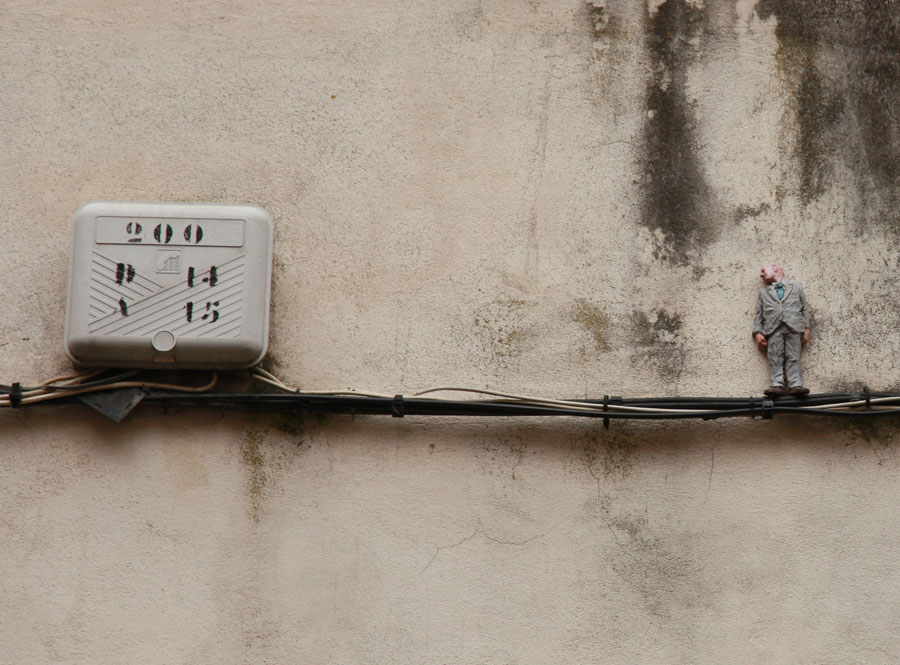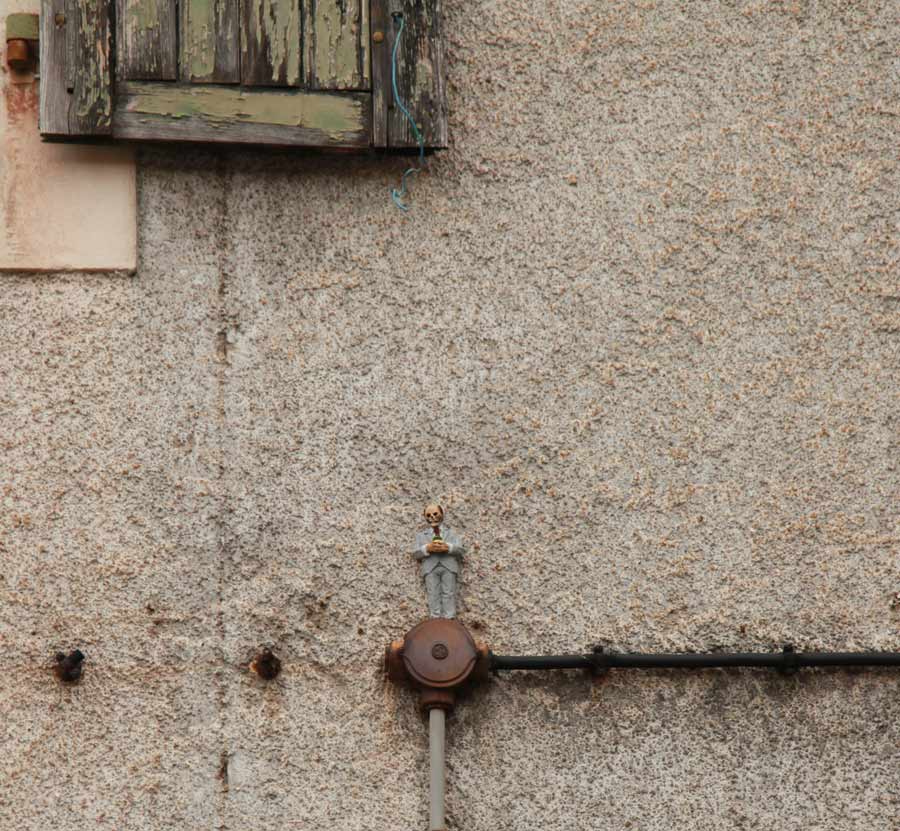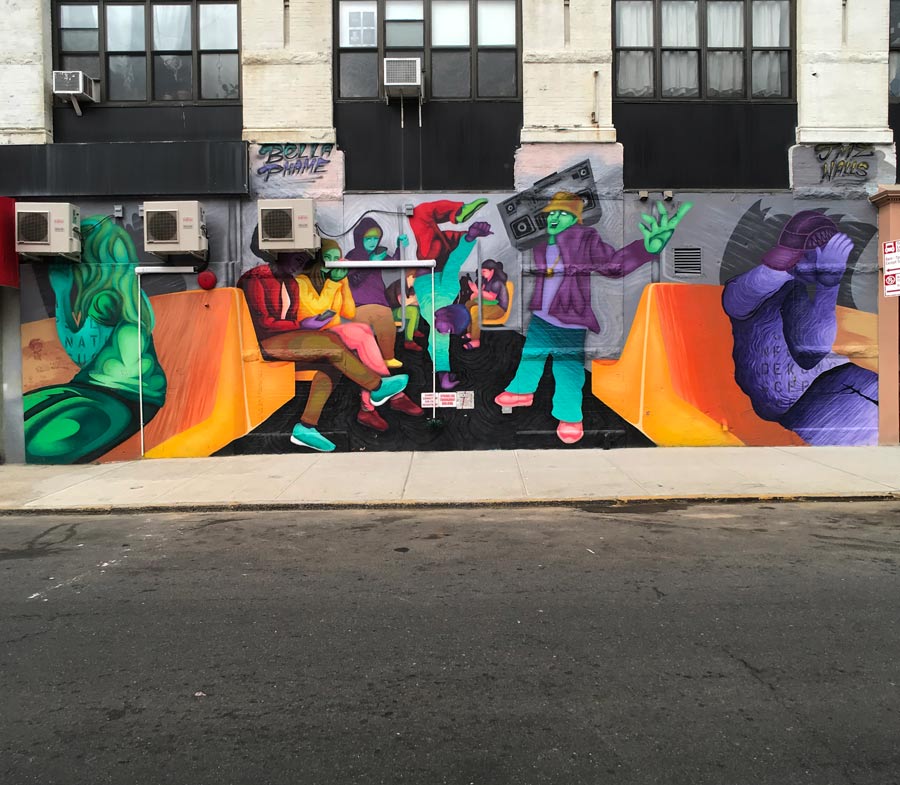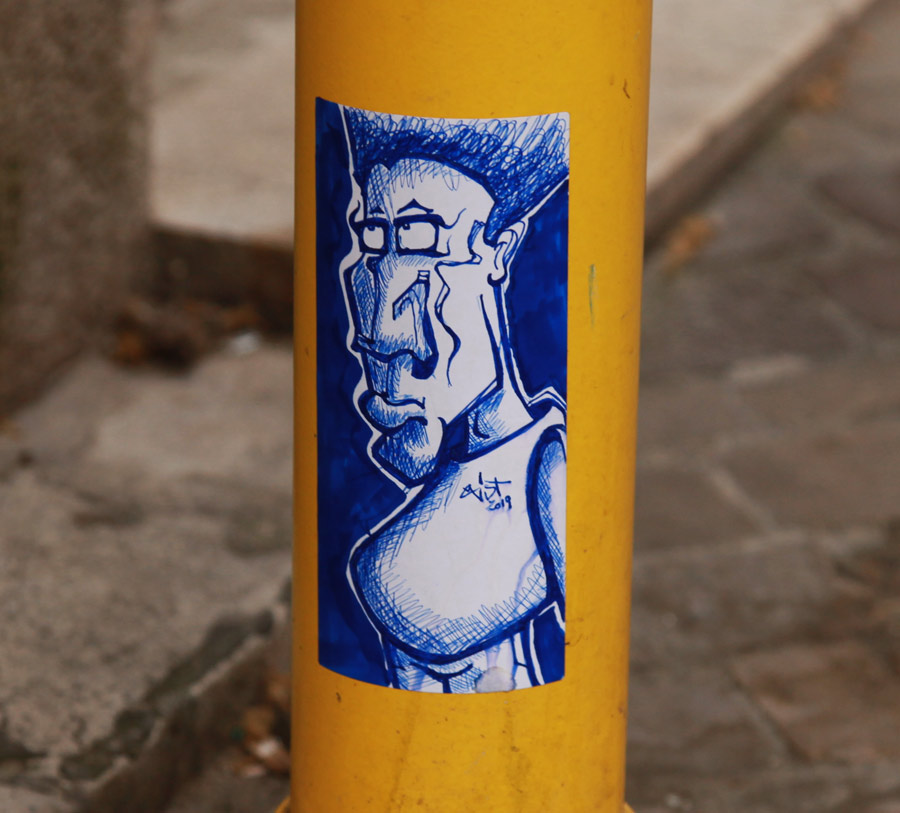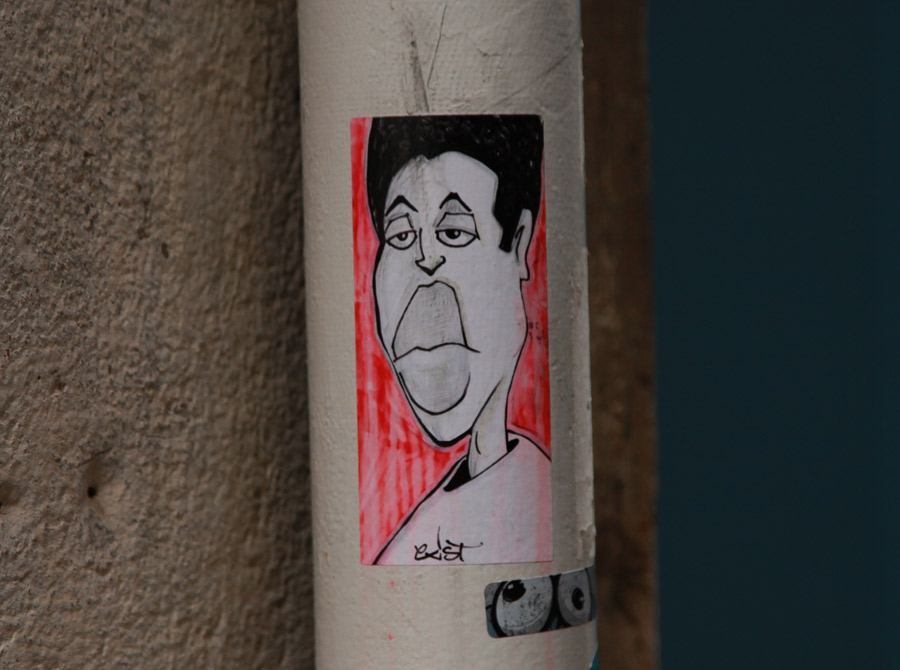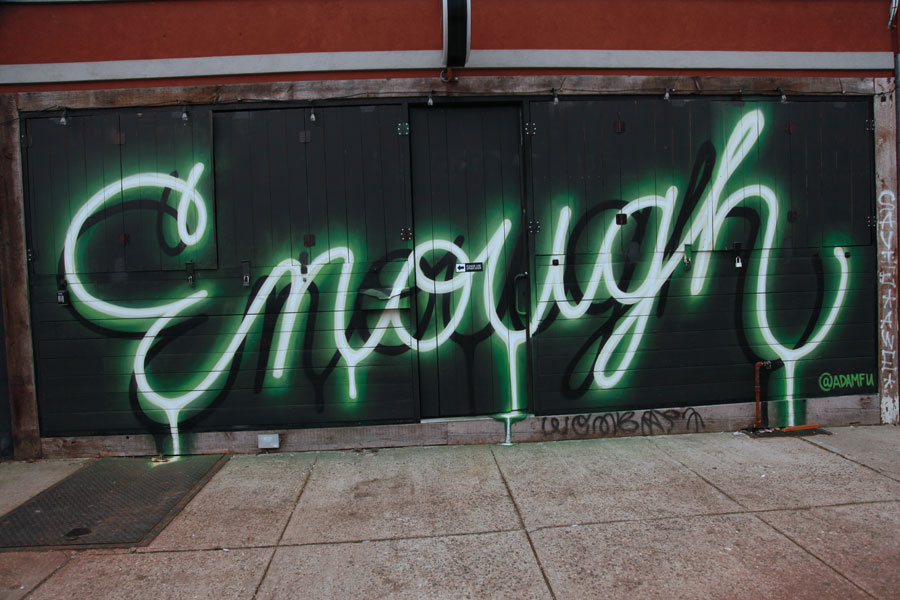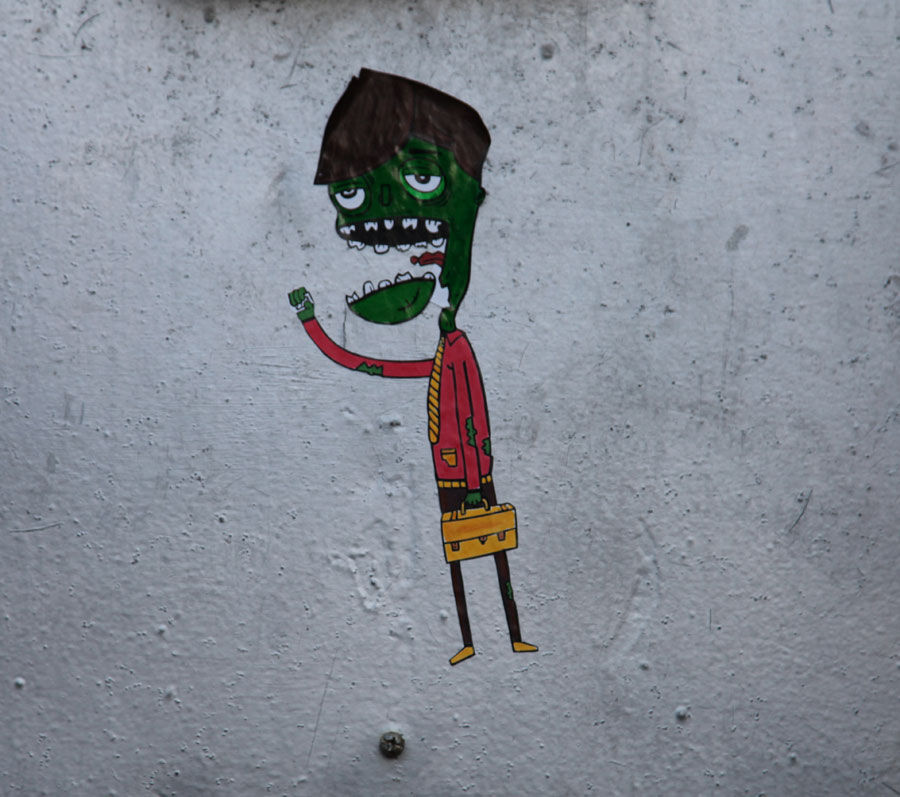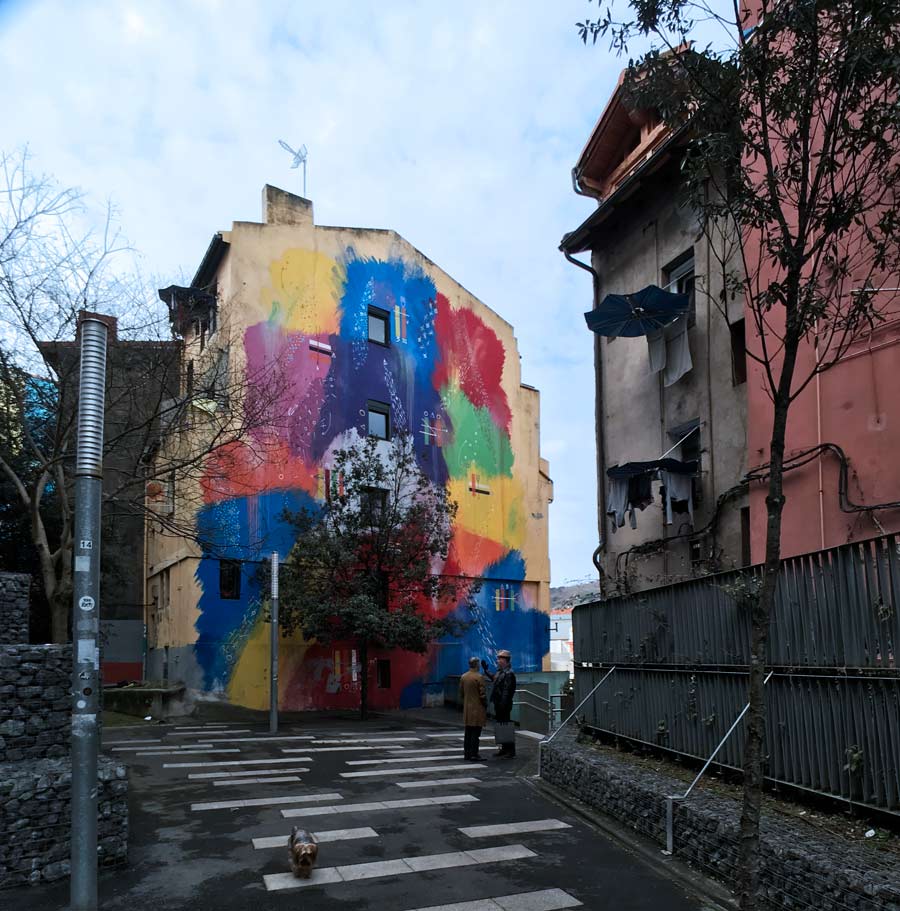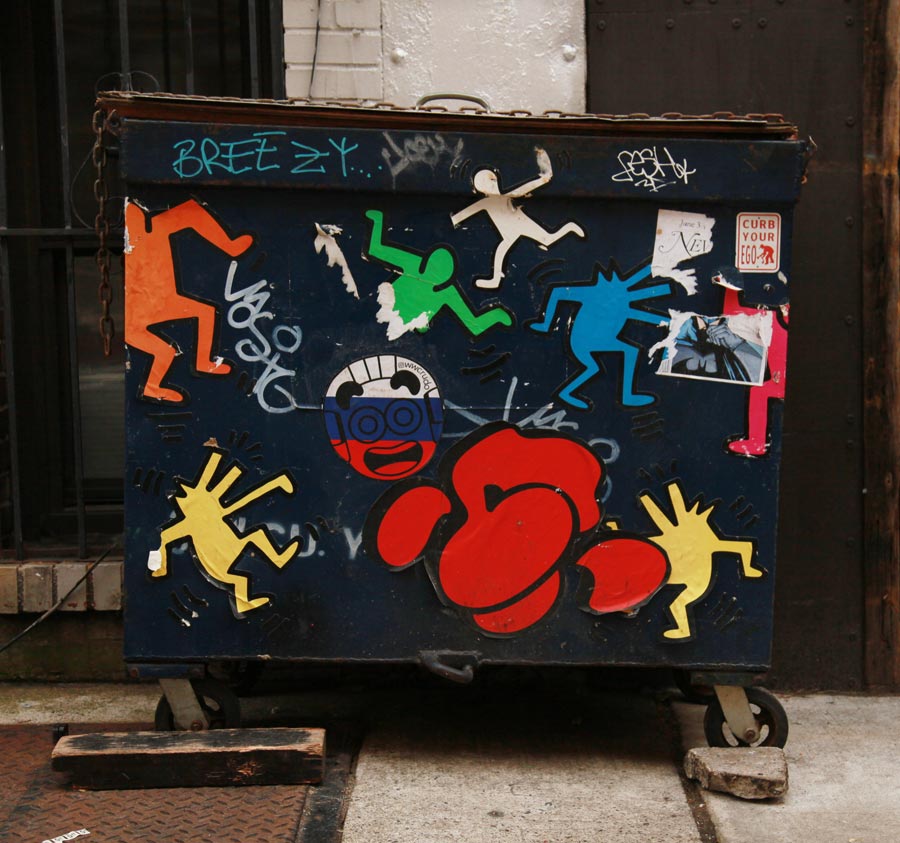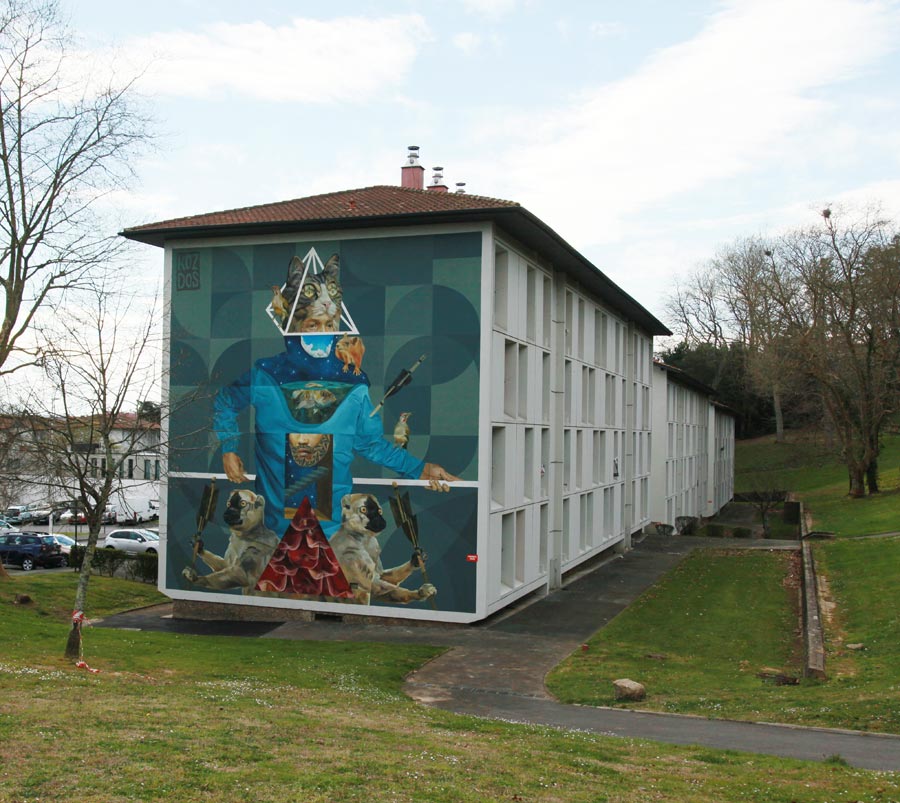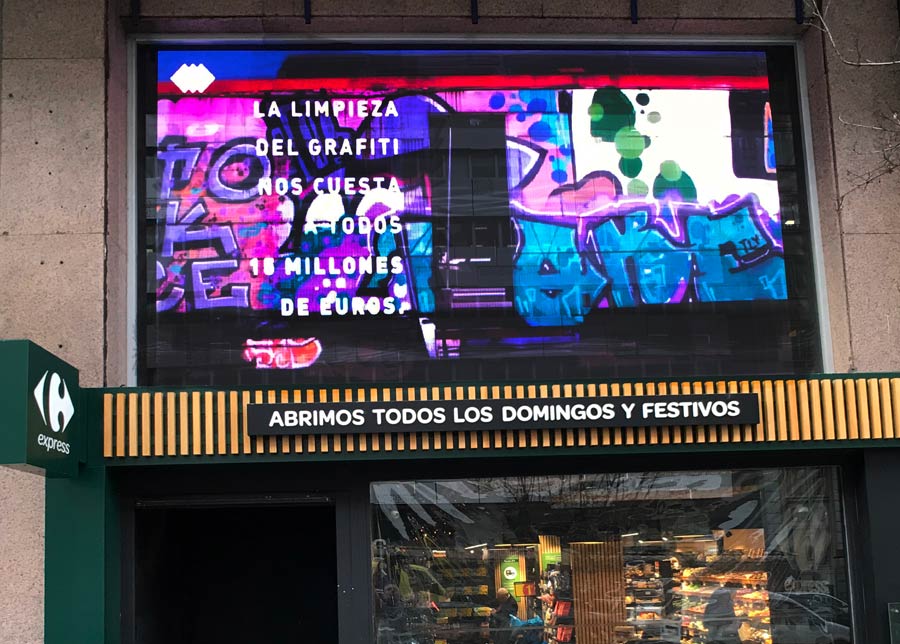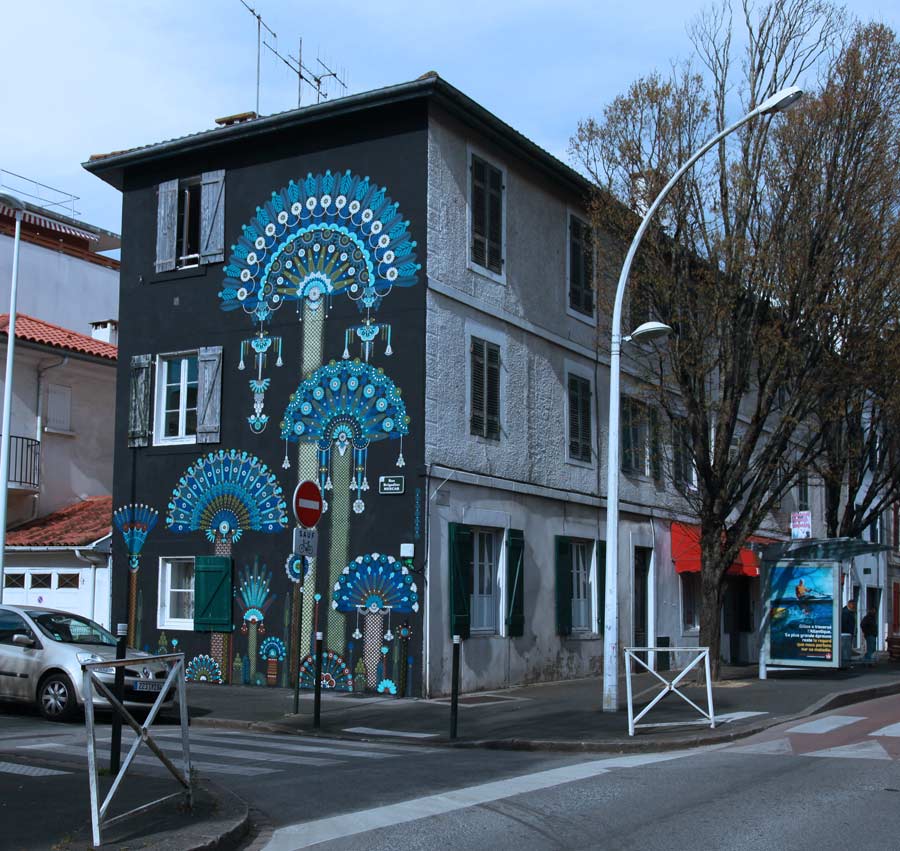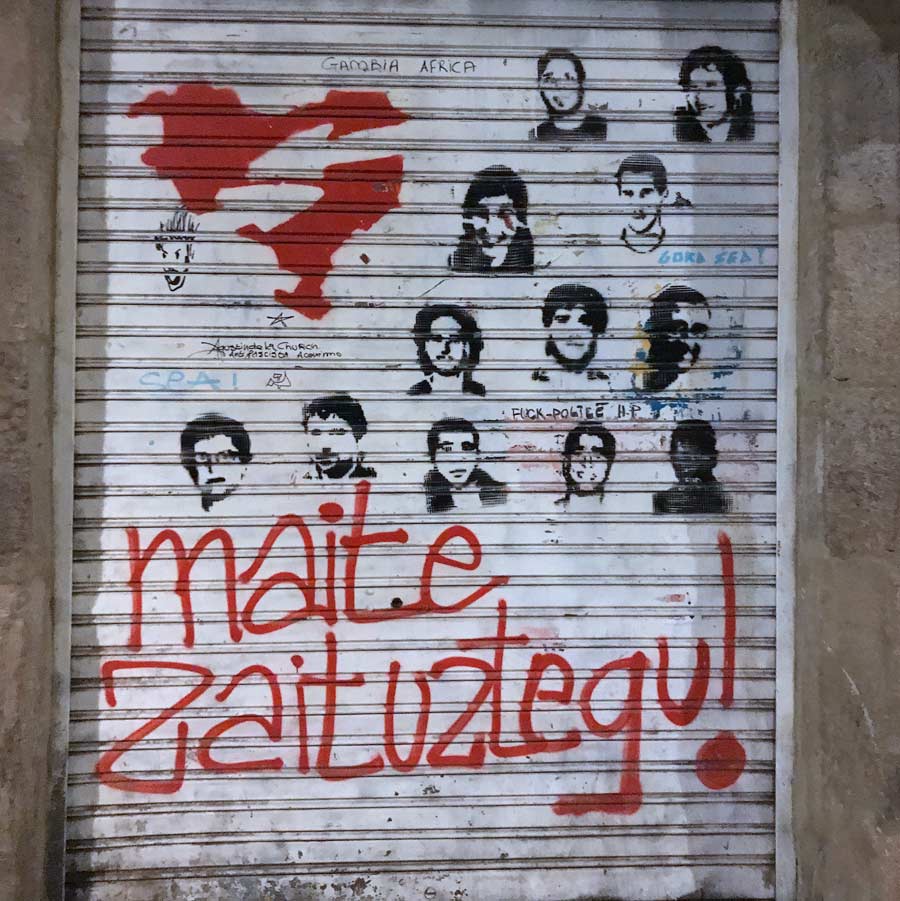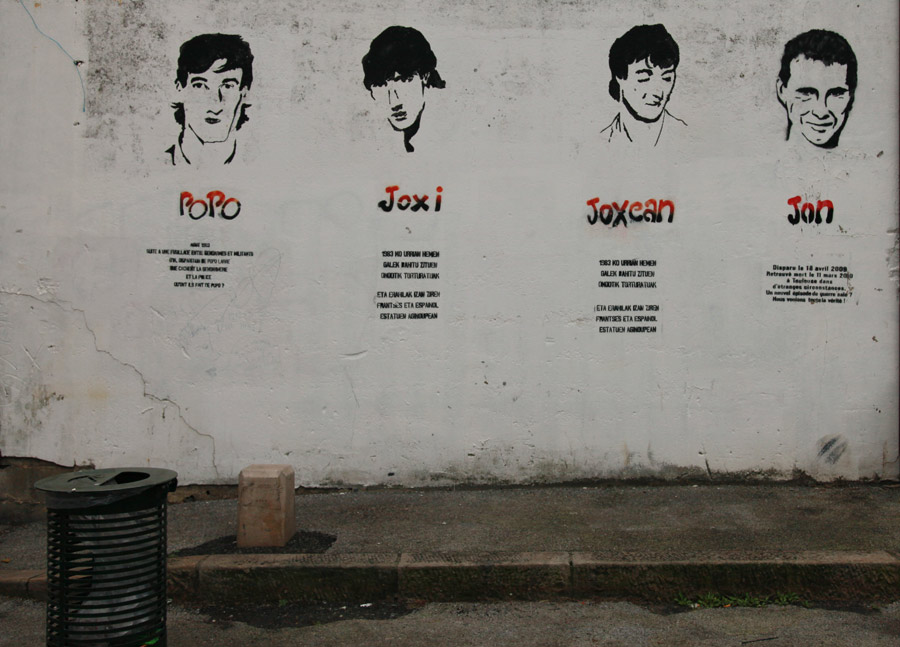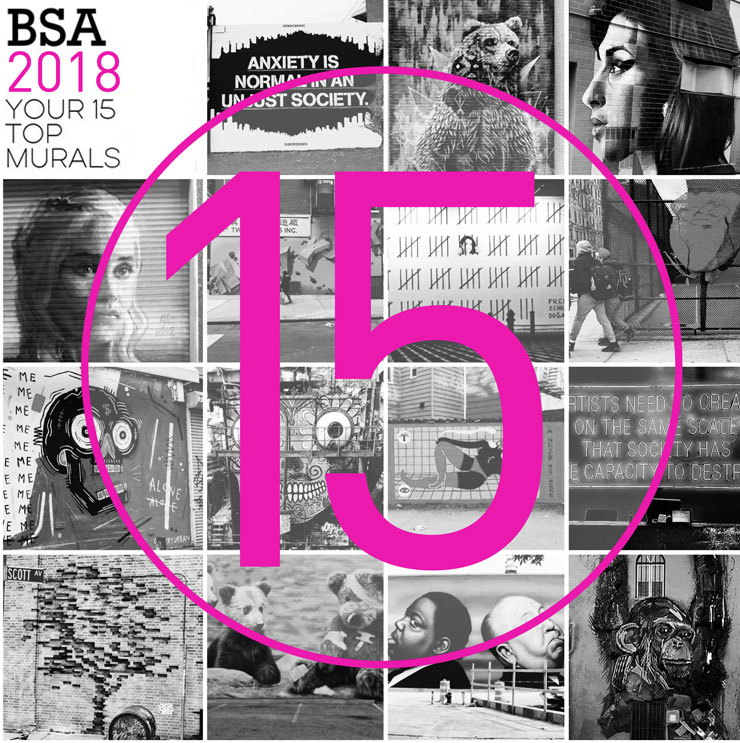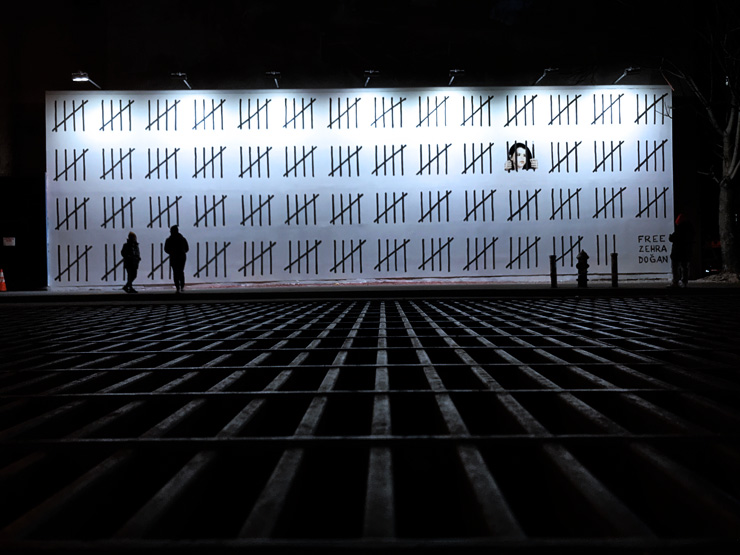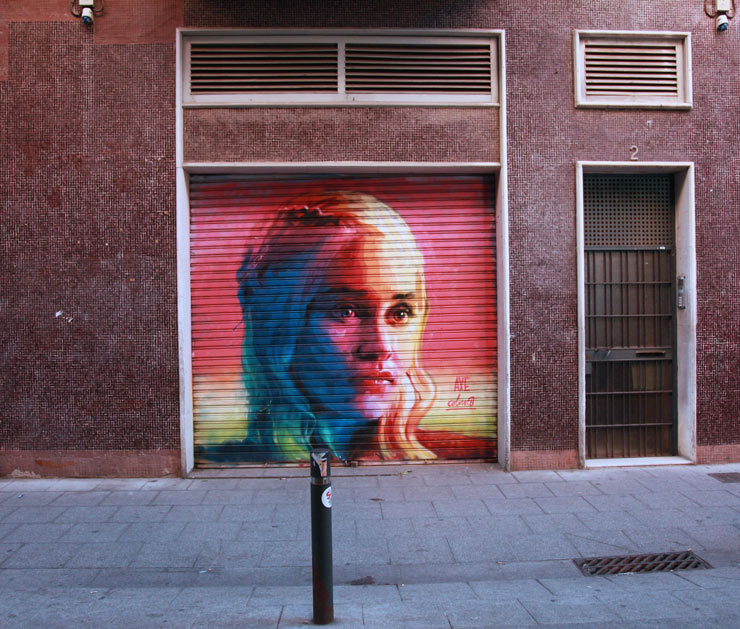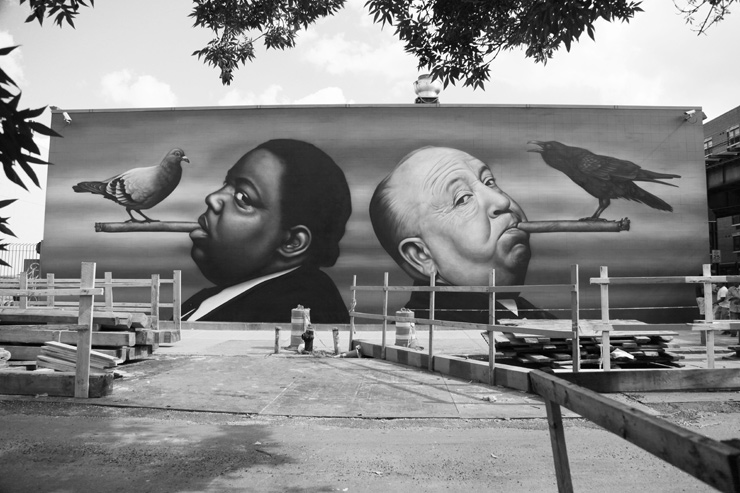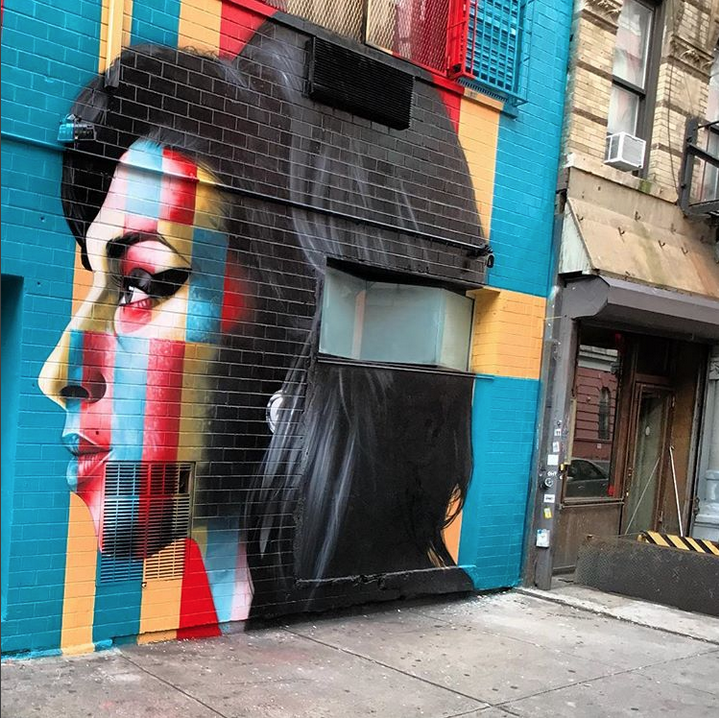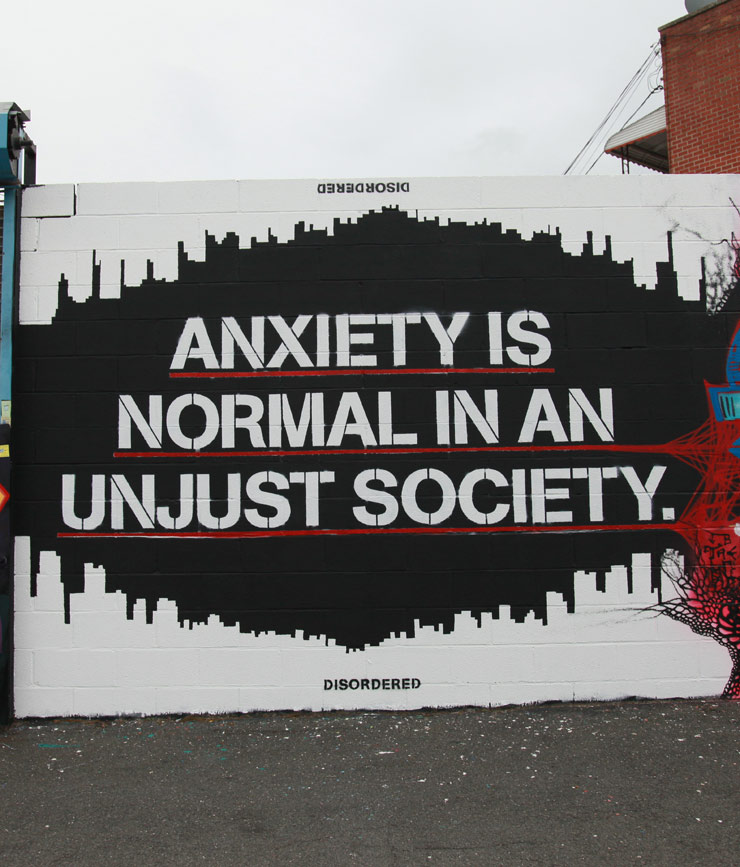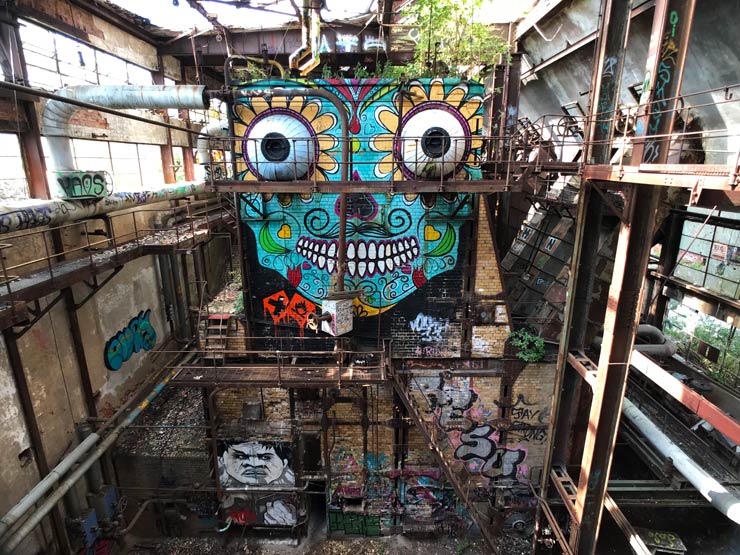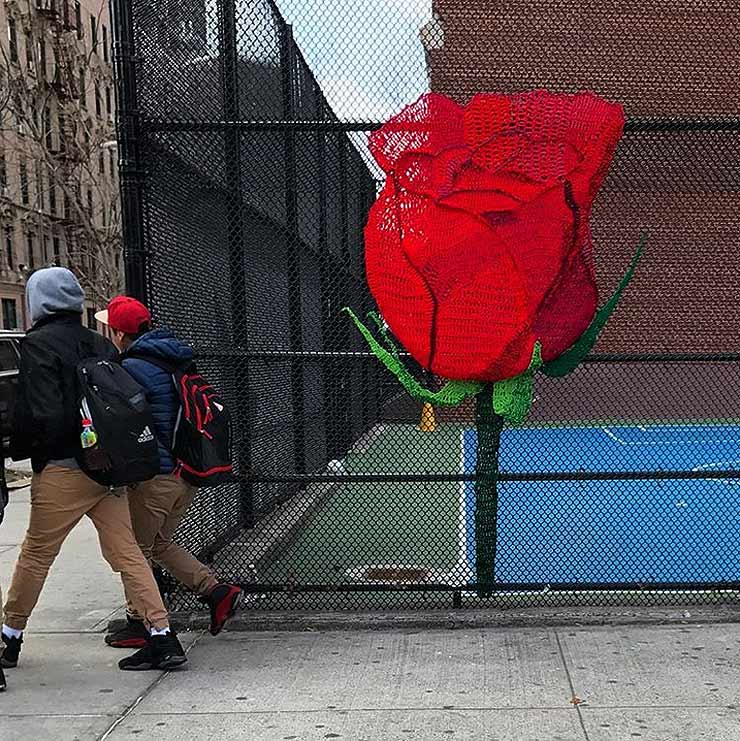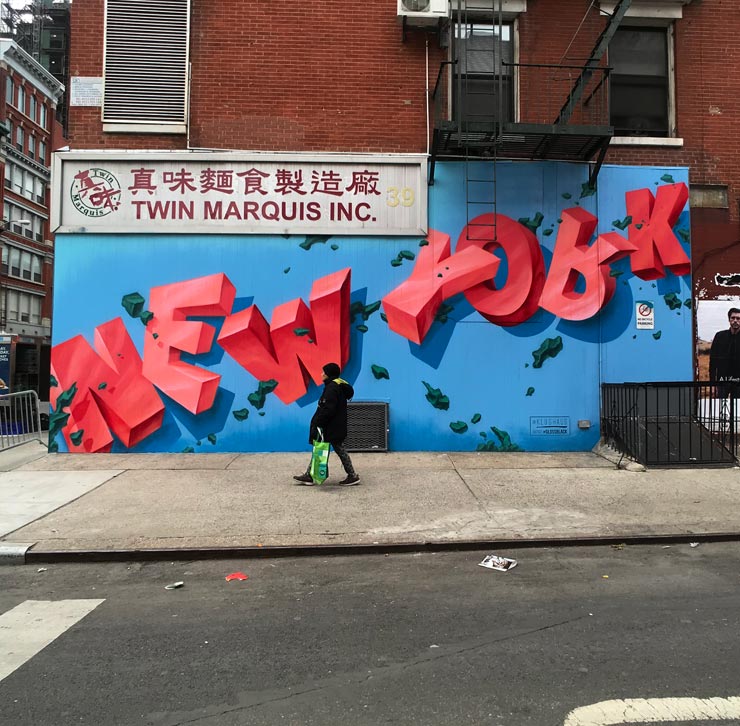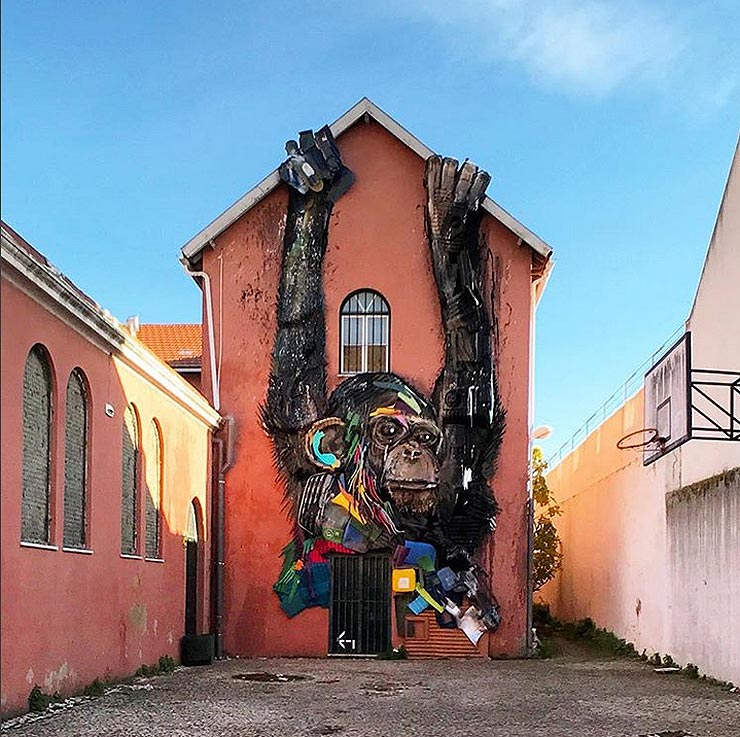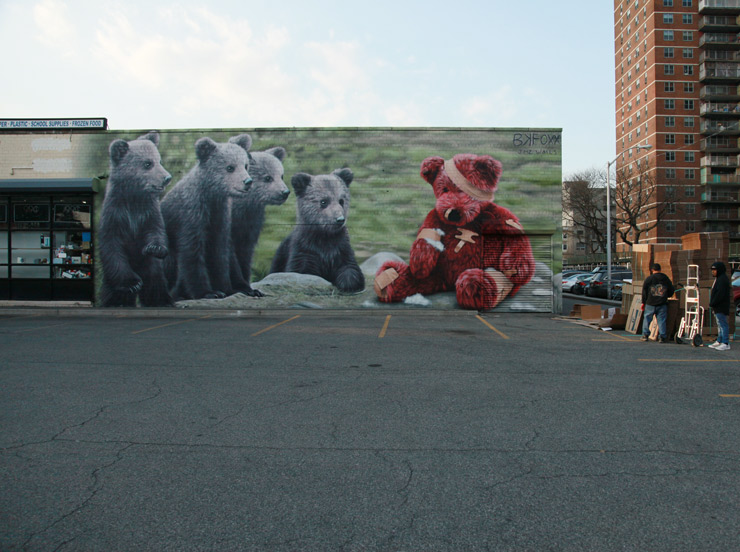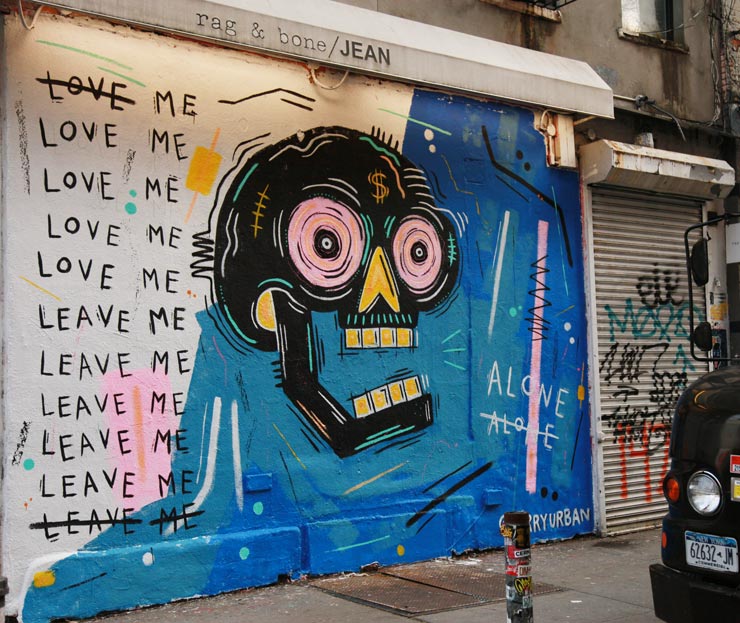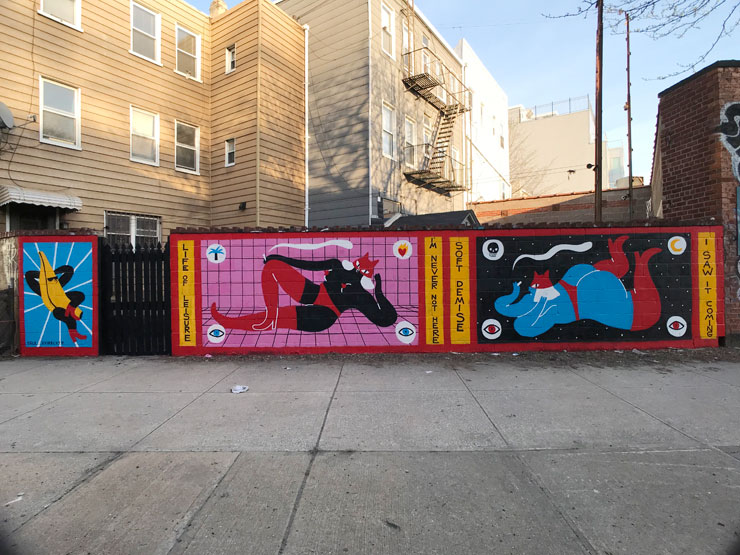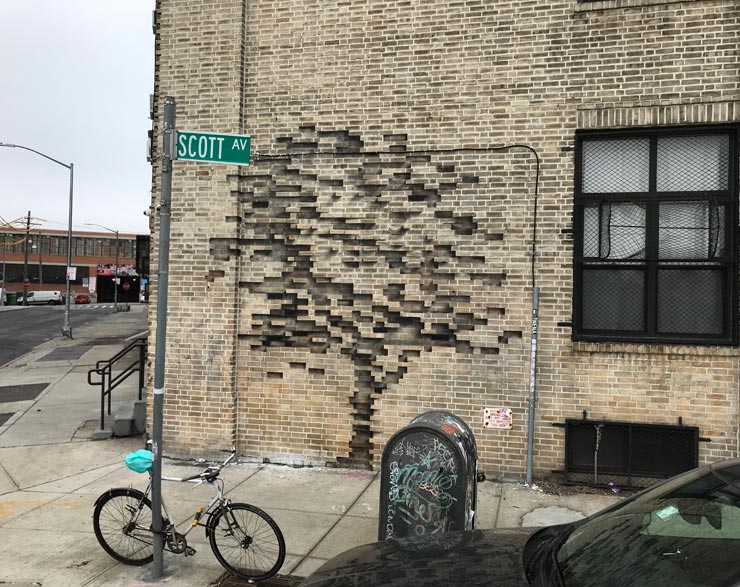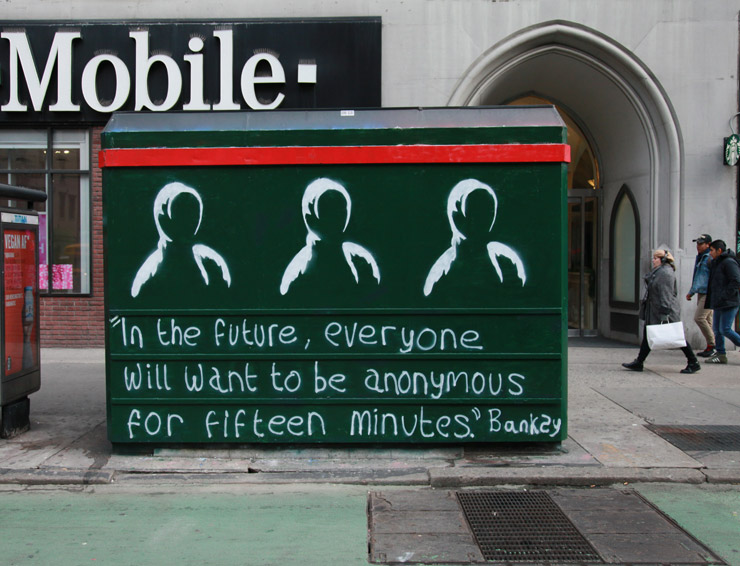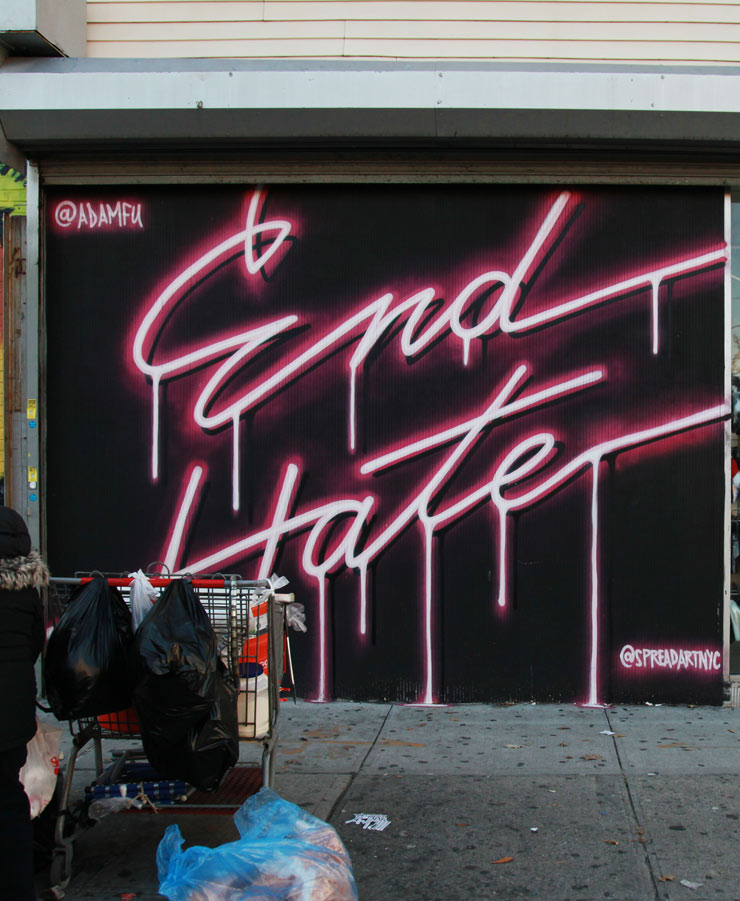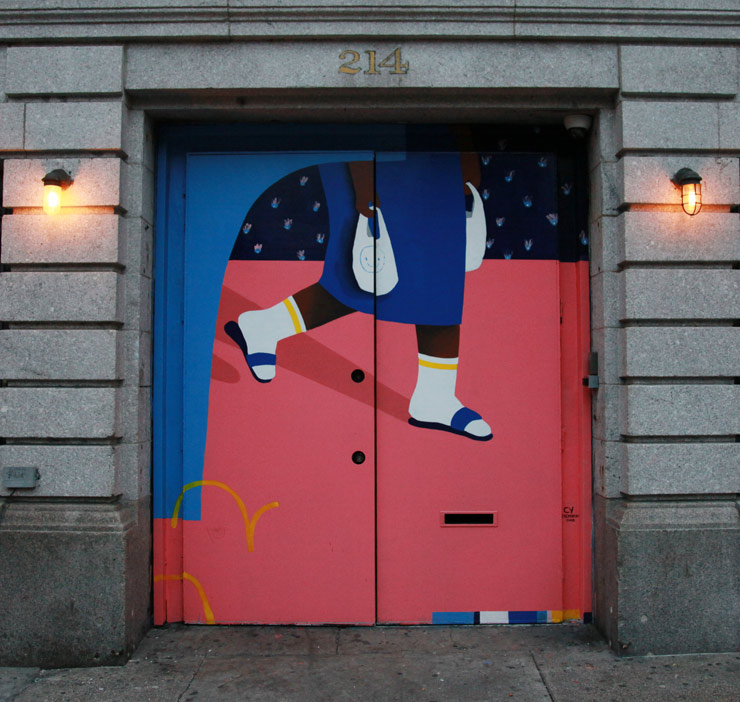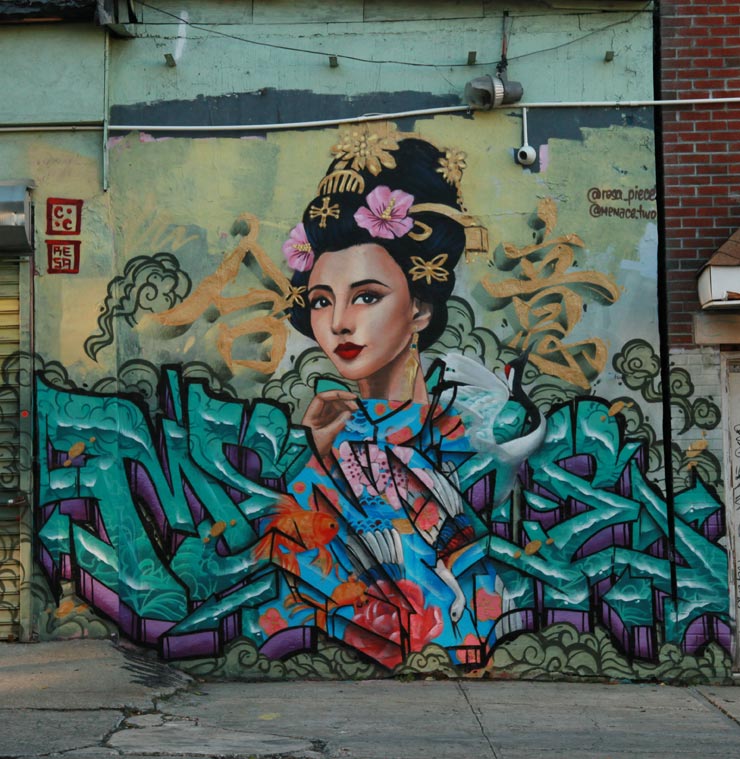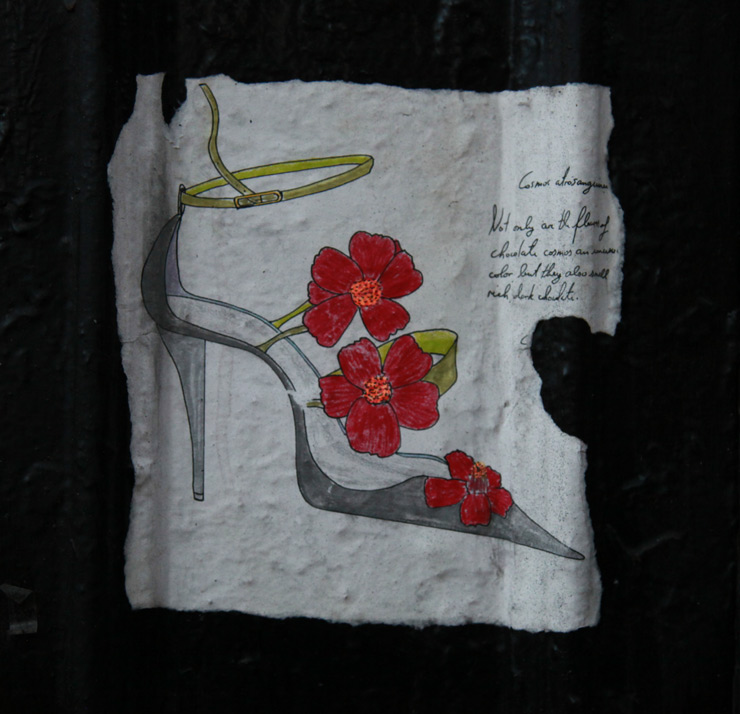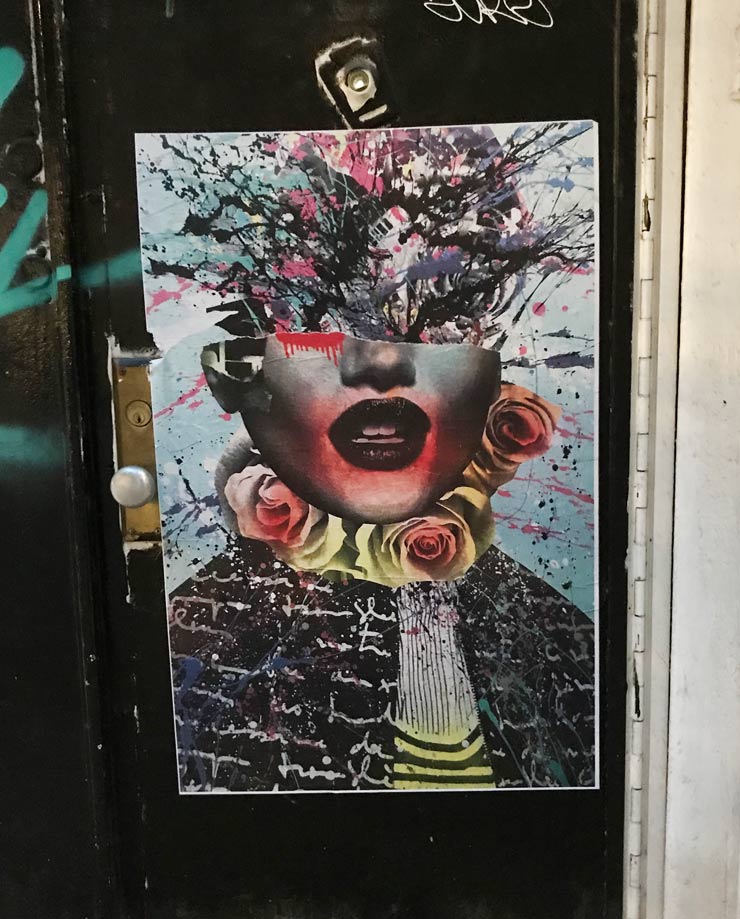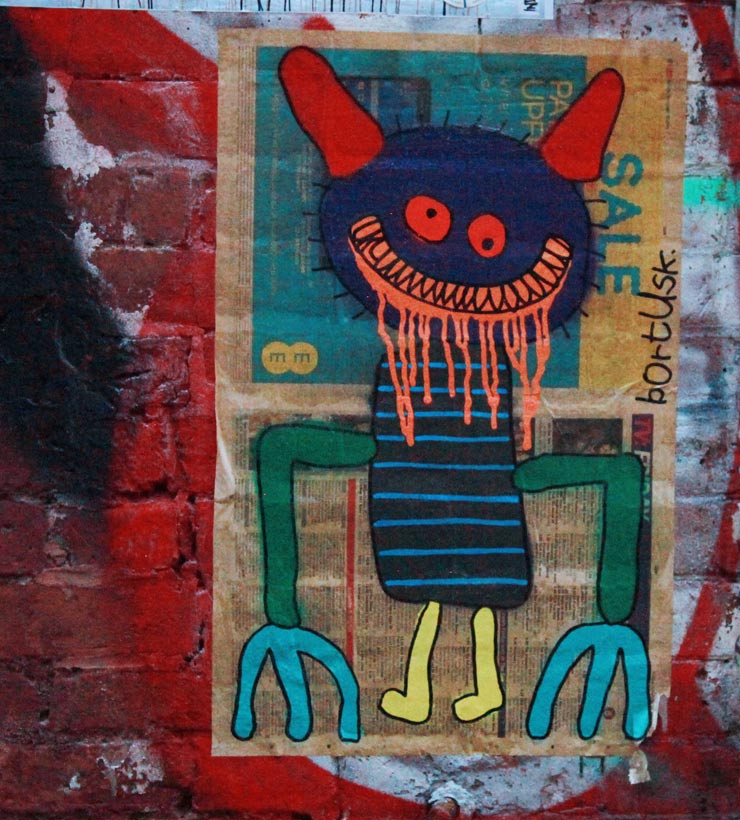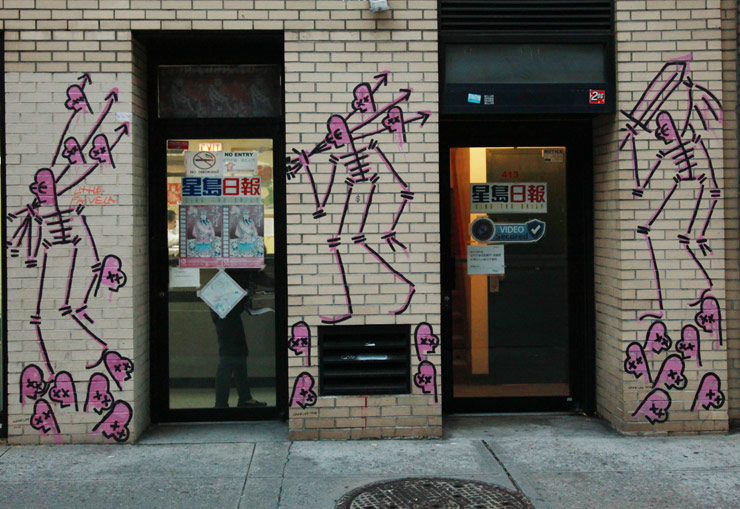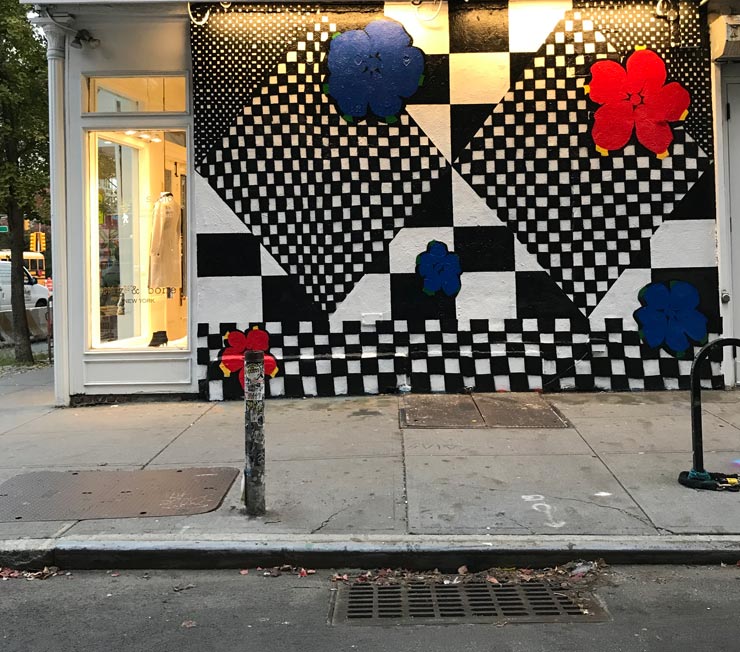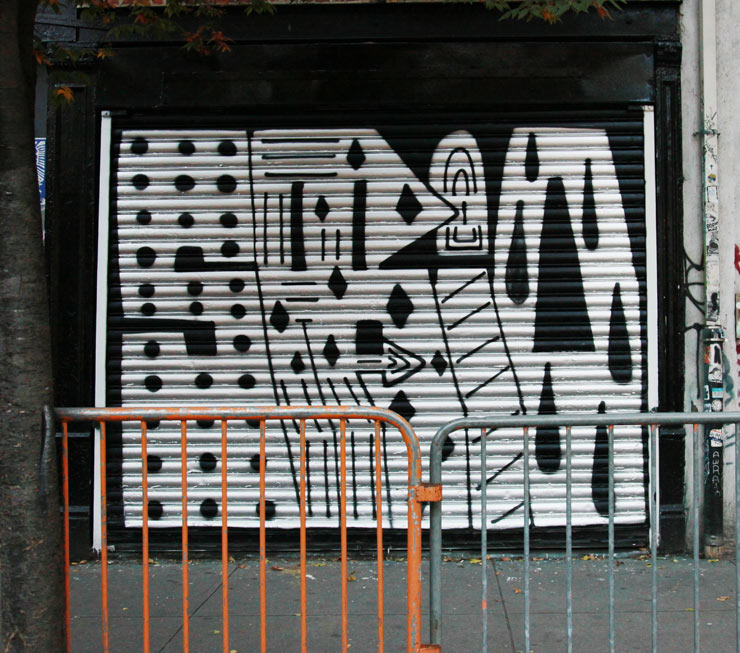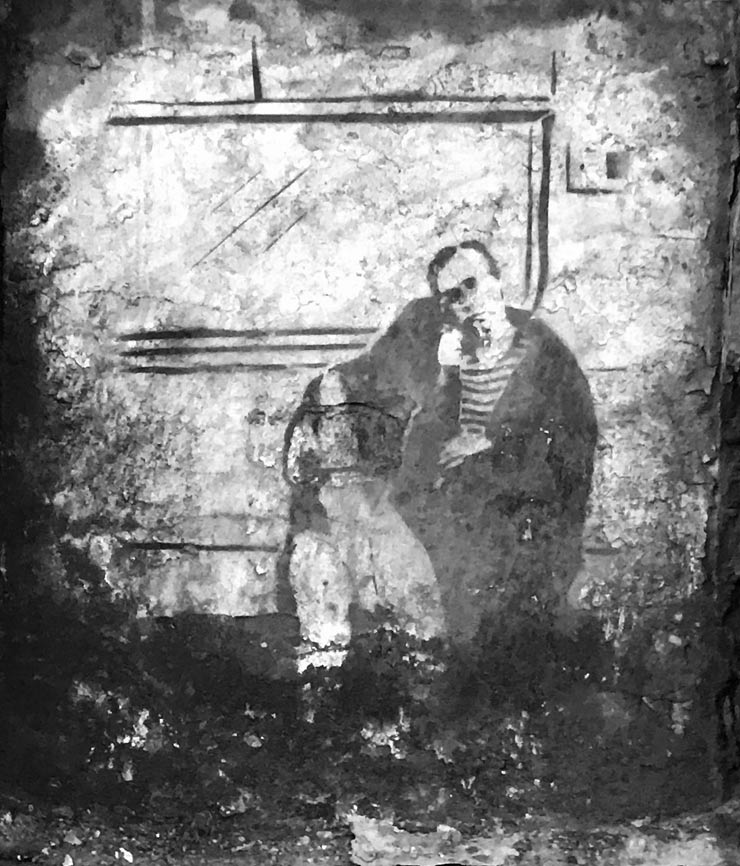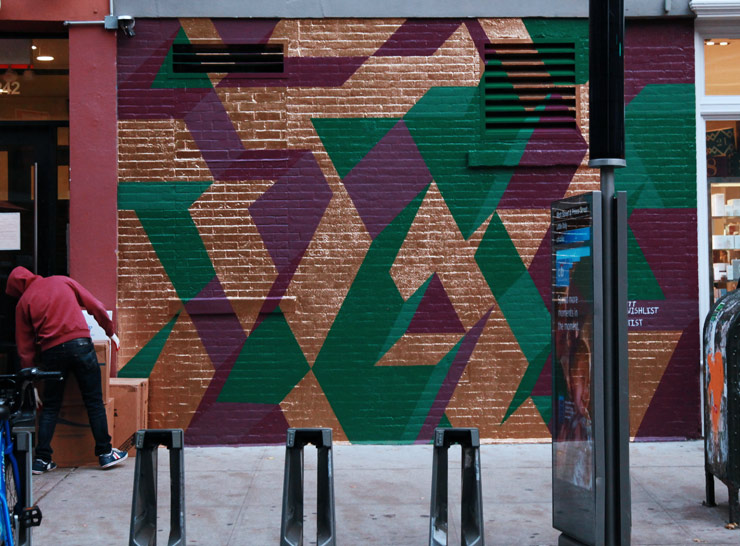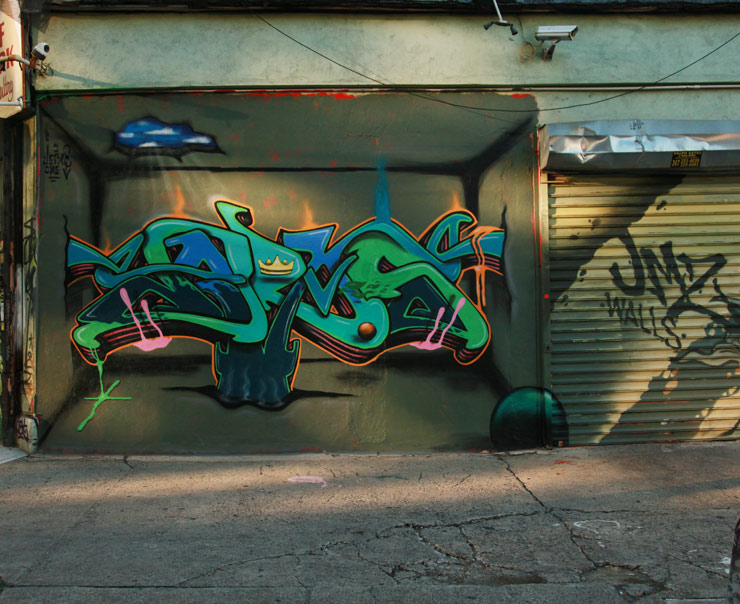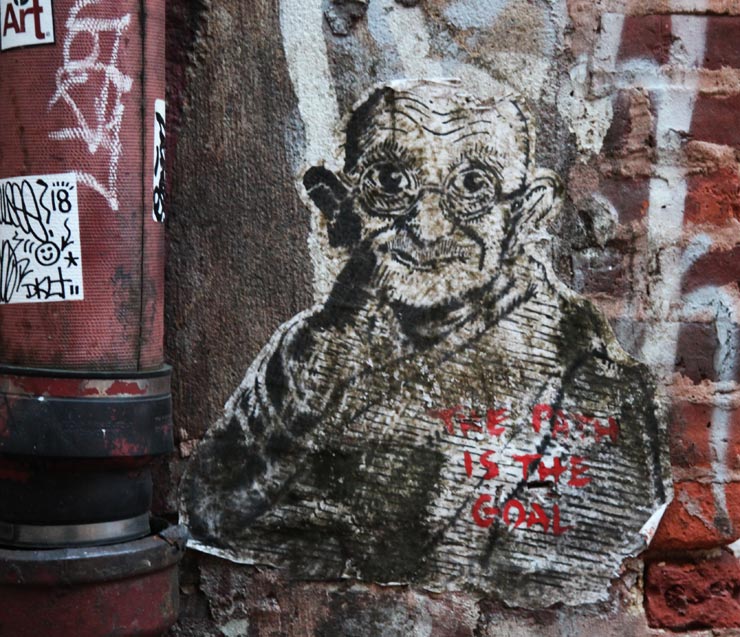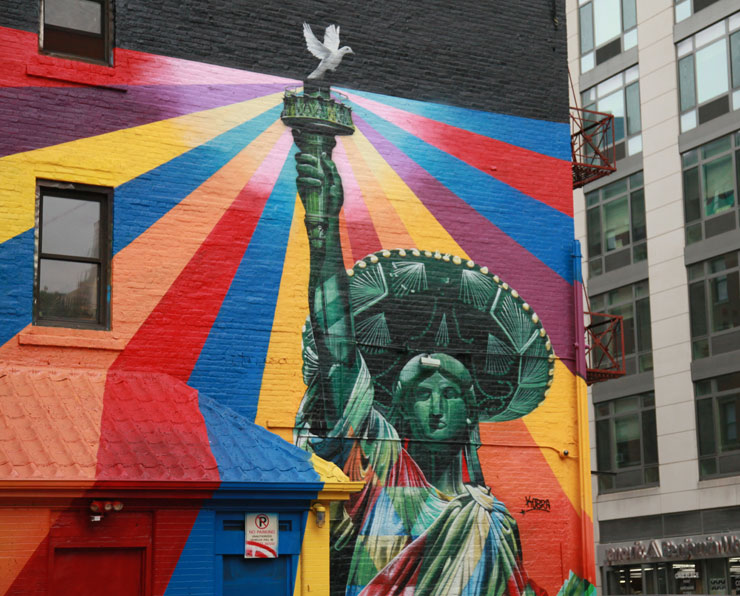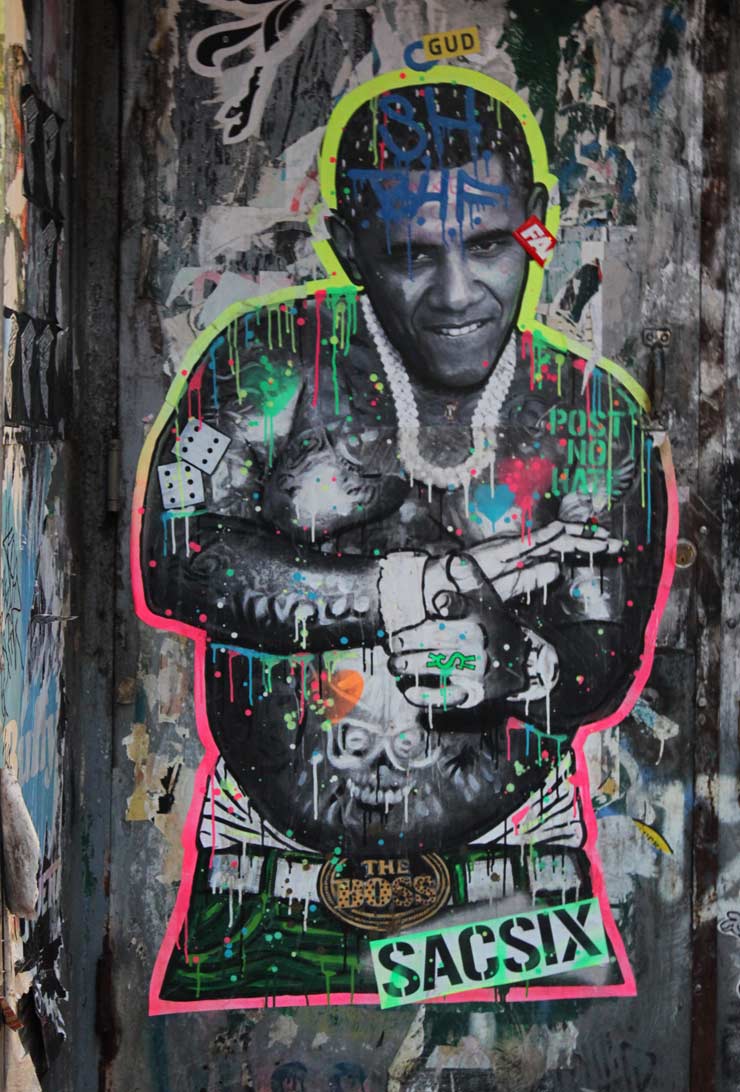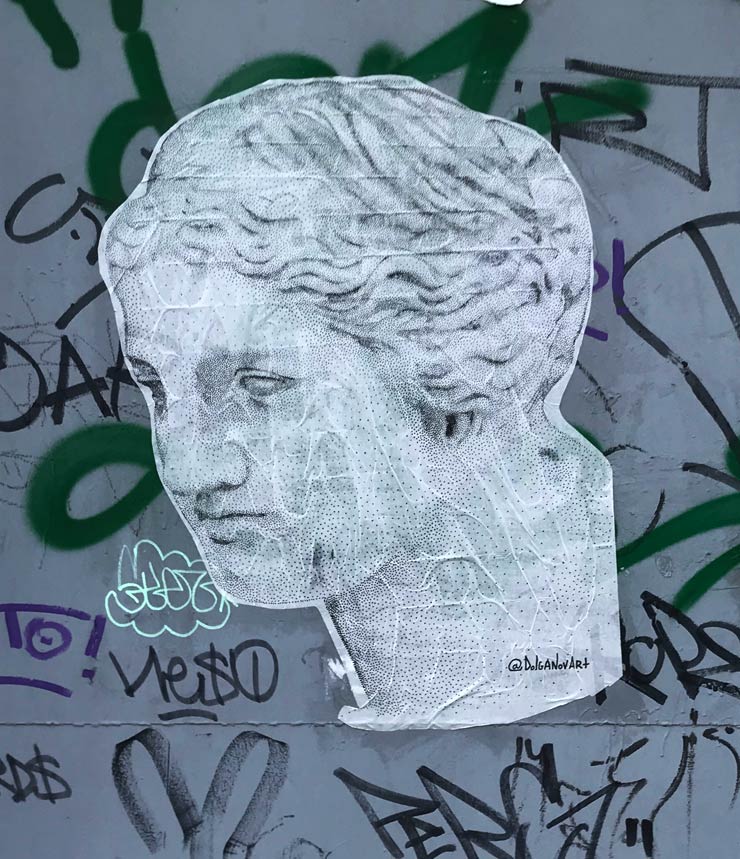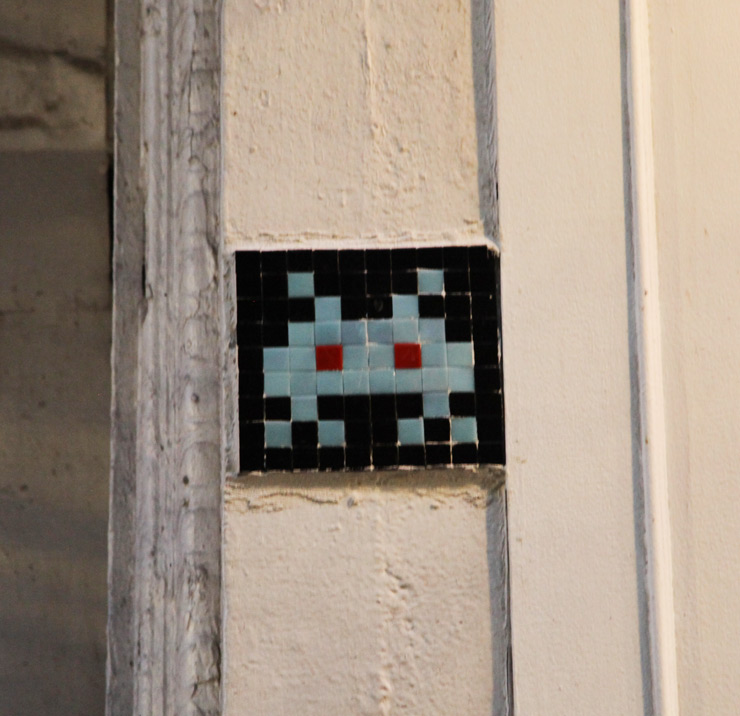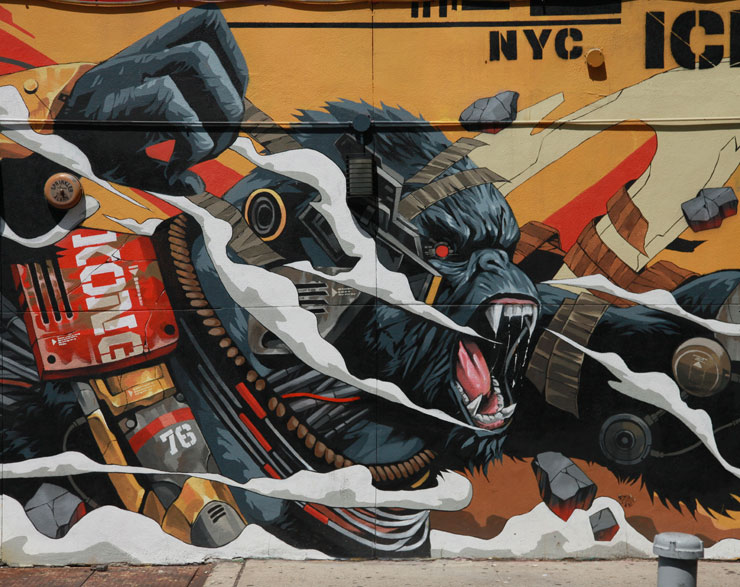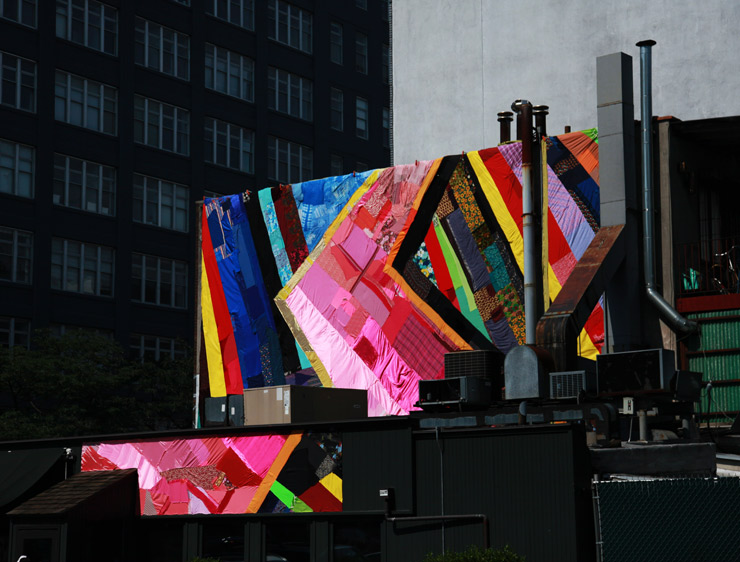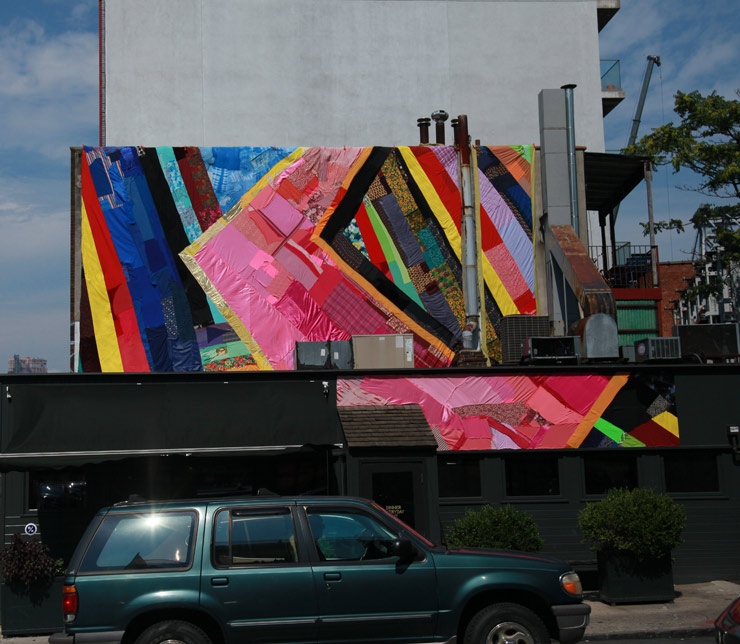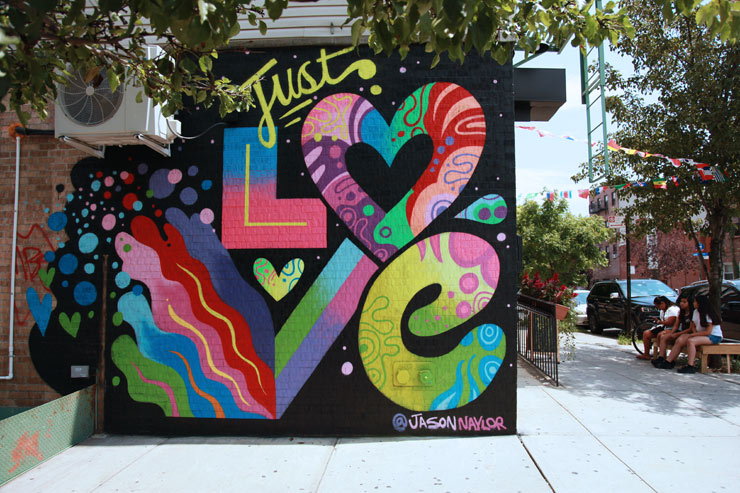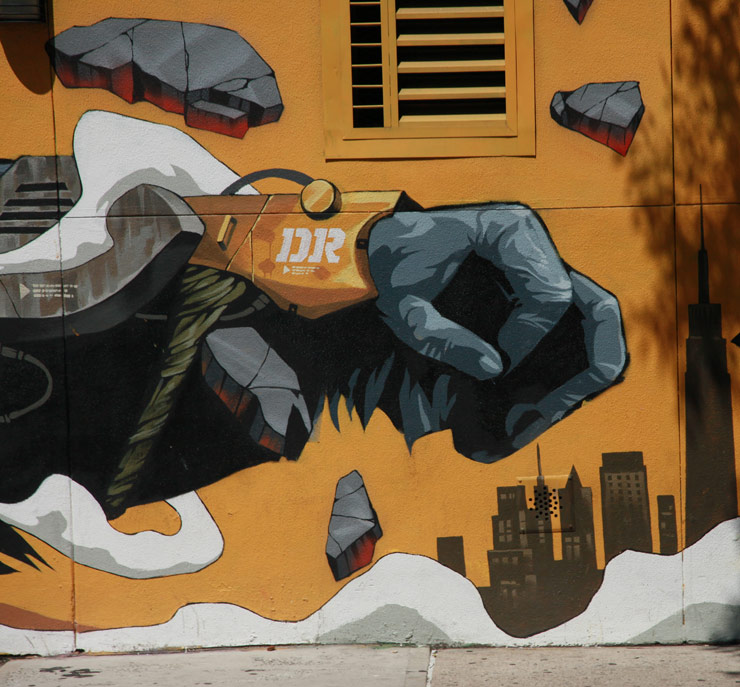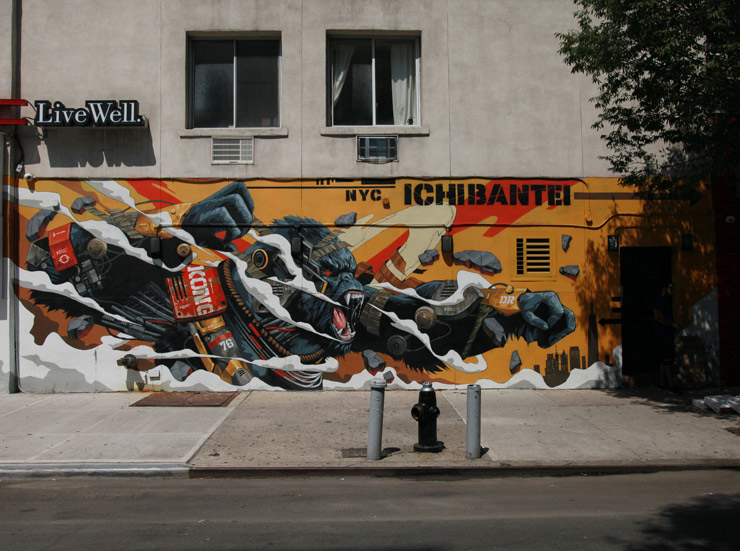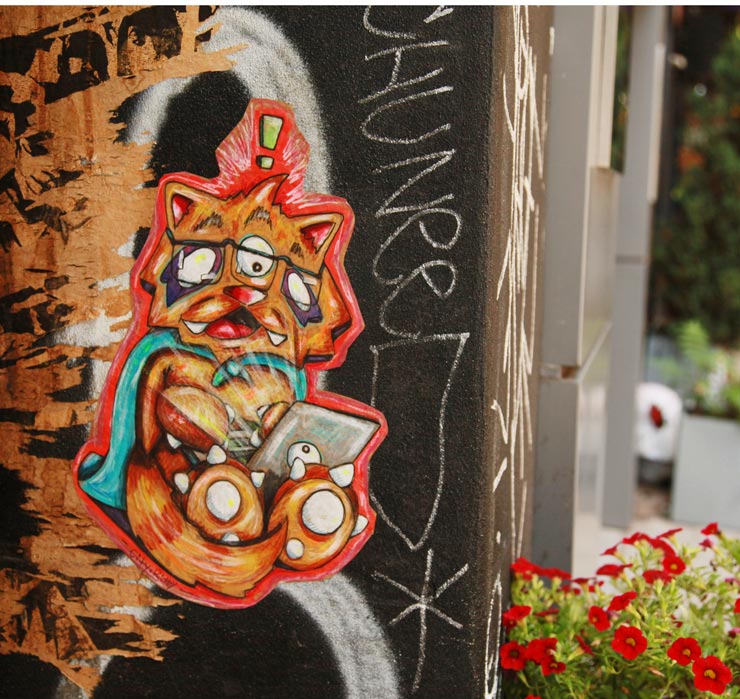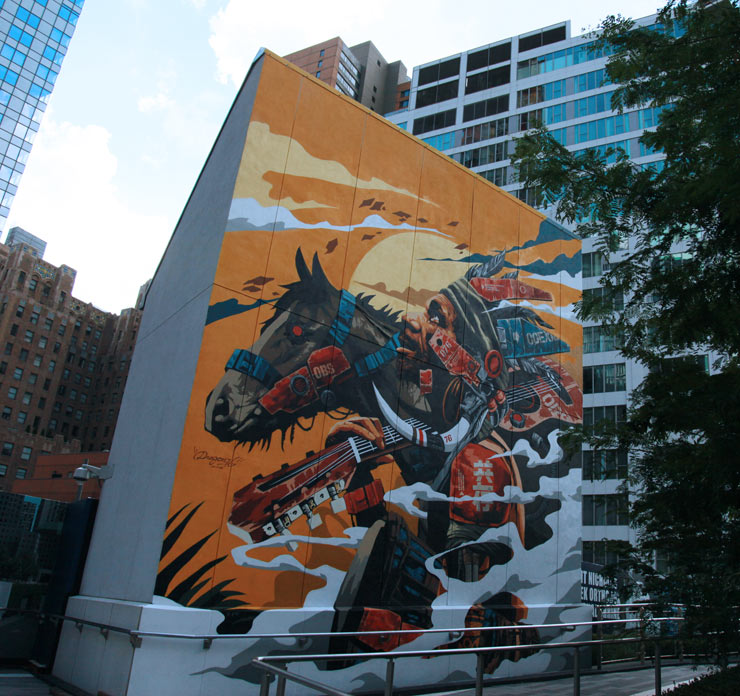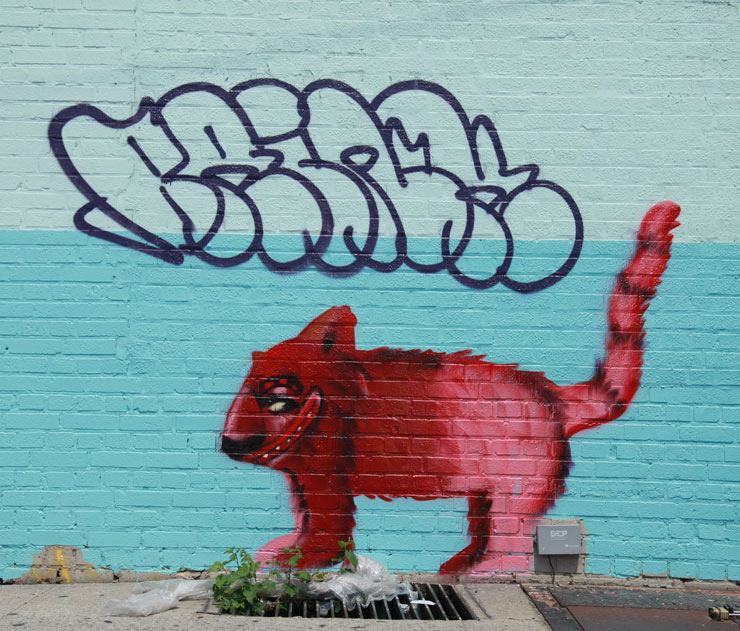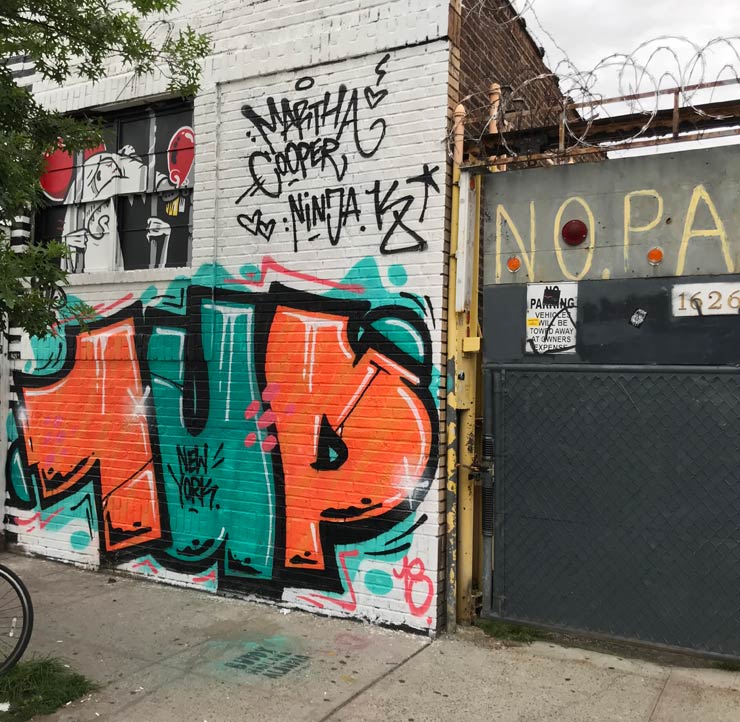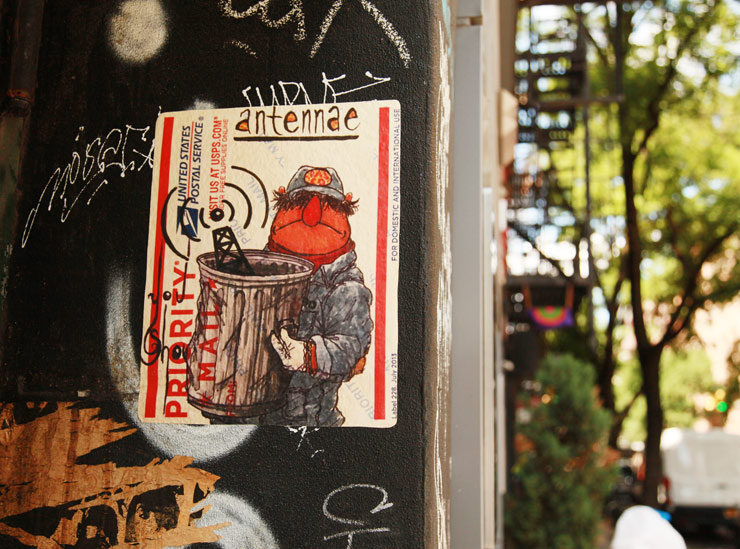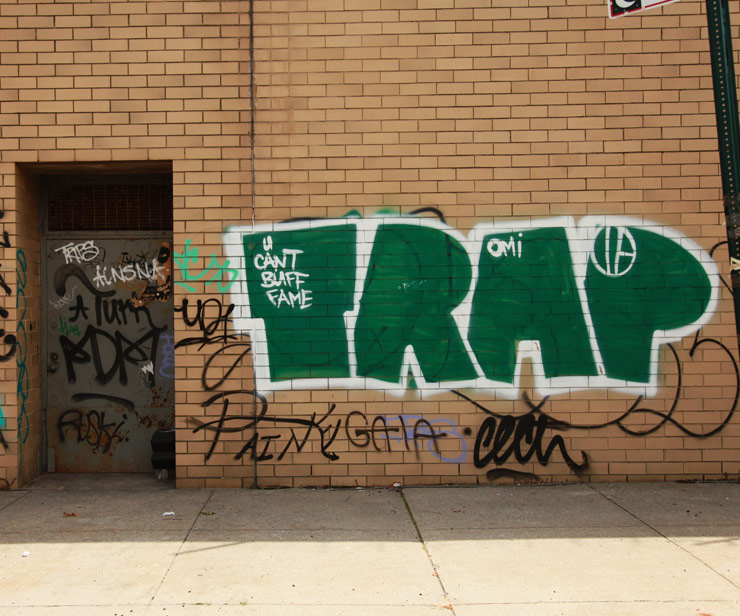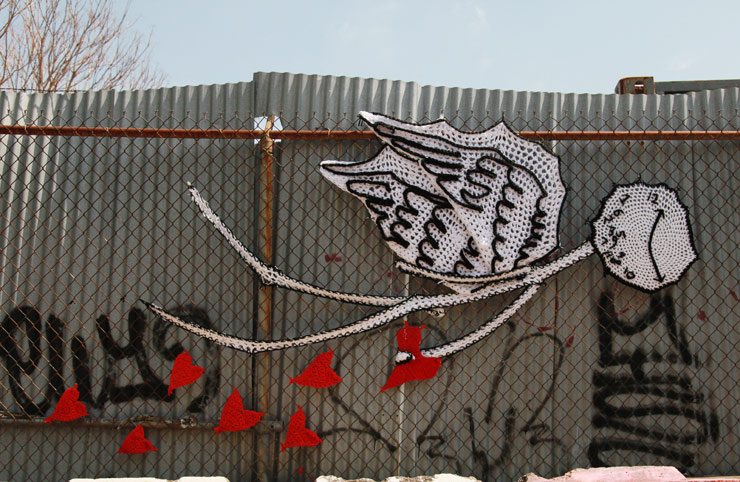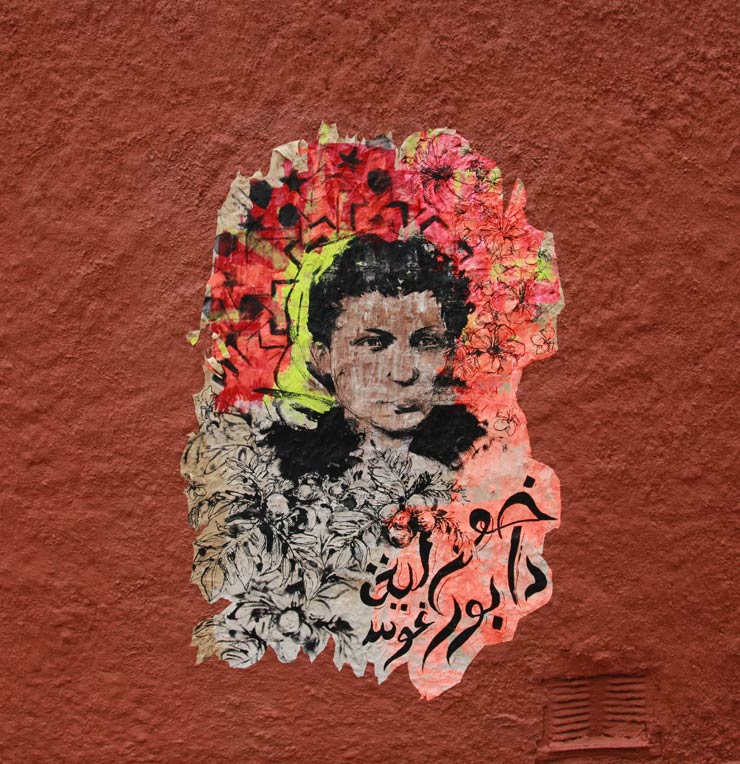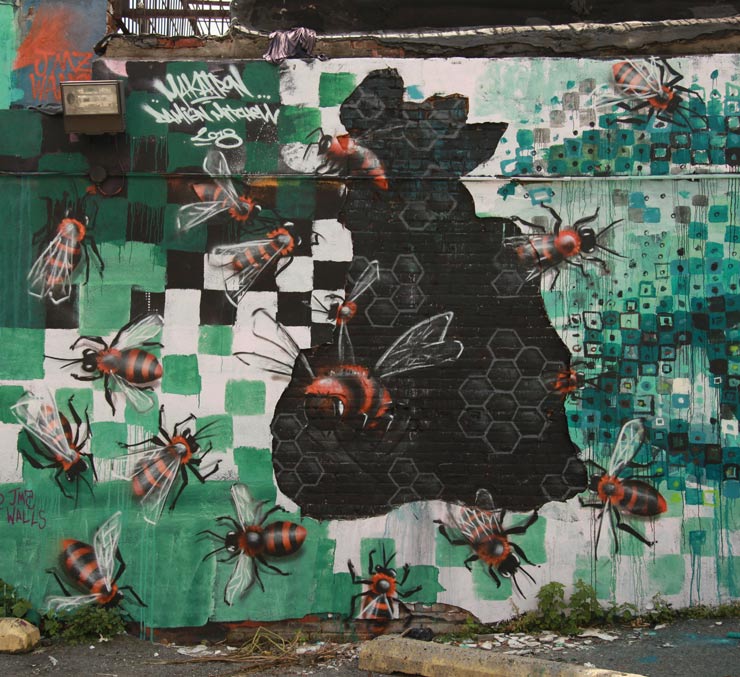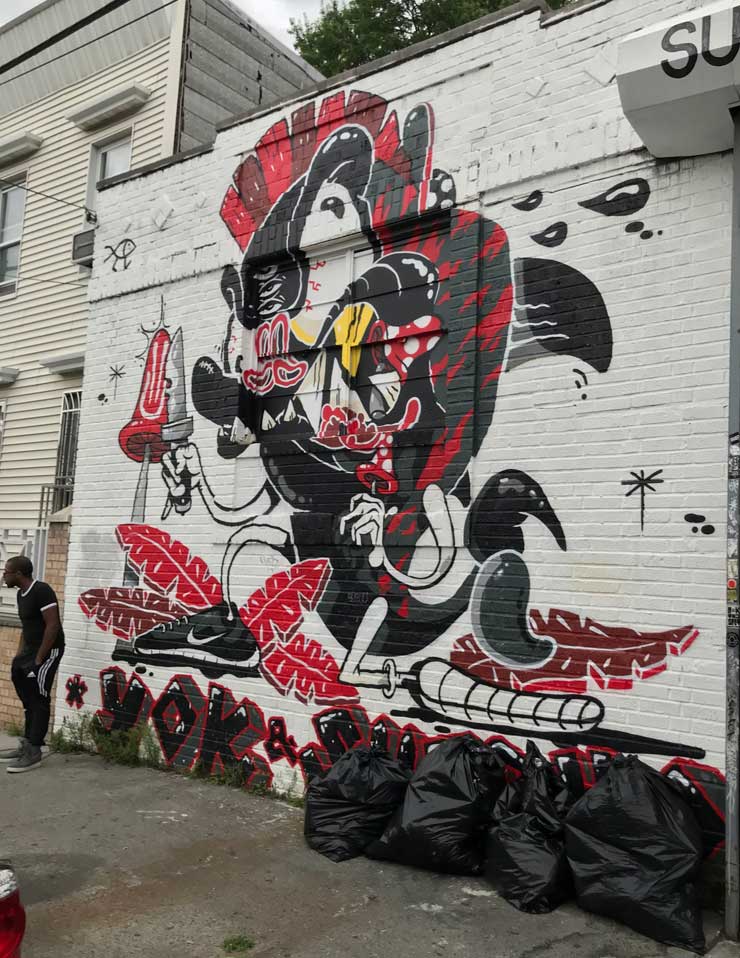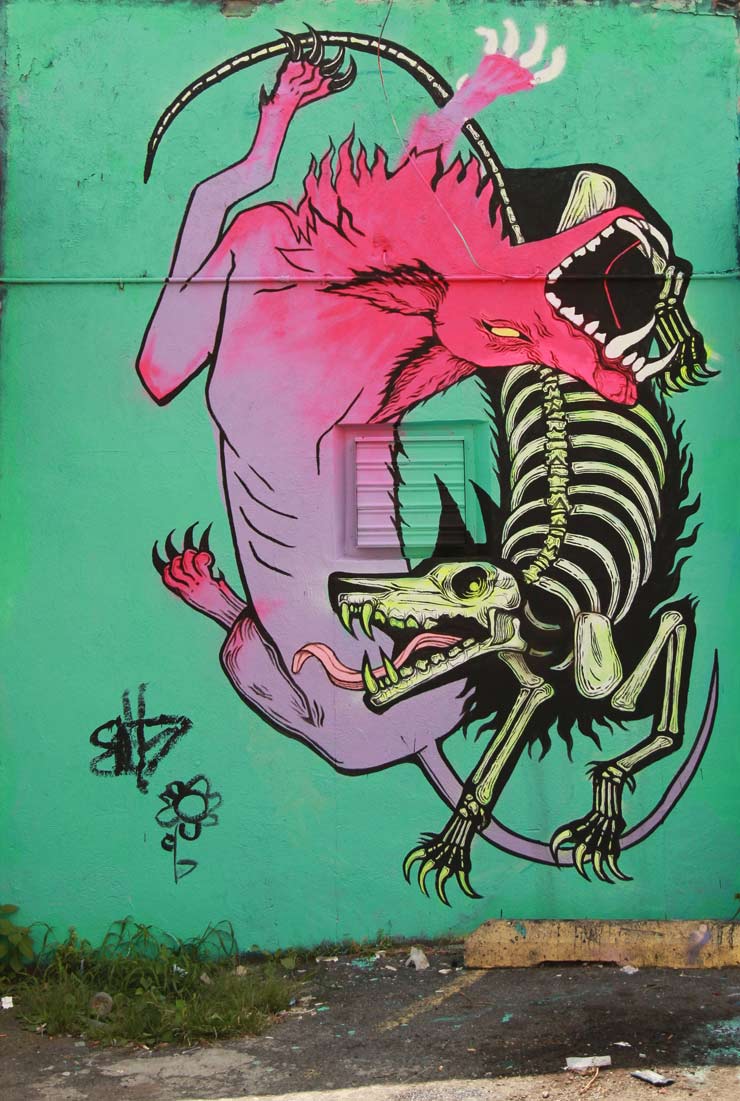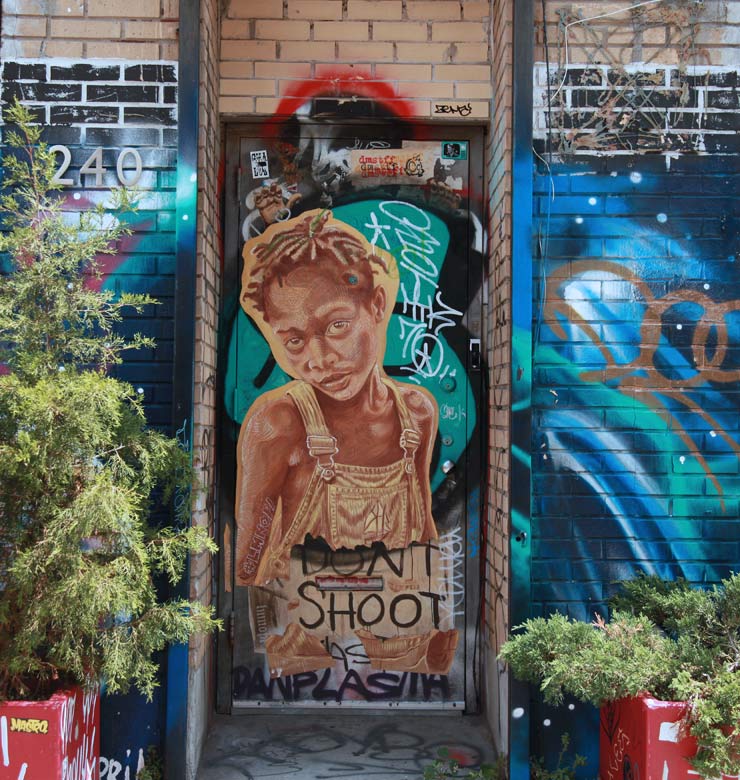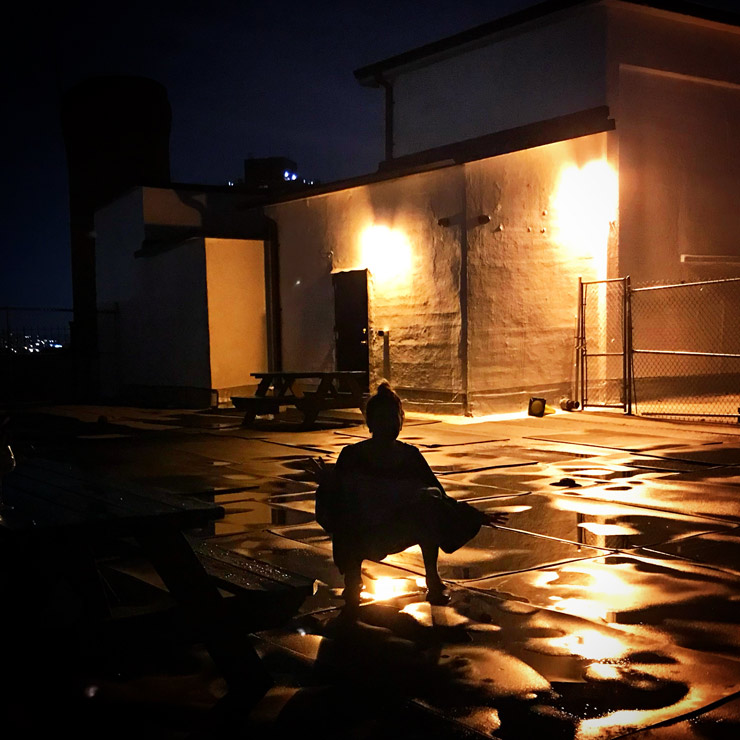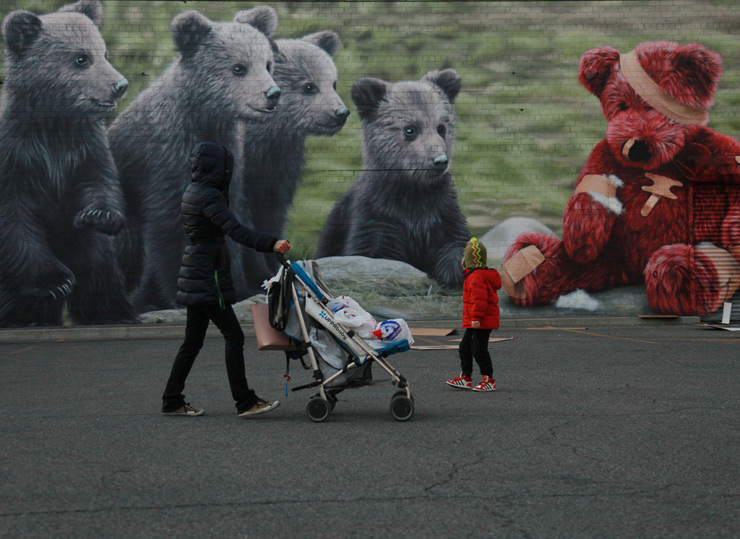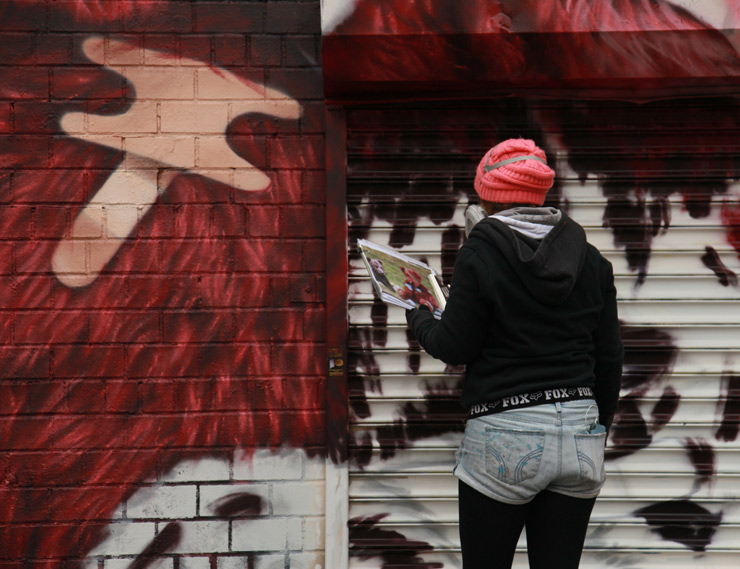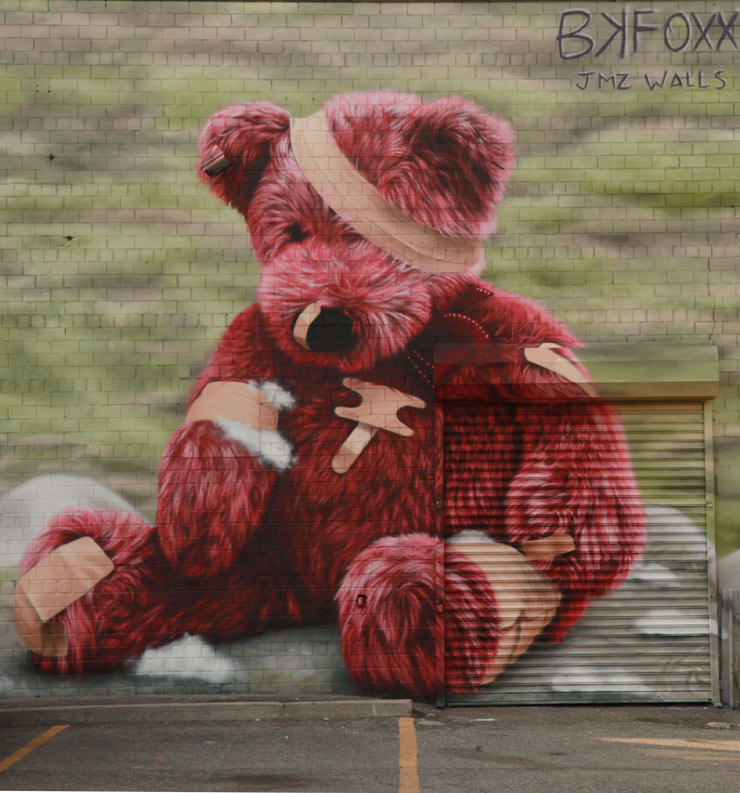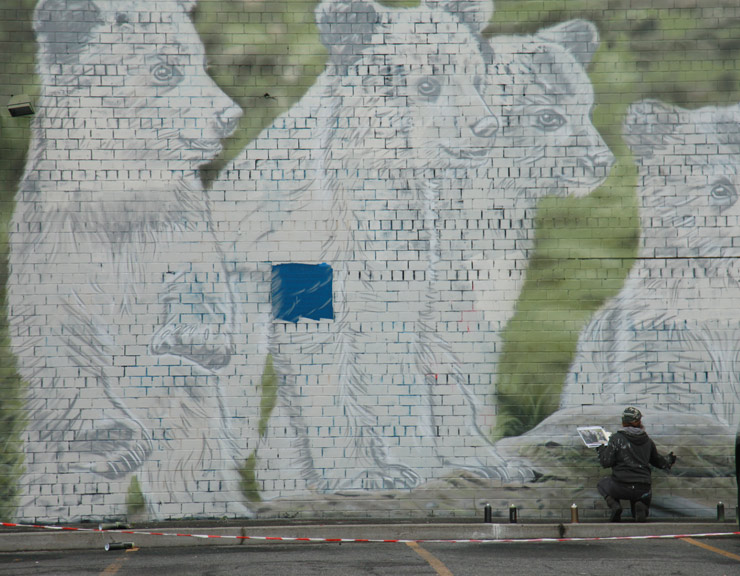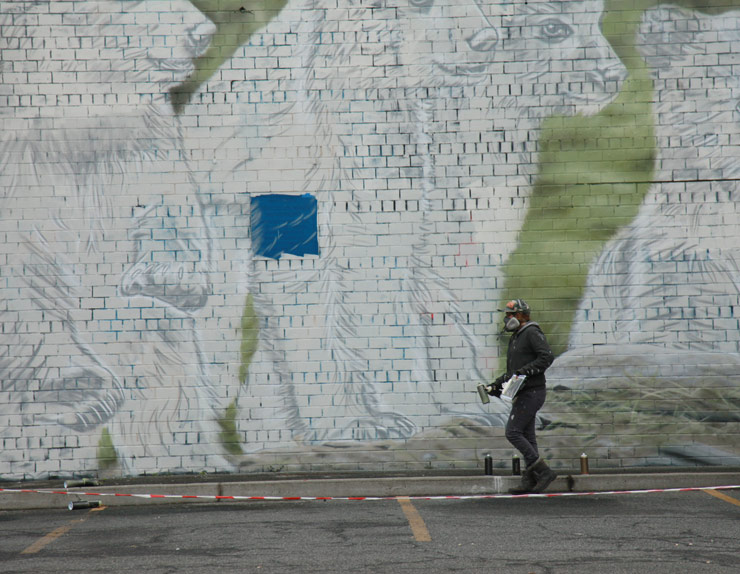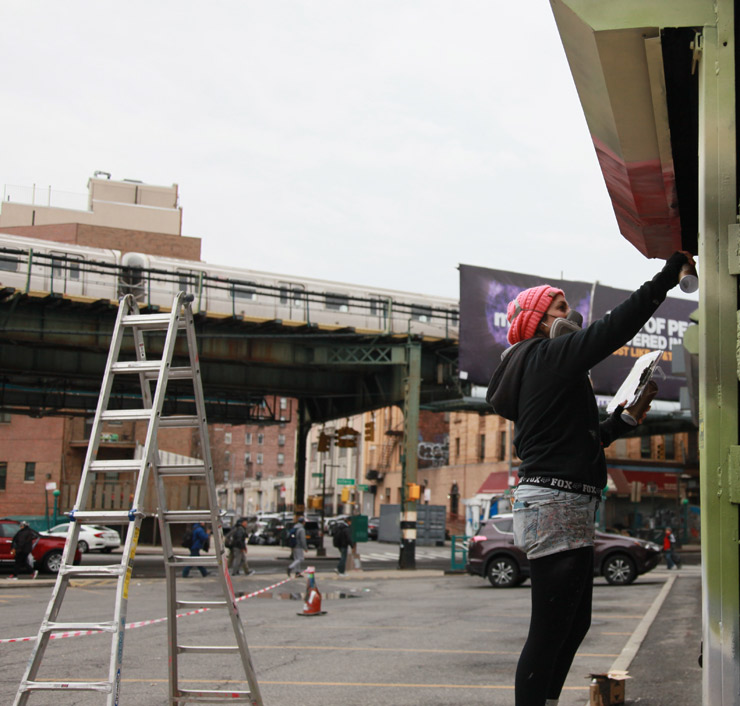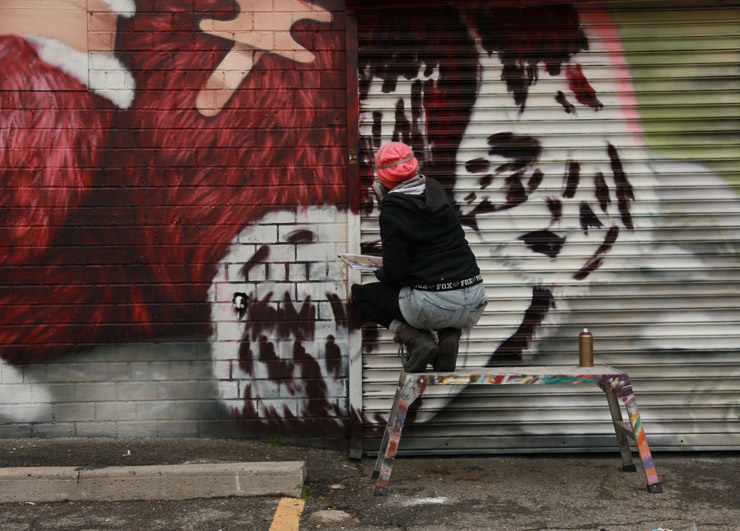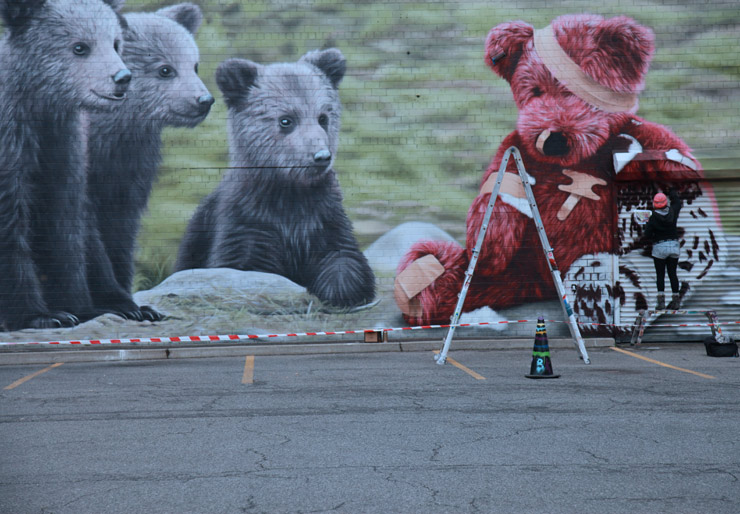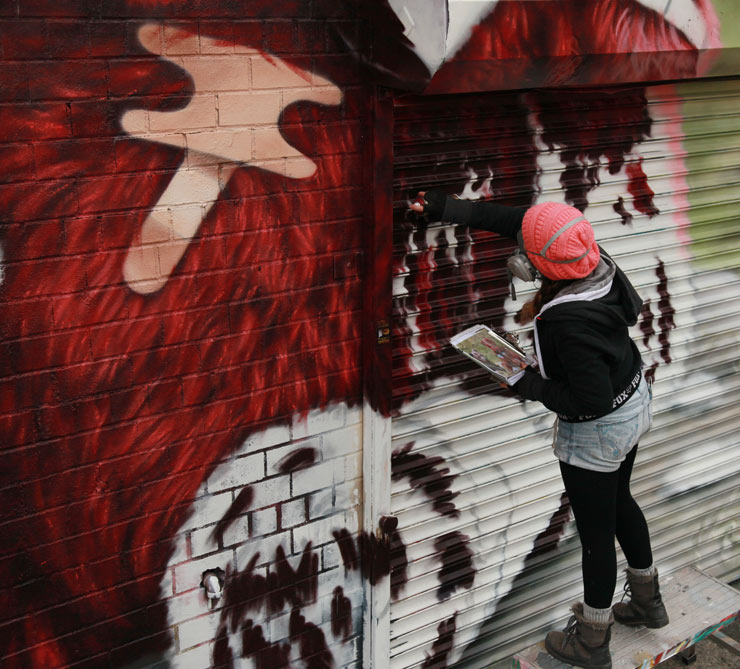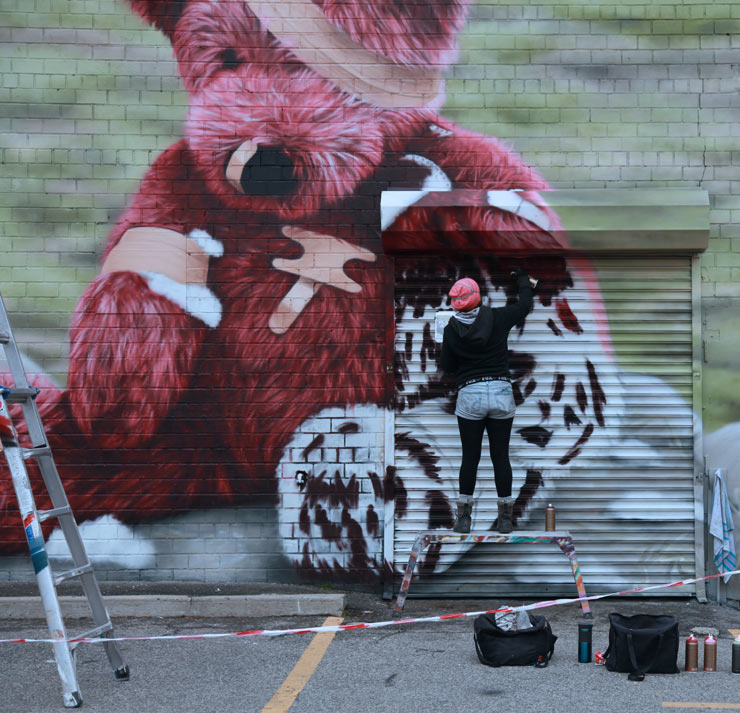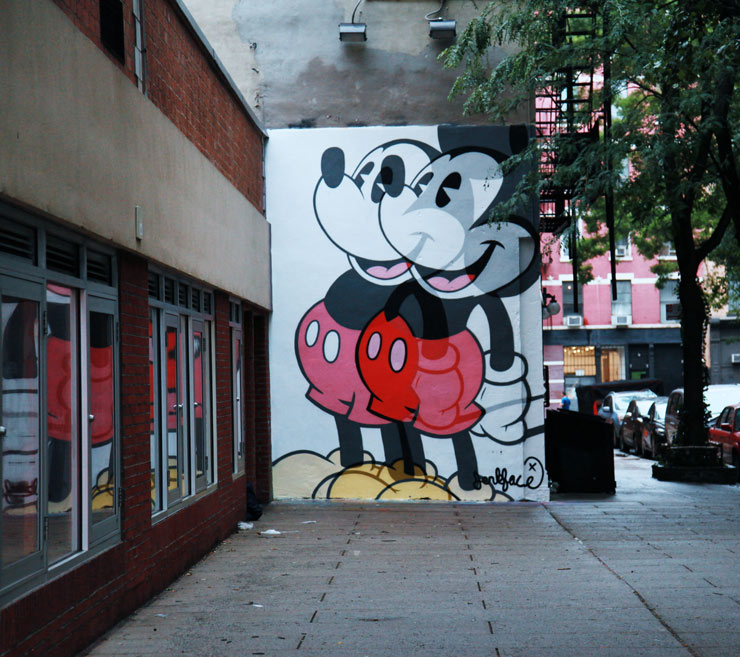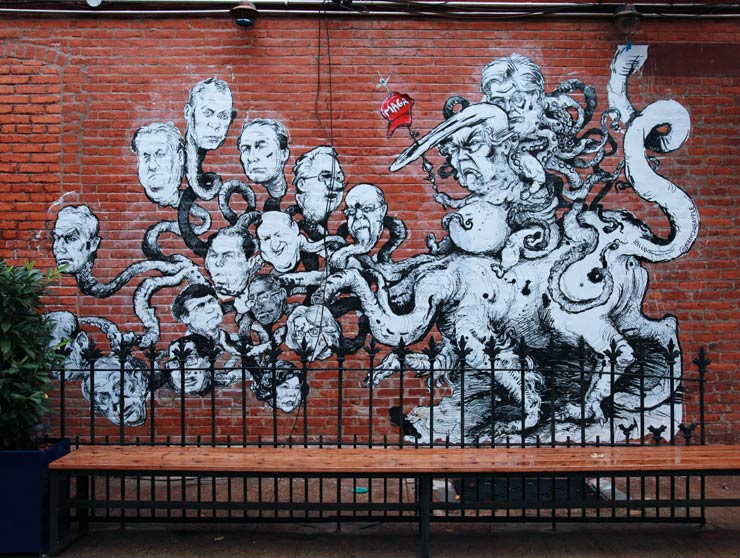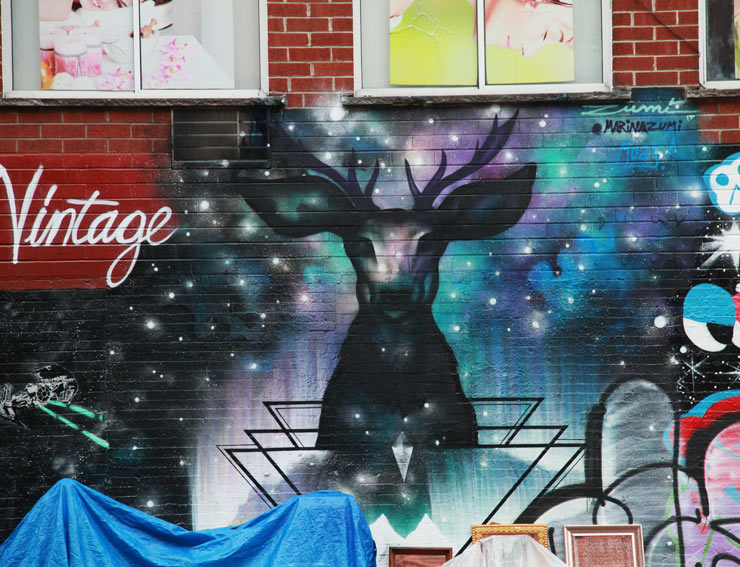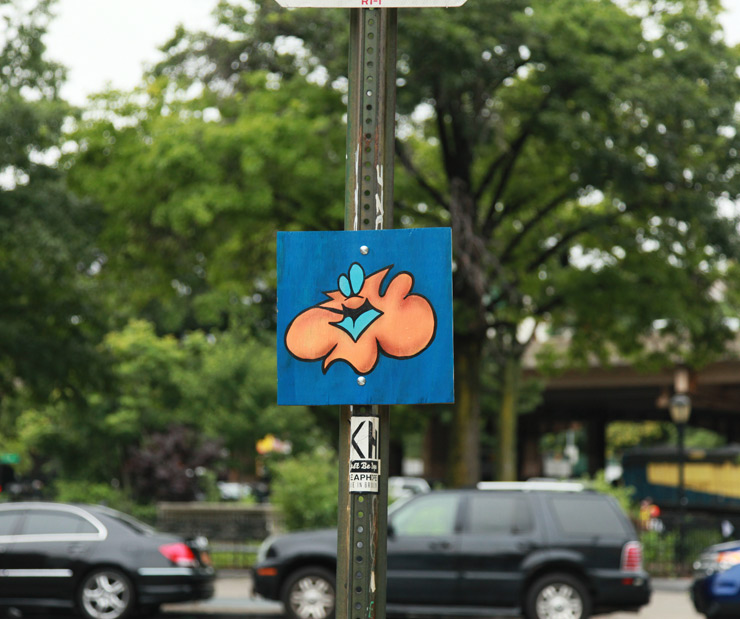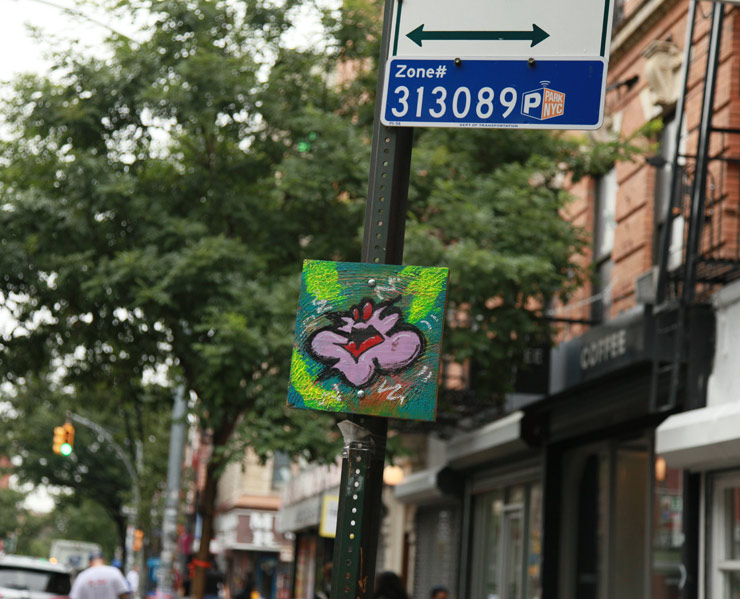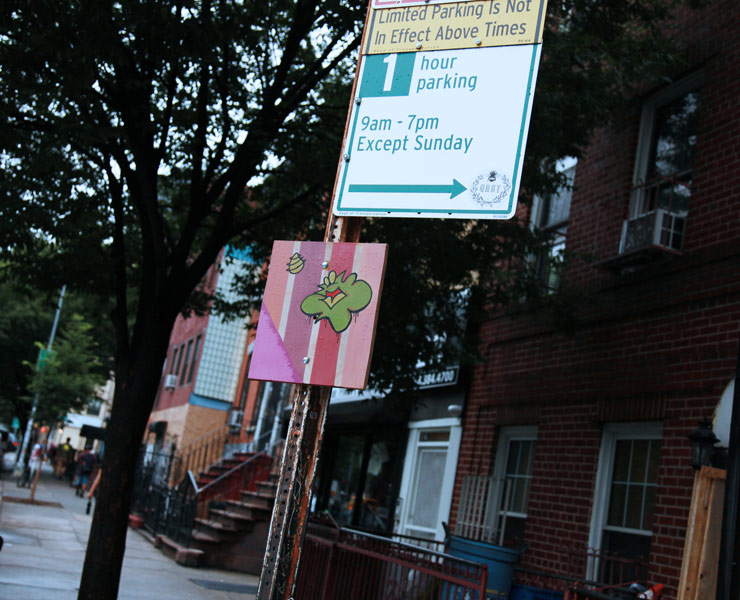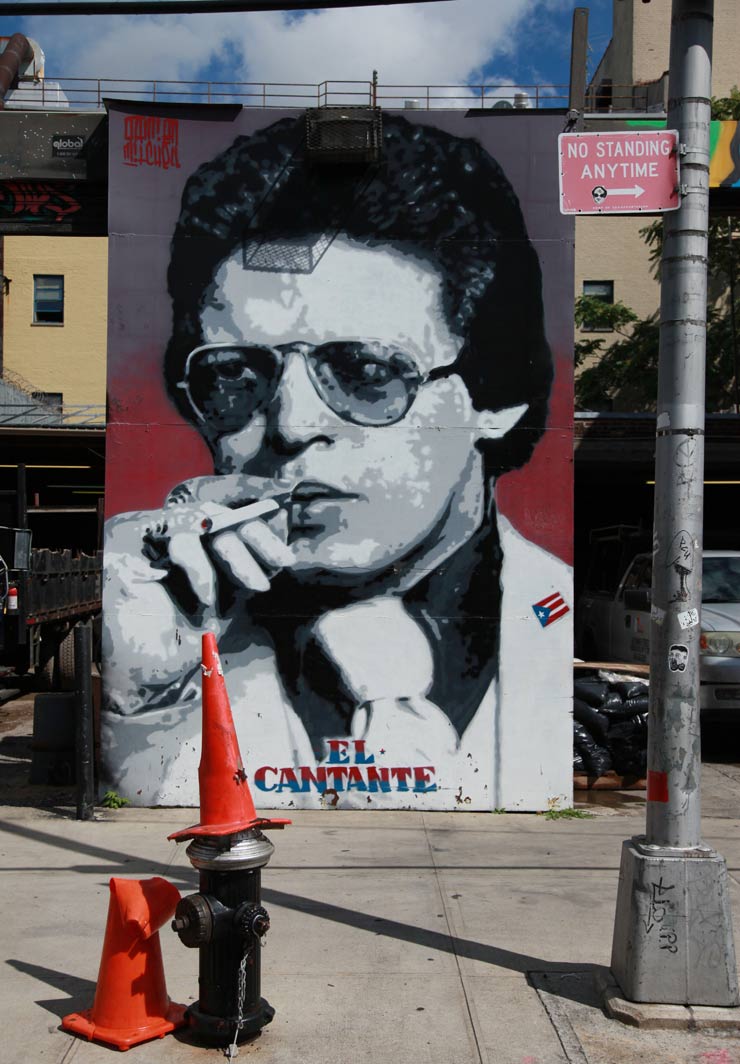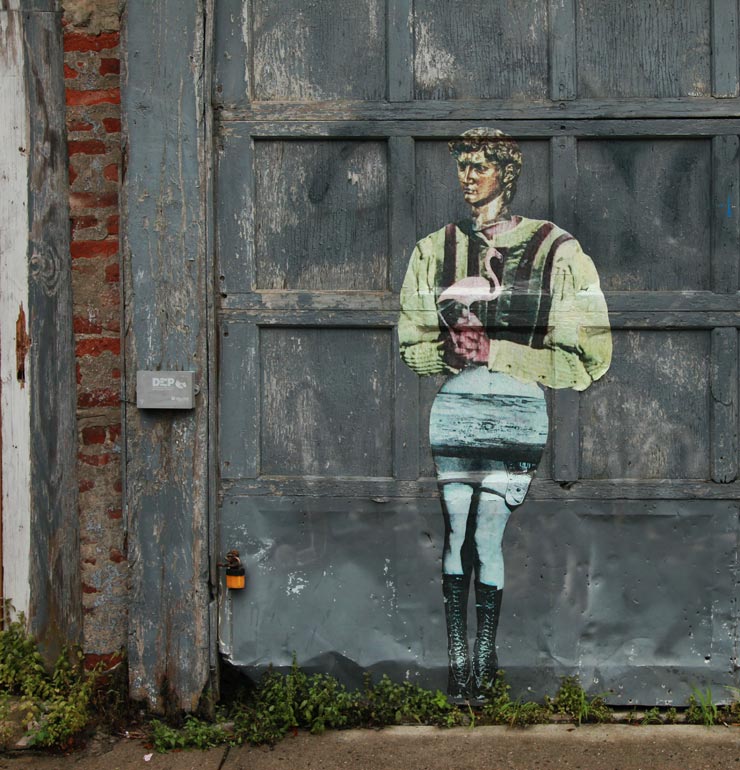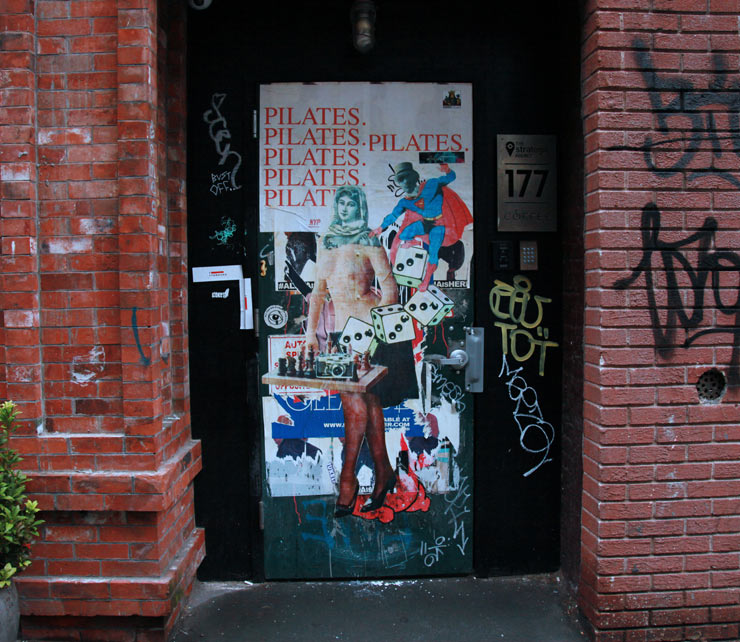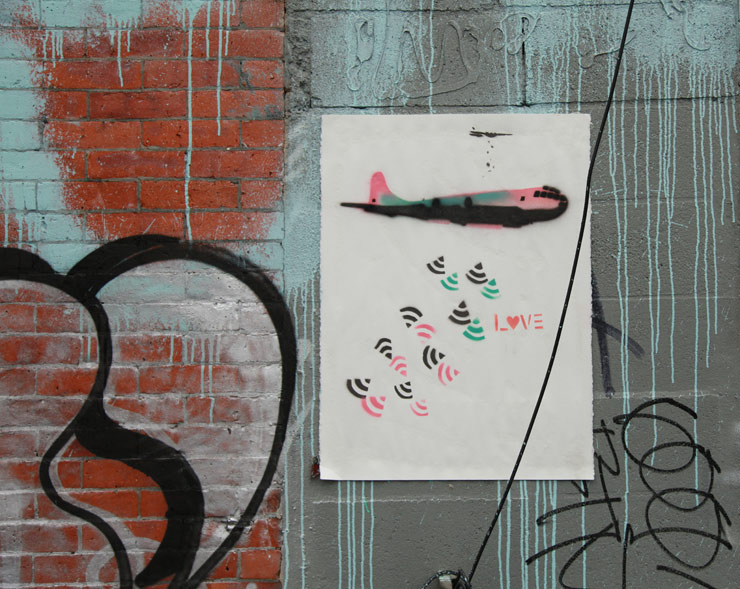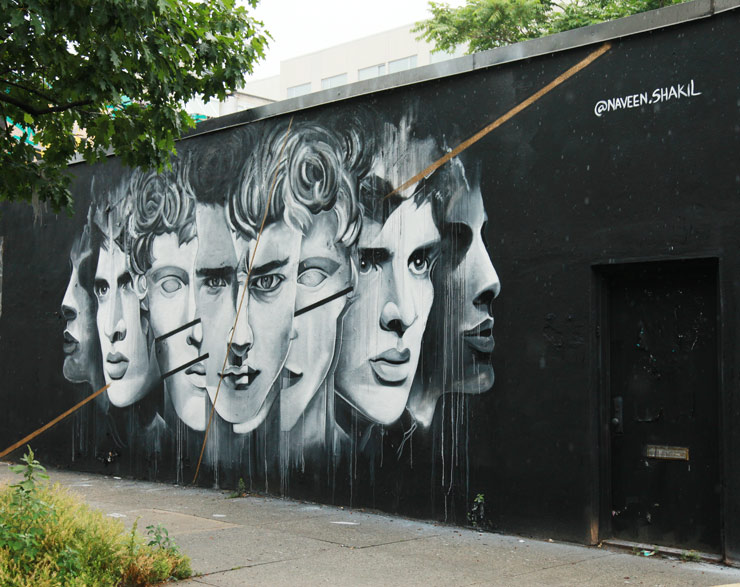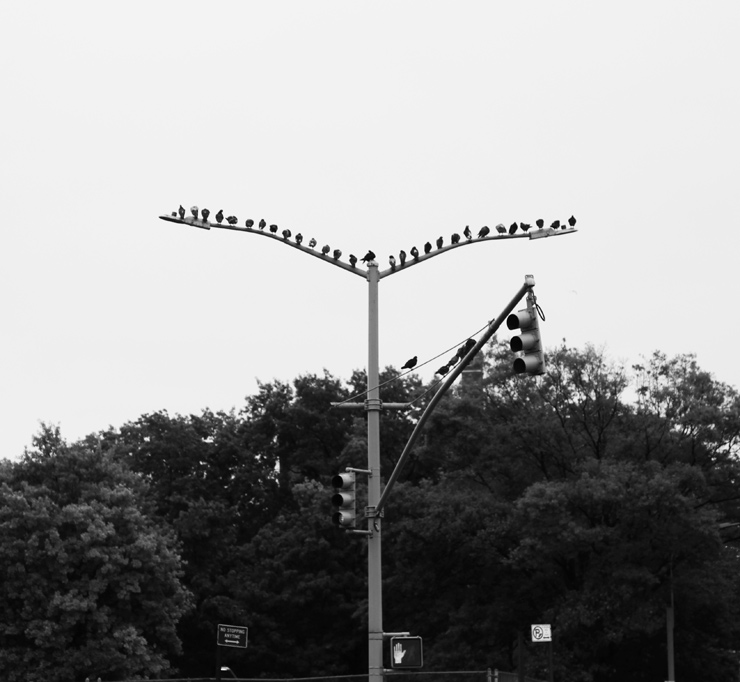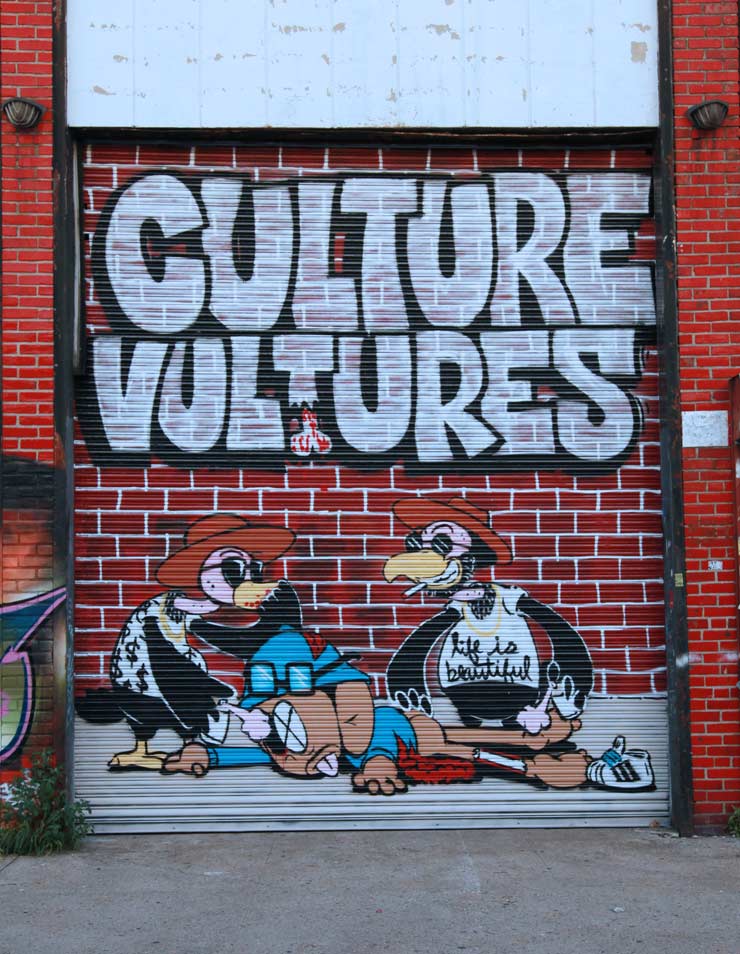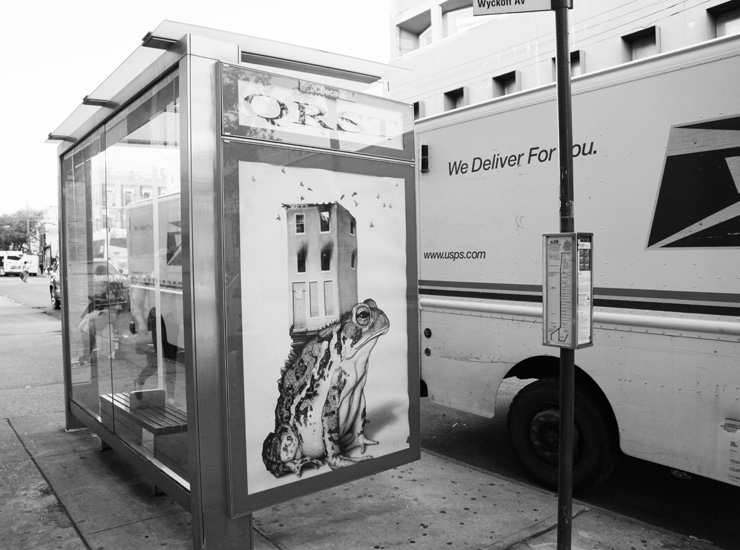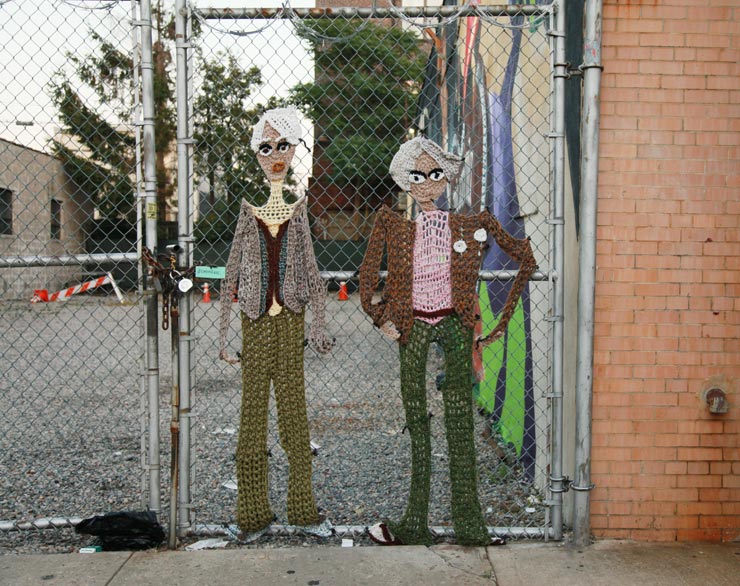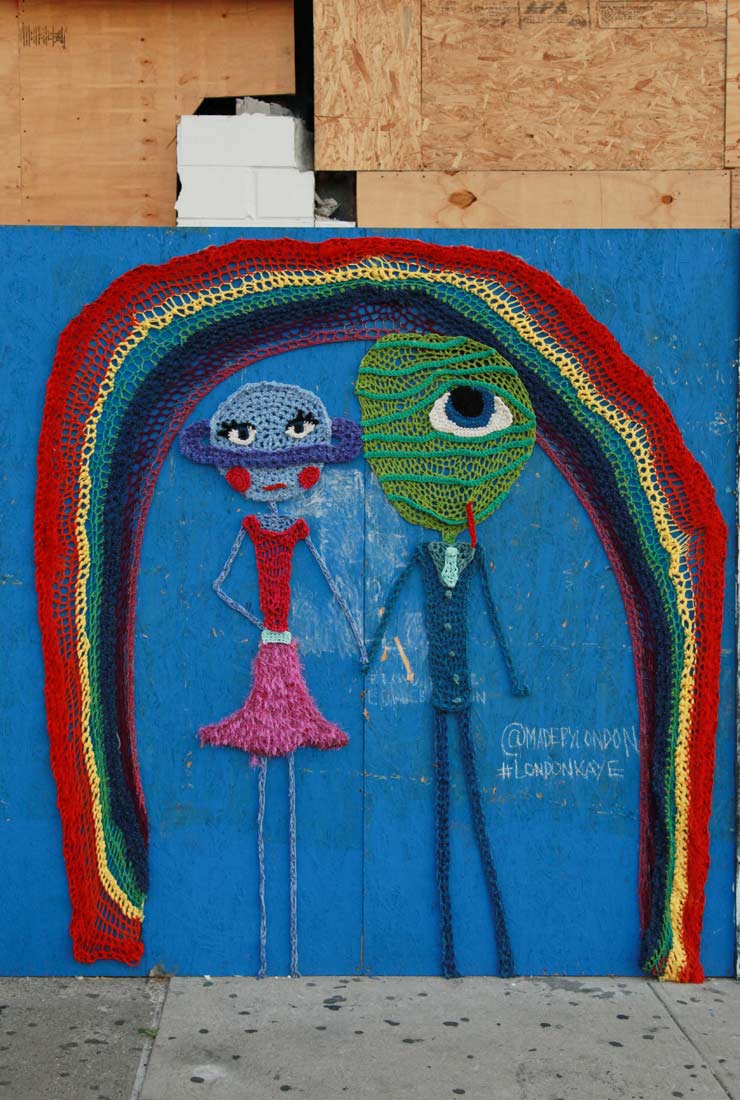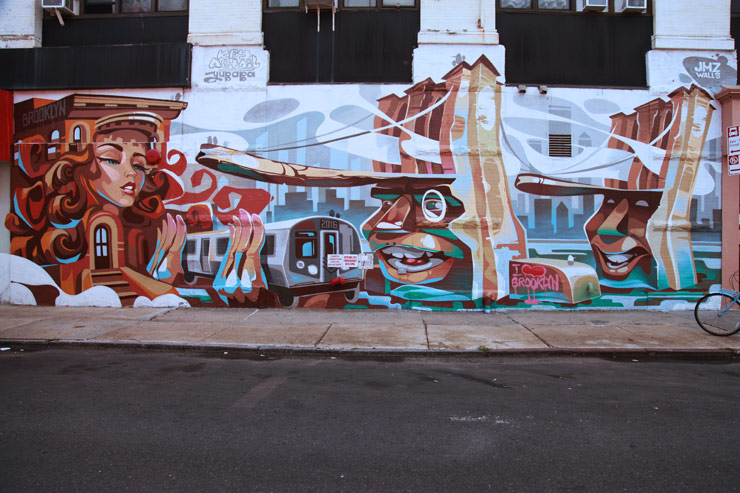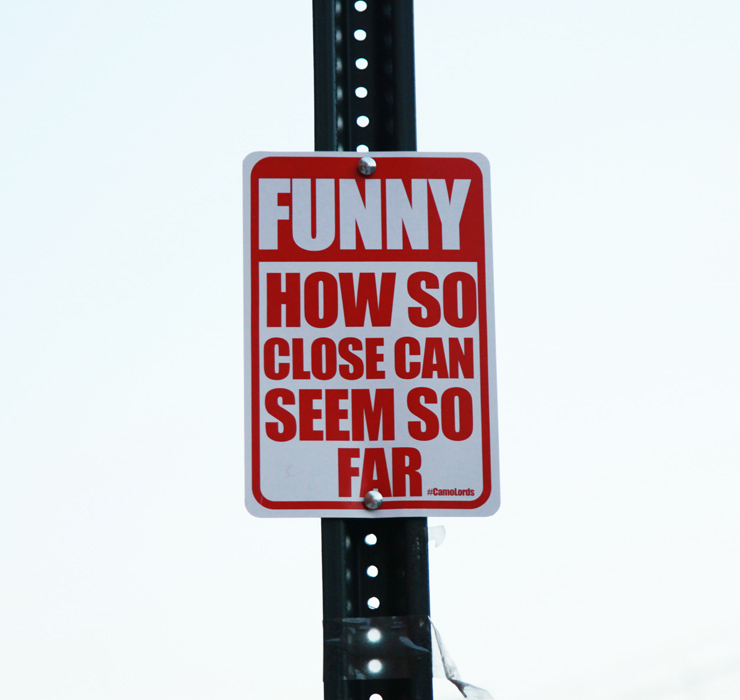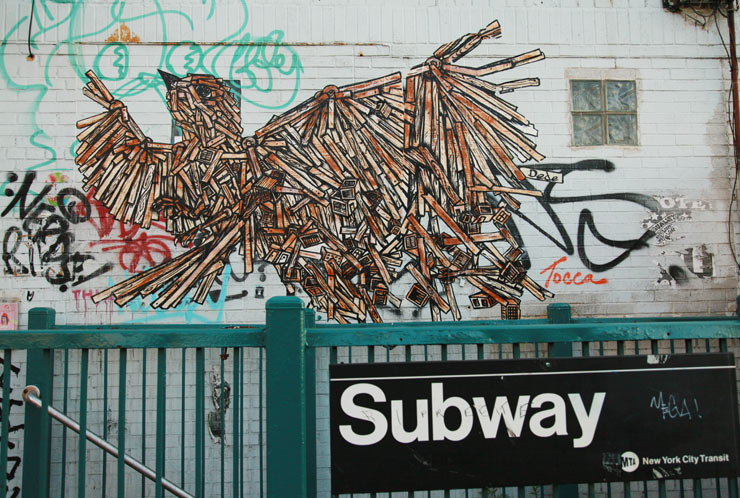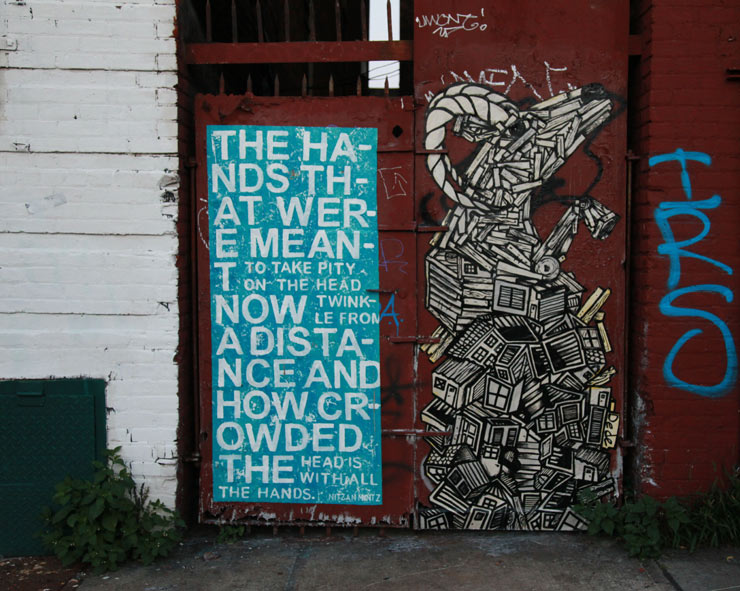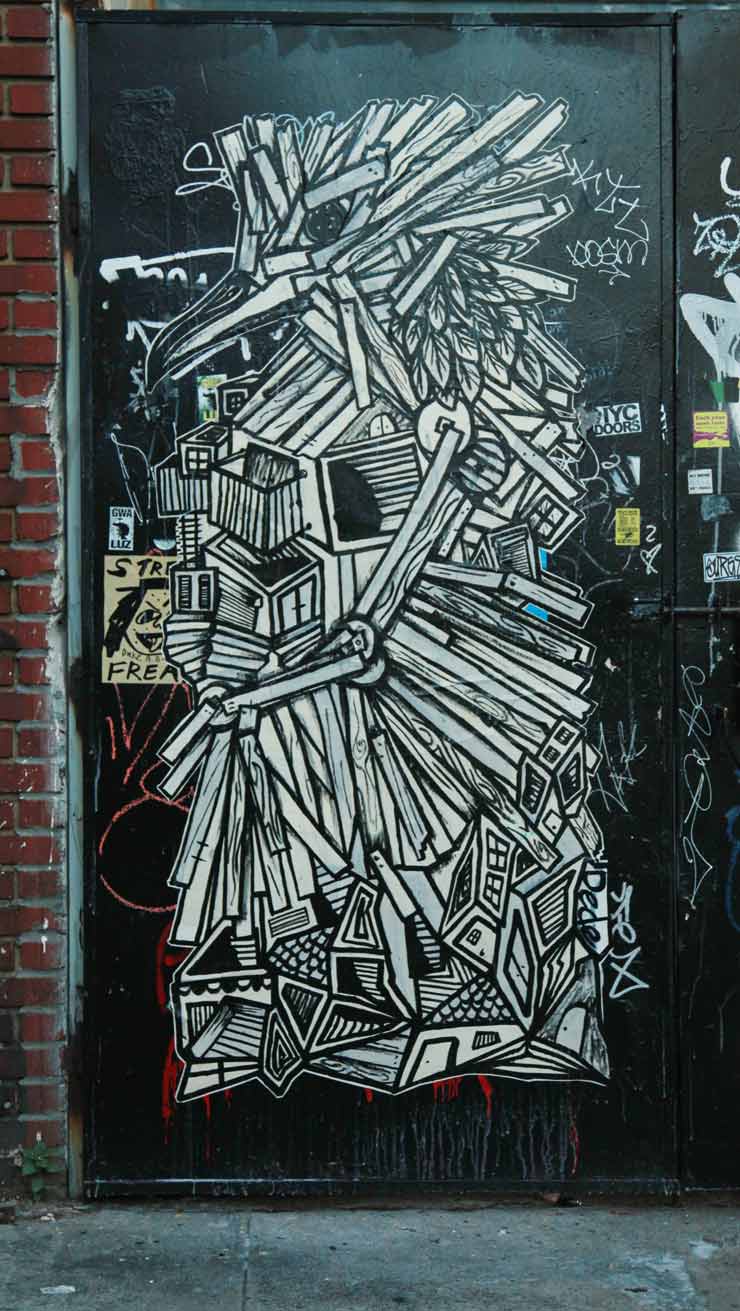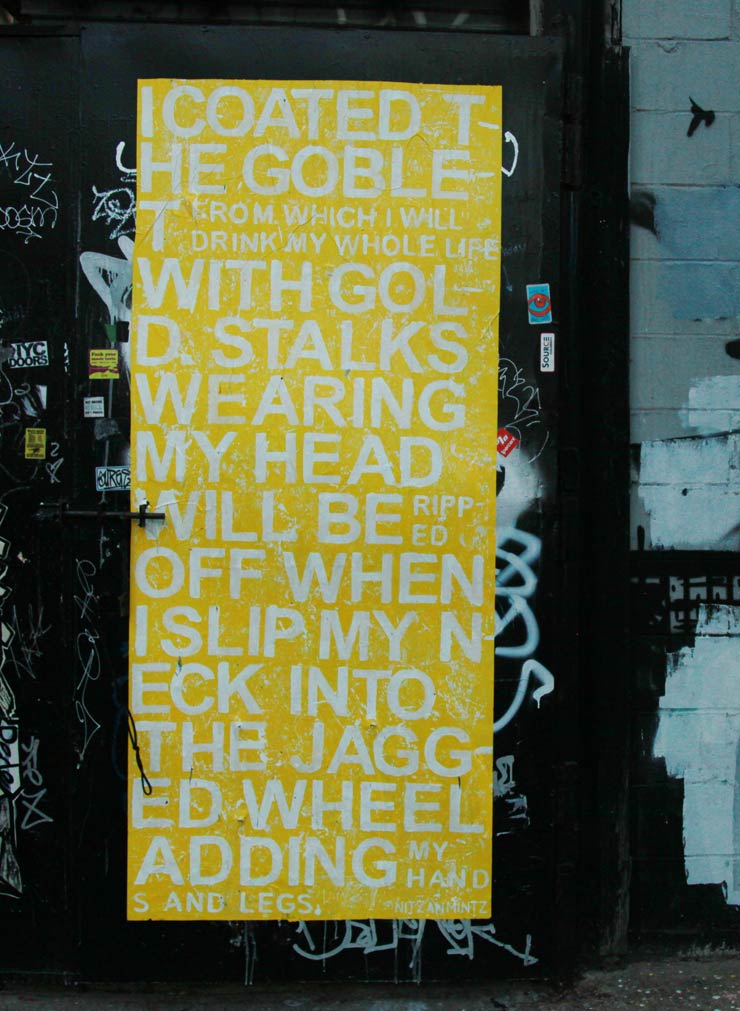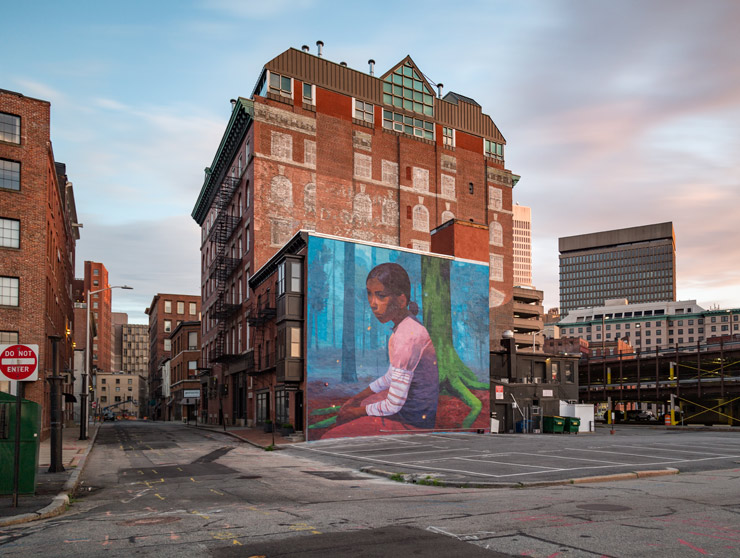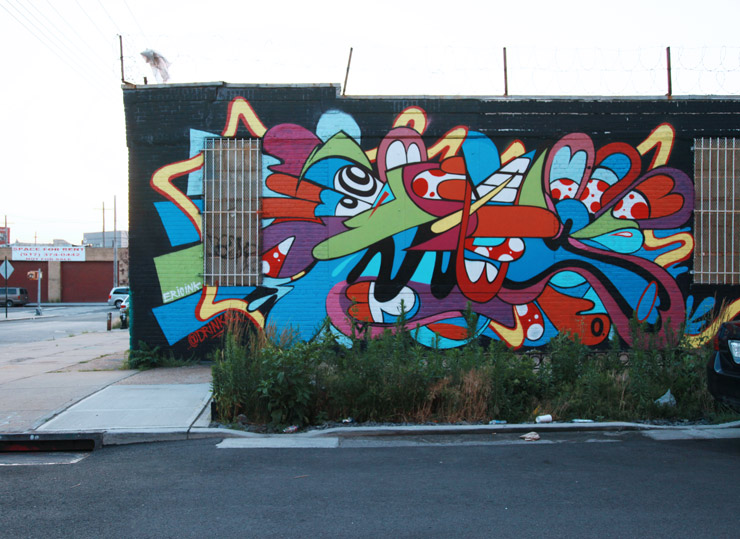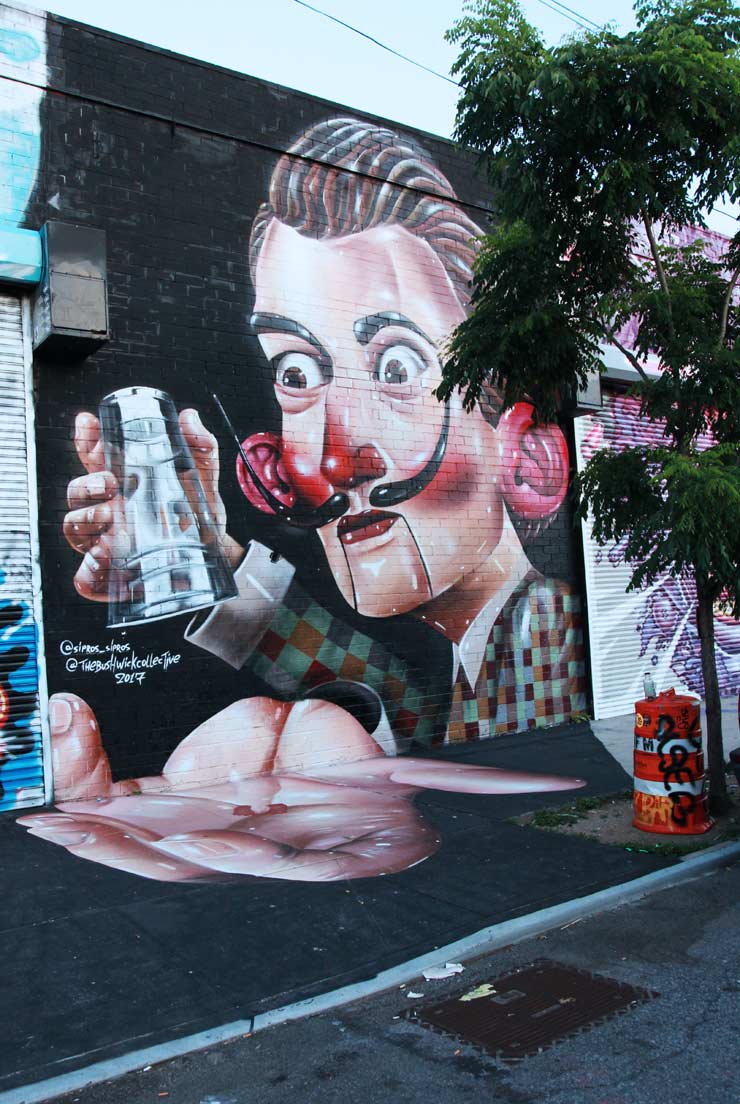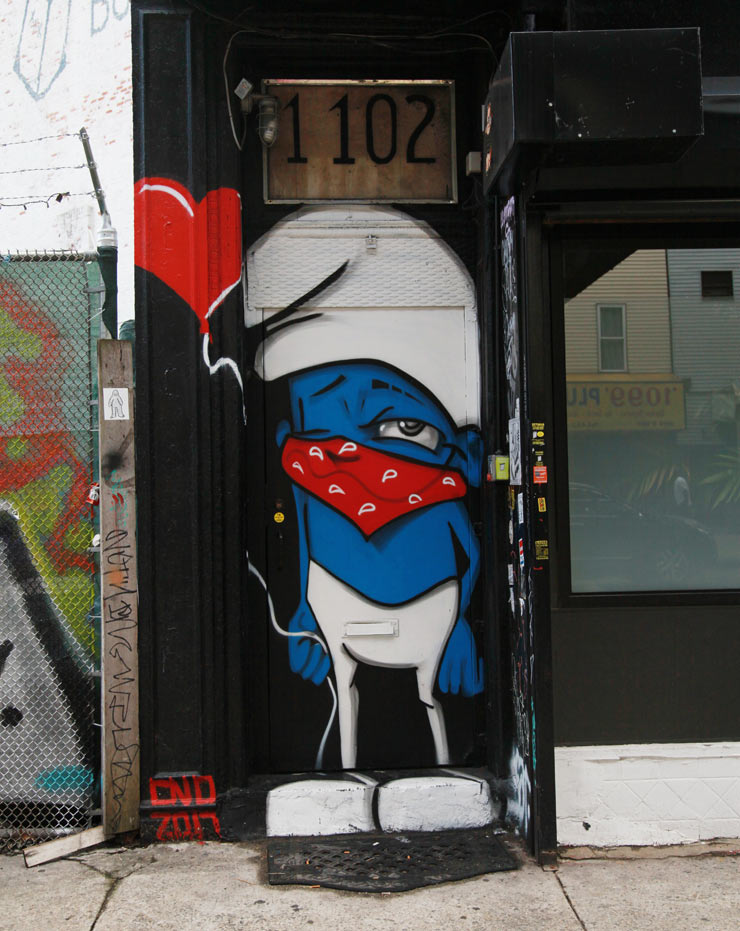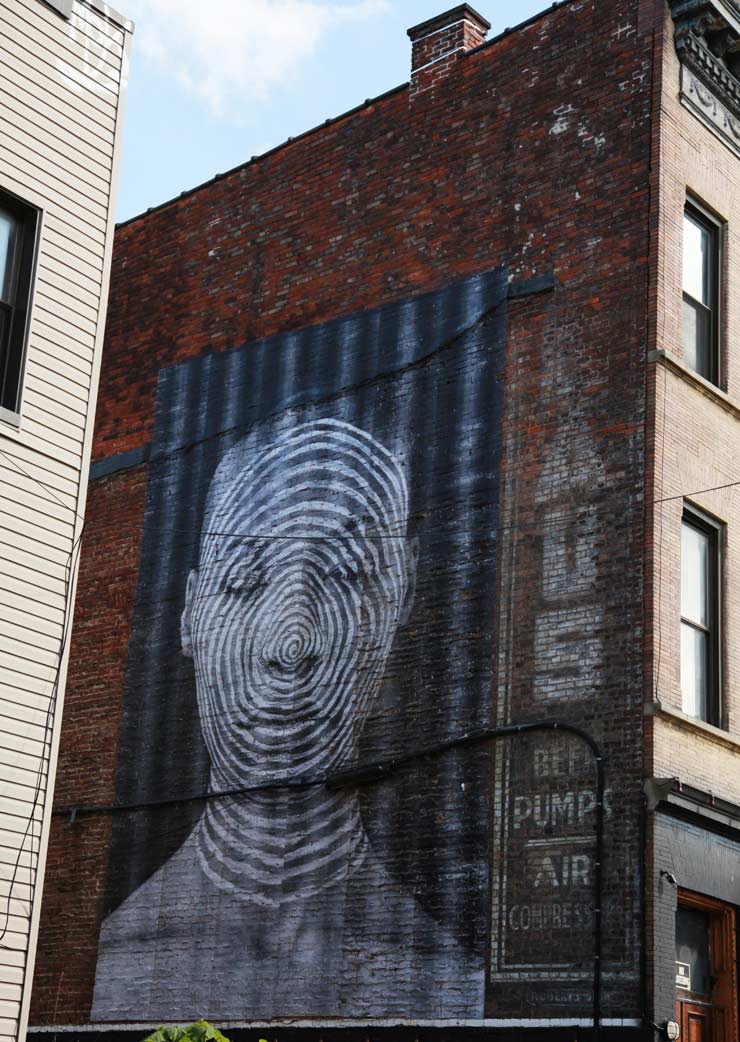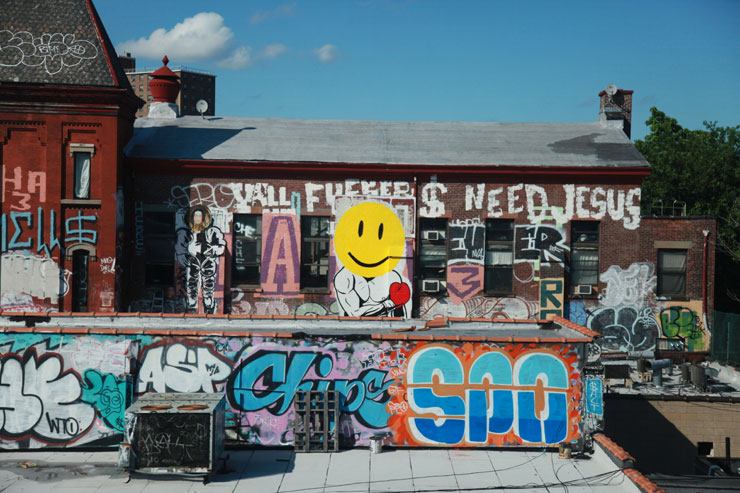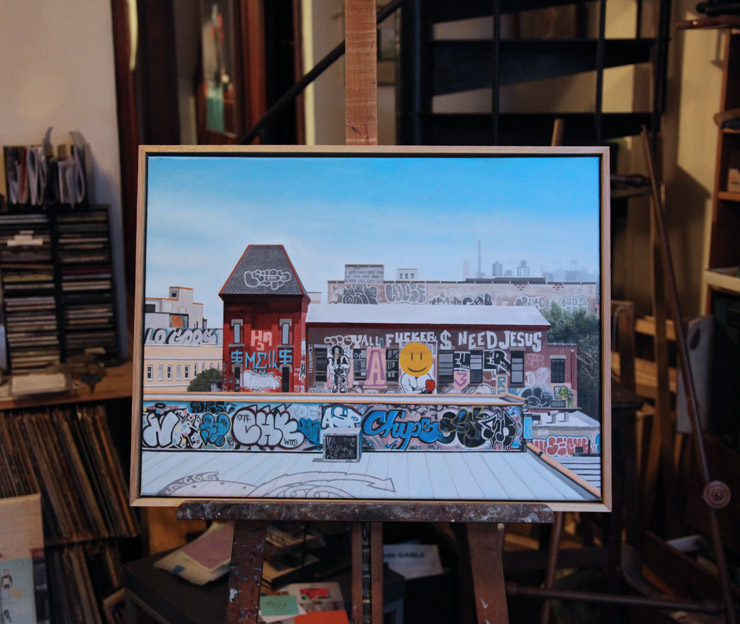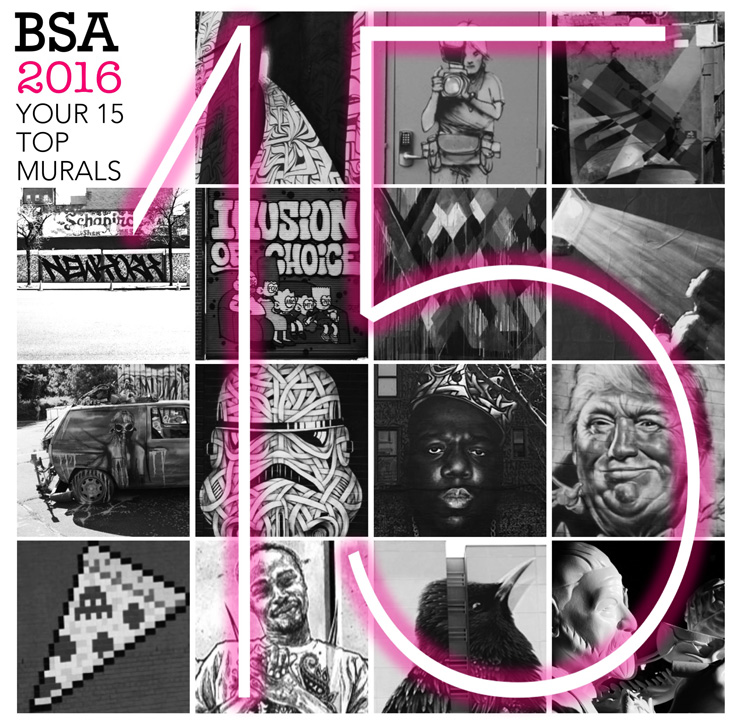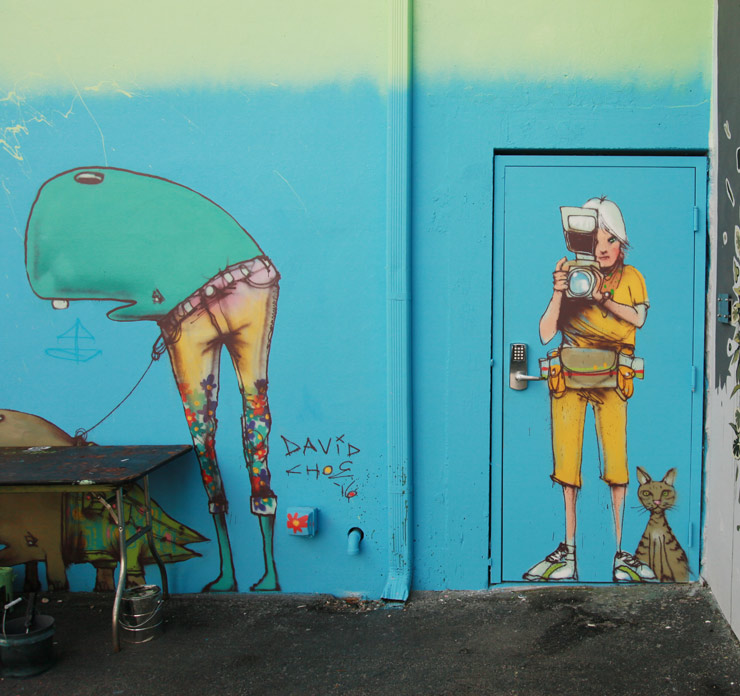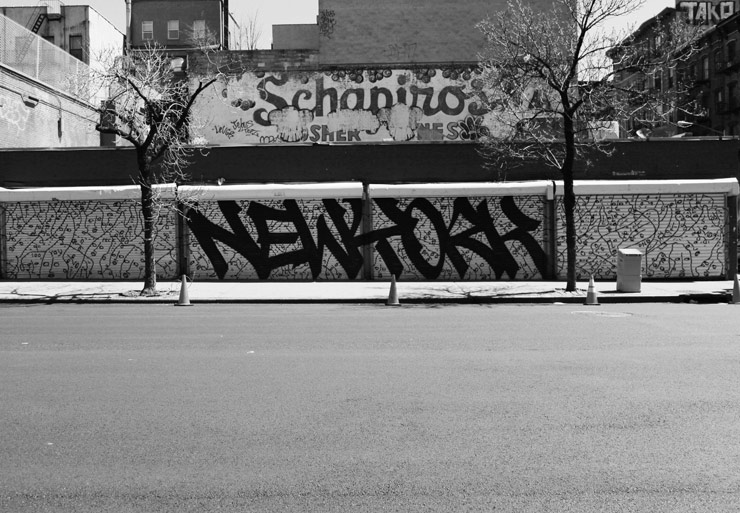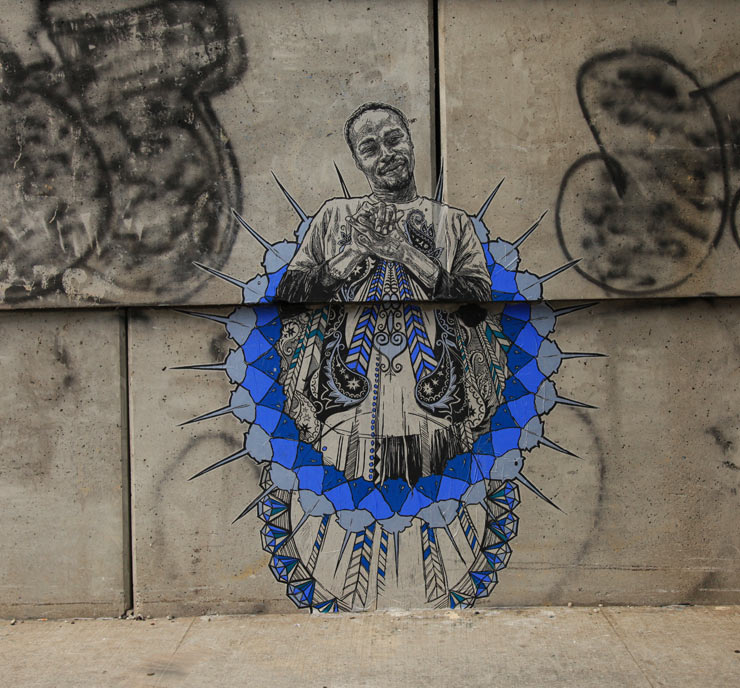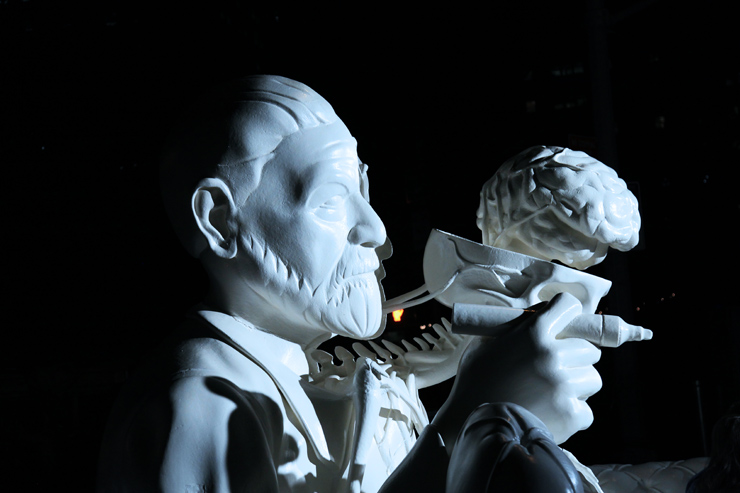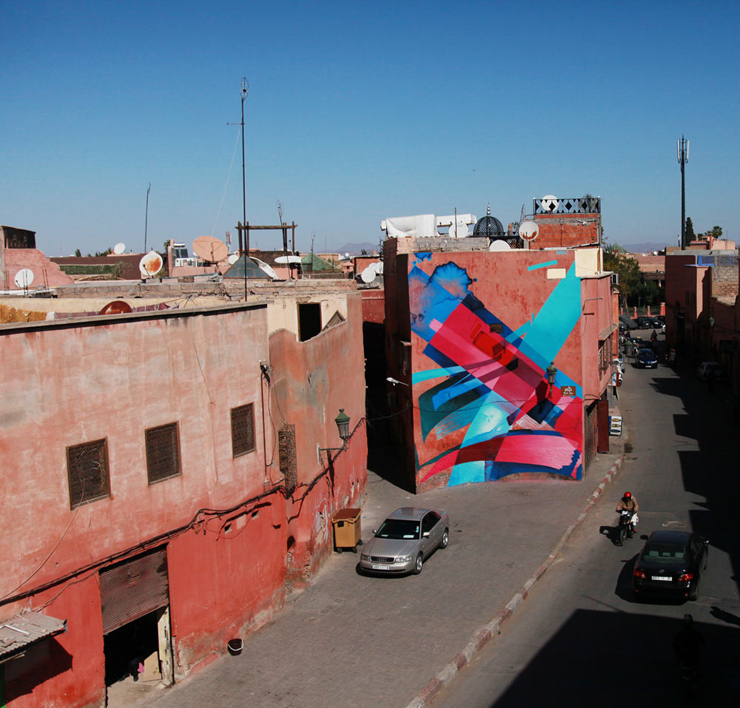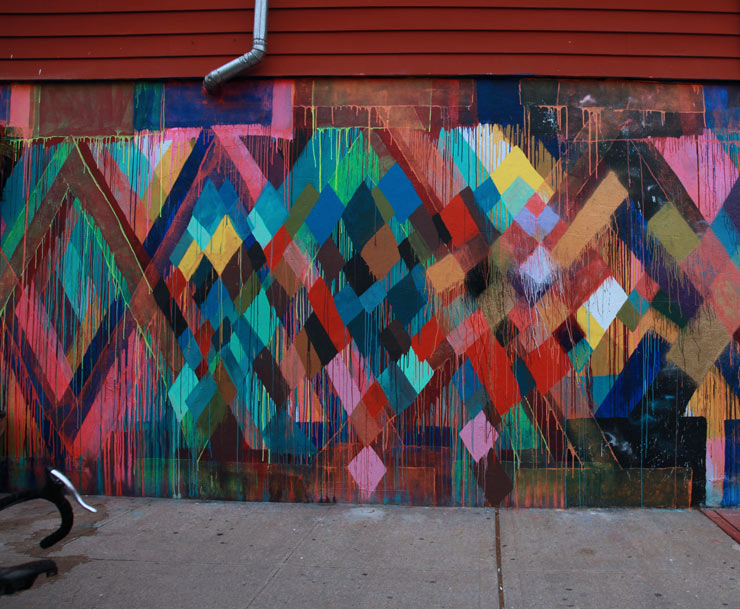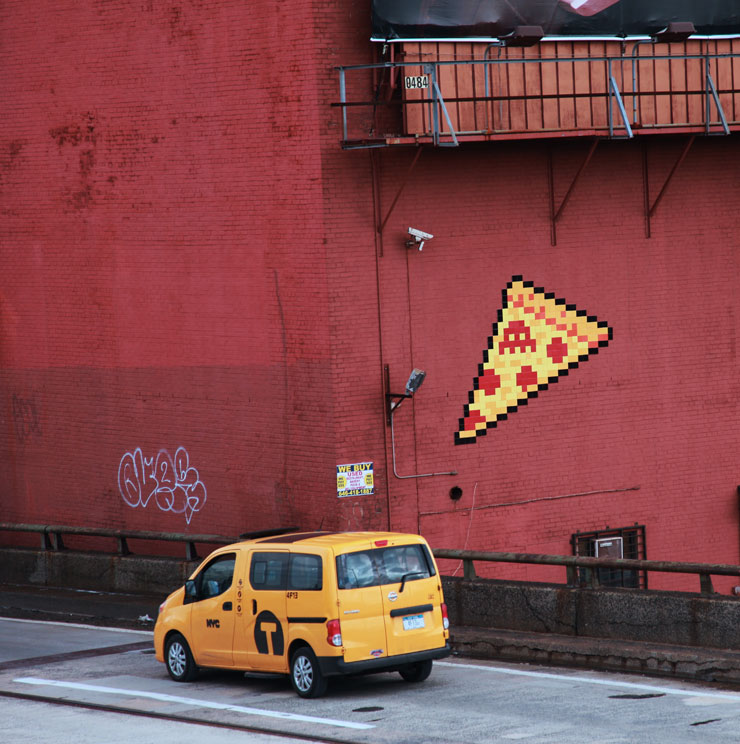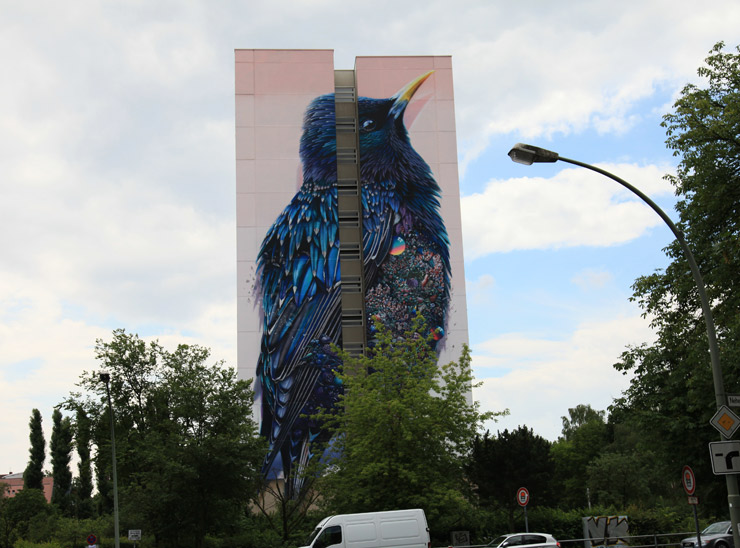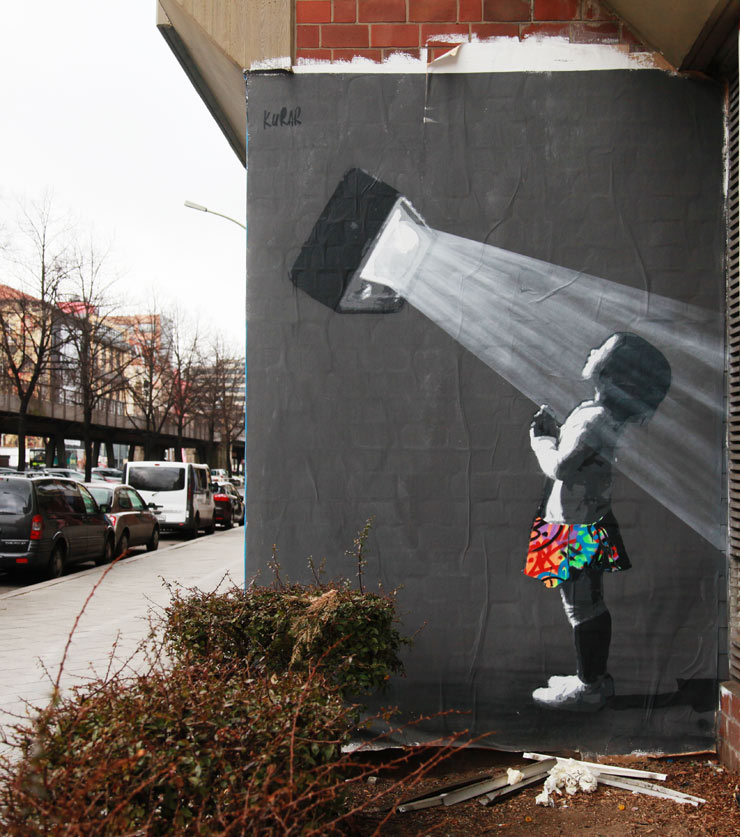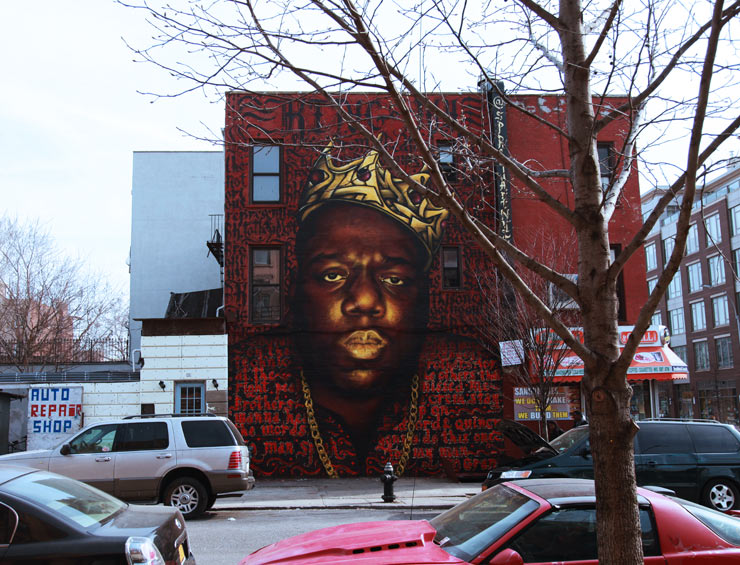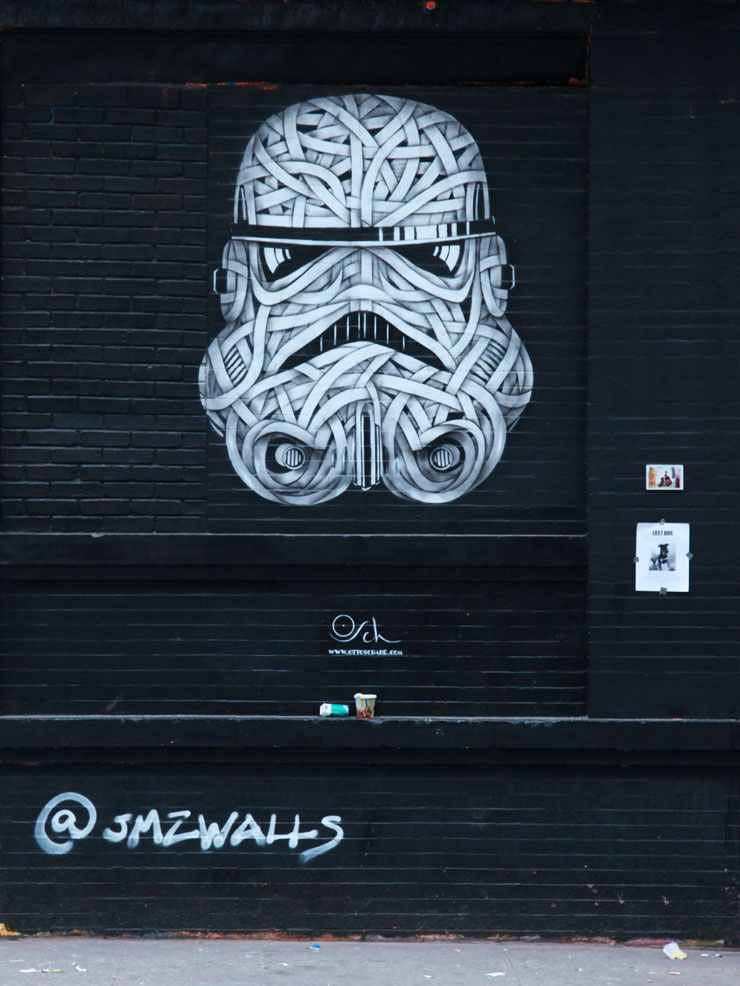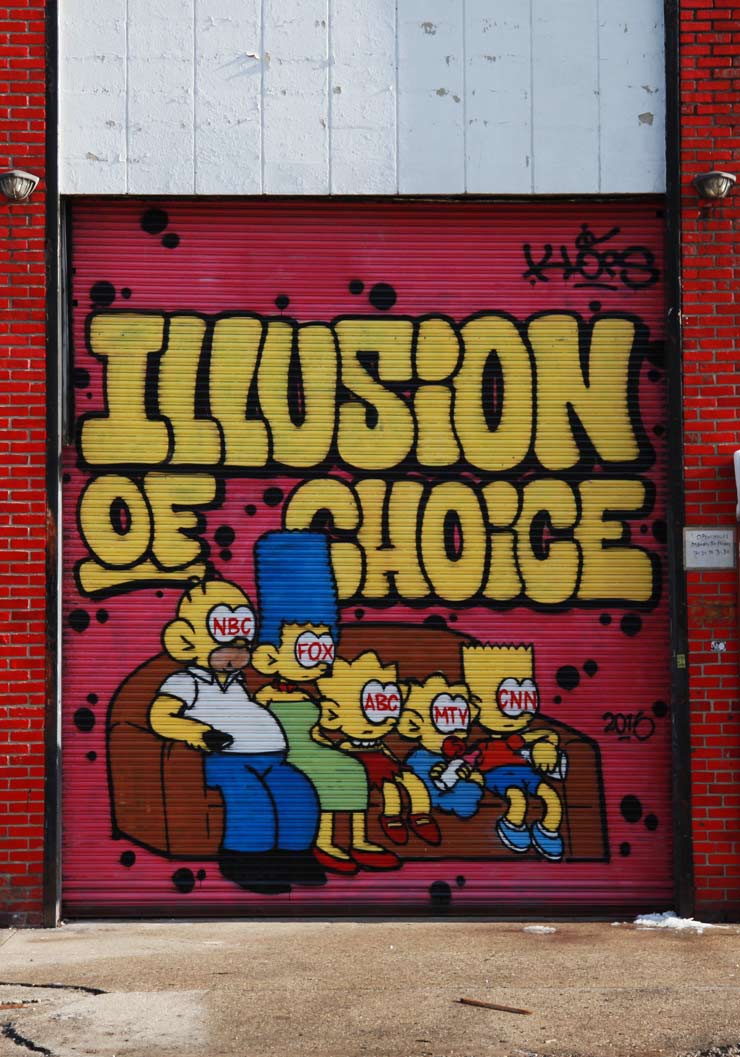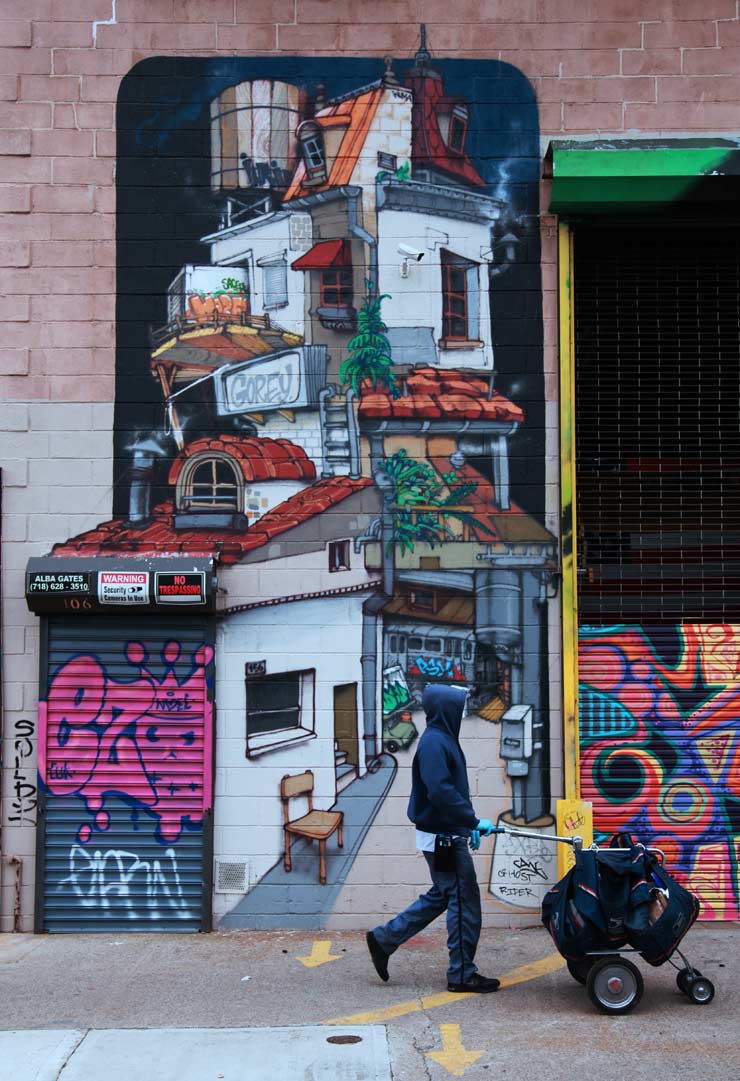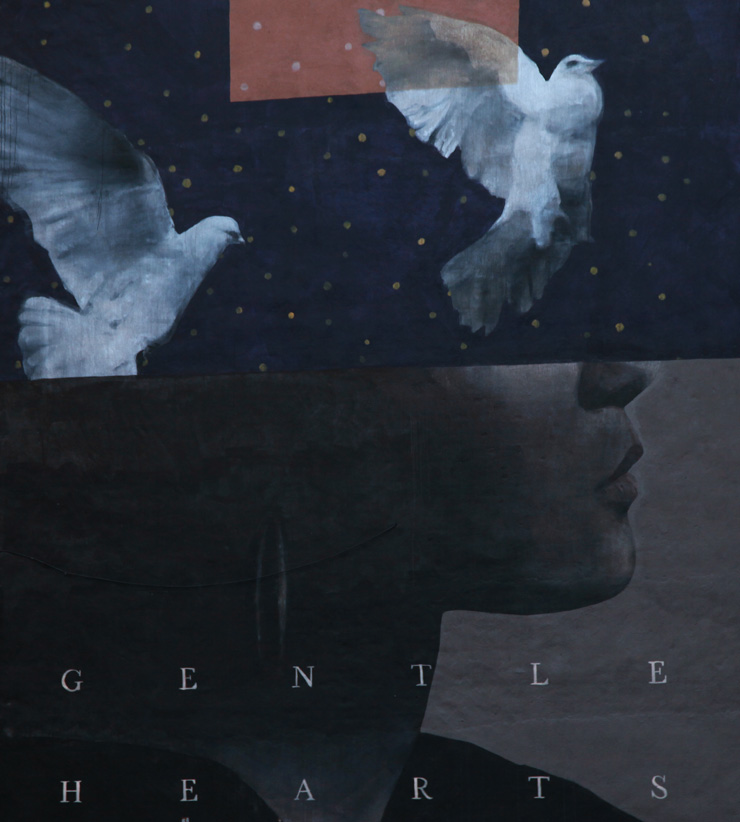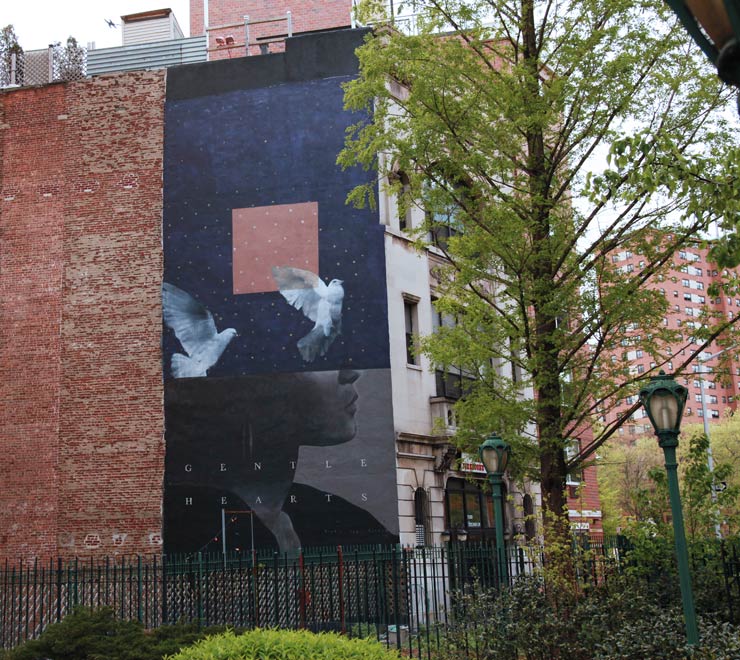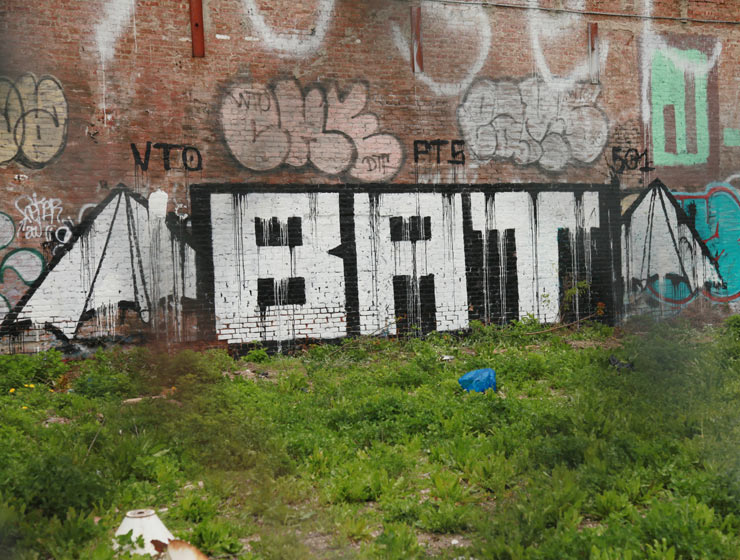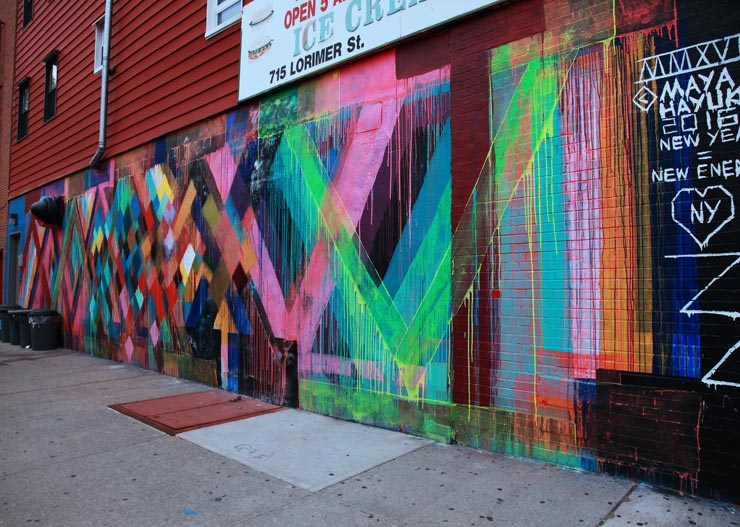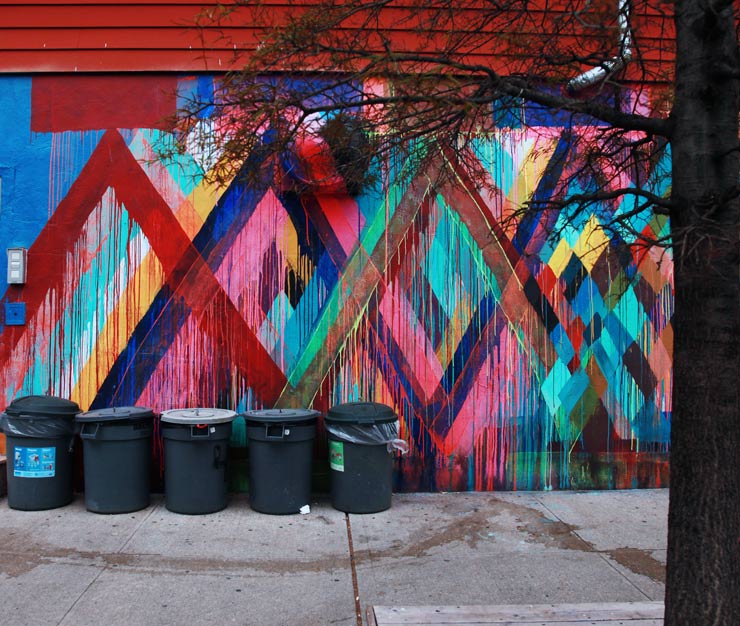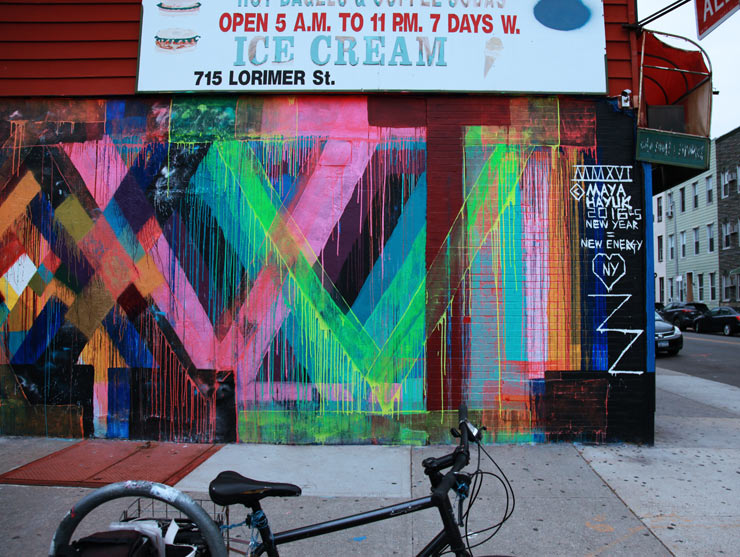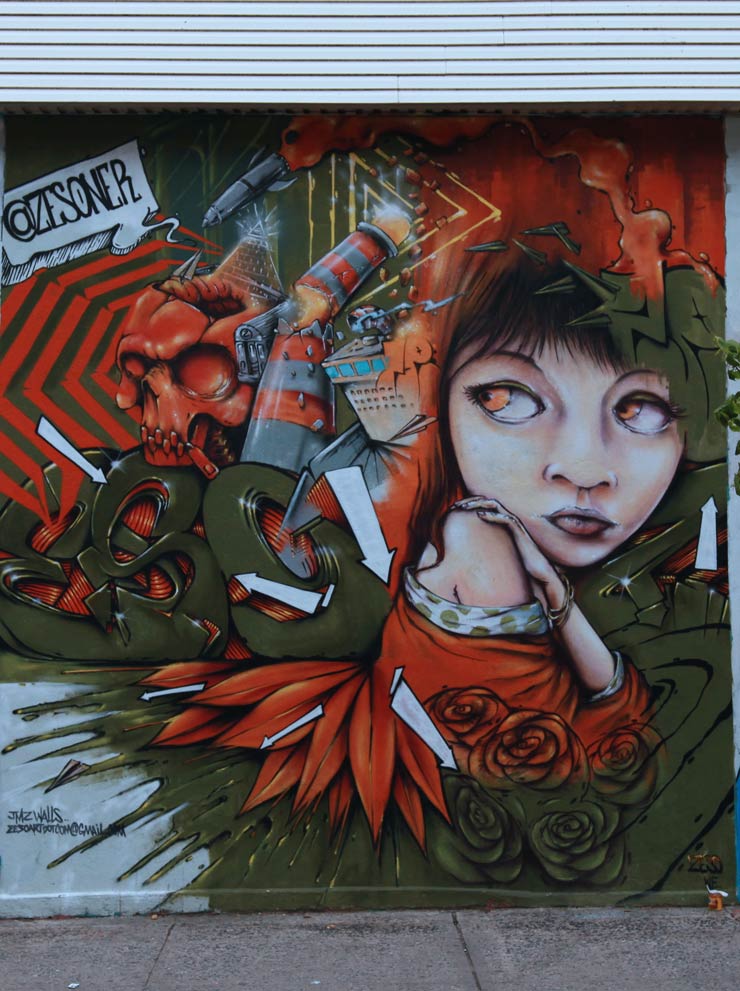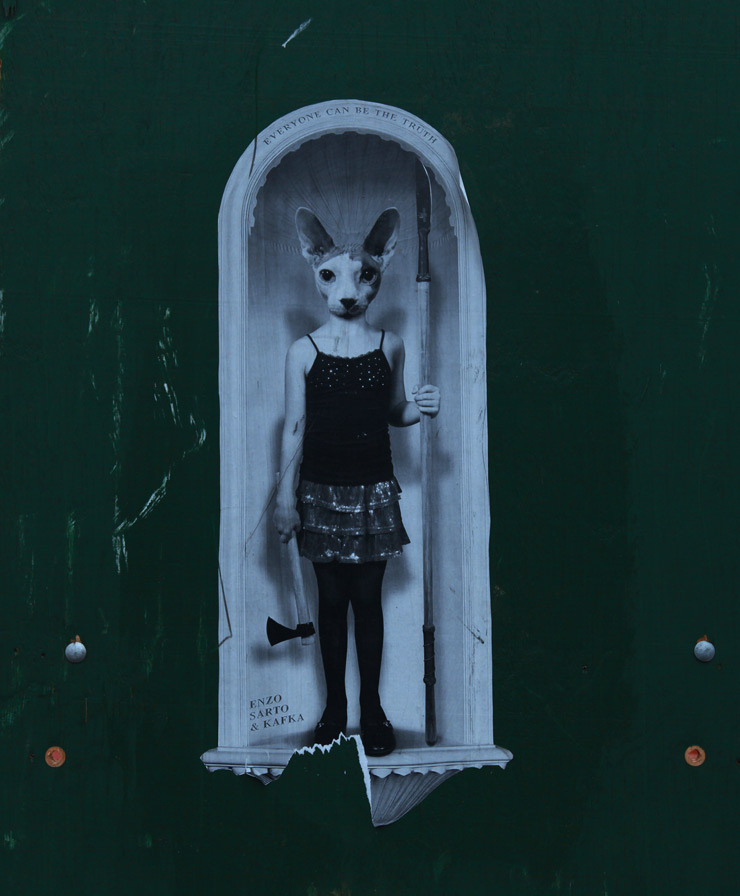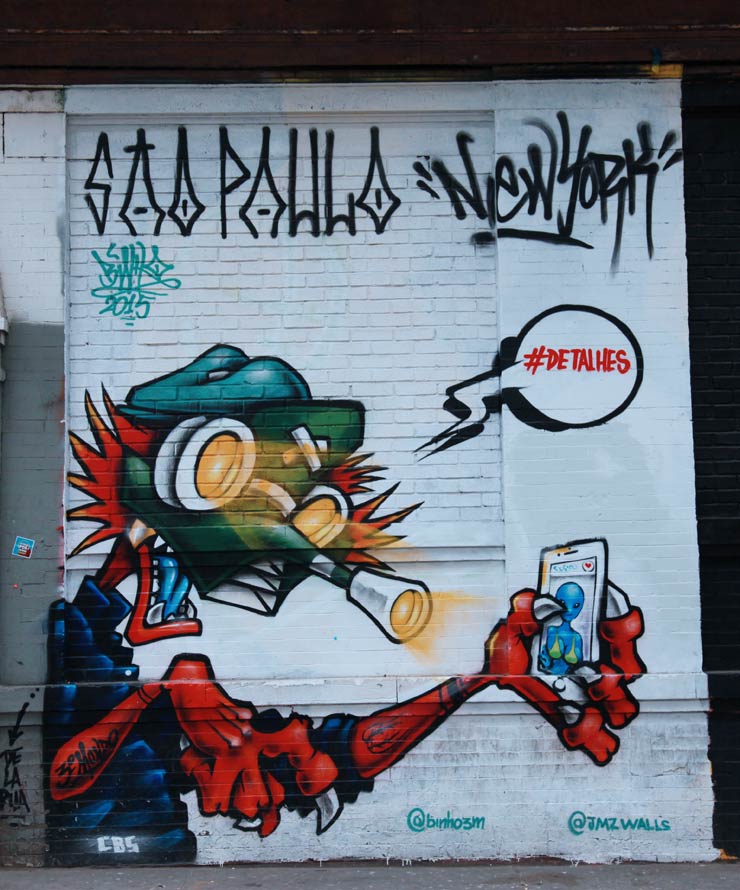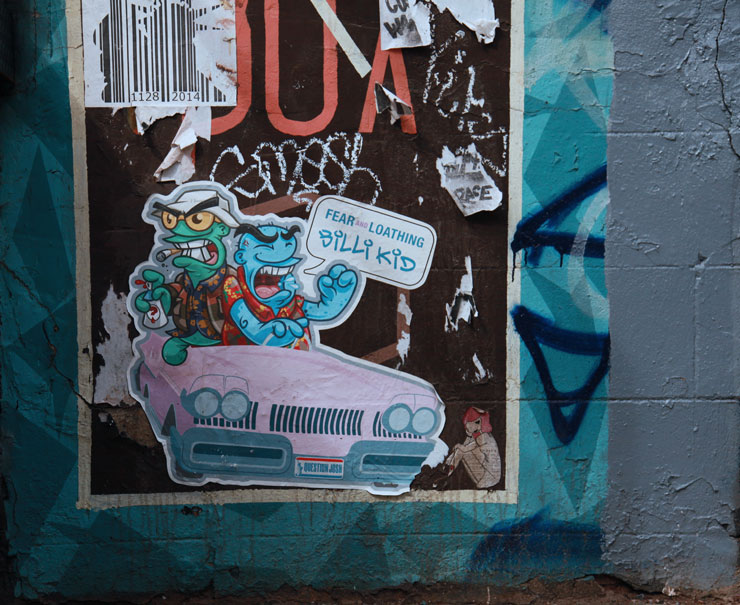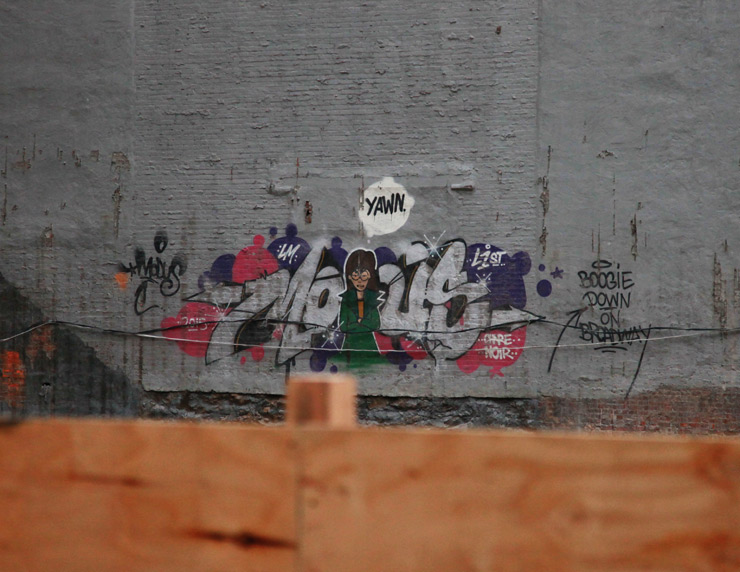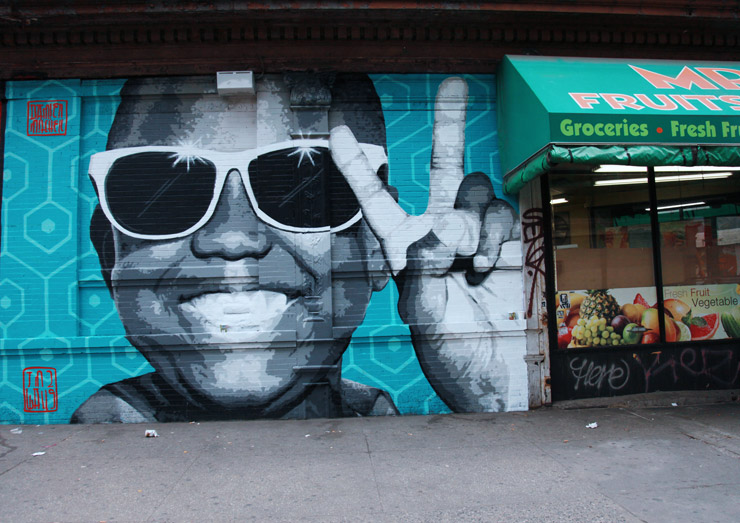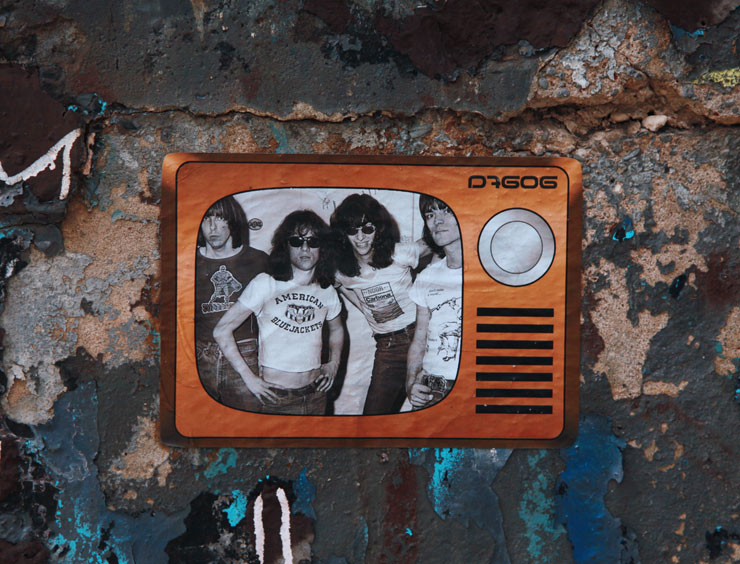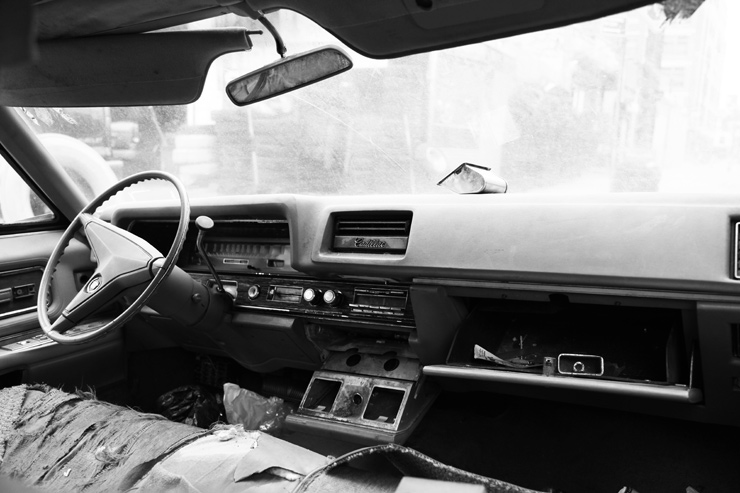Brooklyn’s always breaking records – and today it can boast having the first mural collaboration between a Street Artist and a blind artist. Rubin415 and John Bramblitt have just combined their two uniquely different styles on a Bushwick wall to blast away misconceptions about art, blind artists, and the inevitability of people becoming blind.
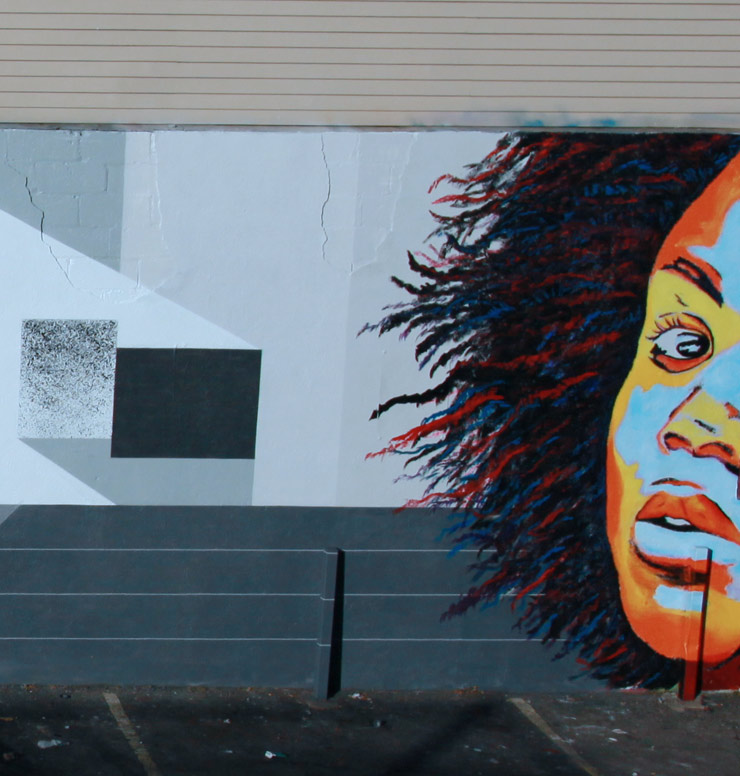
John Bramblitt . Rubin415 for World Sight Day in collaboration with JMZ Walls. (photo © Jaime Rojo)
Highlighting World Sight Day on October 12th, the new mural combines the modernly austere geometrical abstraction of Rubin415 with the striking realism and intense colorizing of John Bramblitt. The long thin wall at the base of a building in a lot provides a welcoming warmth and sophisticated decoding of the design complexity on display in our cityscape.
Blind/Sighted, Street/Studio, Finnish/American, Monotone/Vivid; It is a wonder that these two guys could work together at all. But as we found out during our interview at the wall last week, they forged a creative common ground – and a musical common ground that includes both being serious fans of The Doors, the rock band from the classic era of the 1960s and 70s.
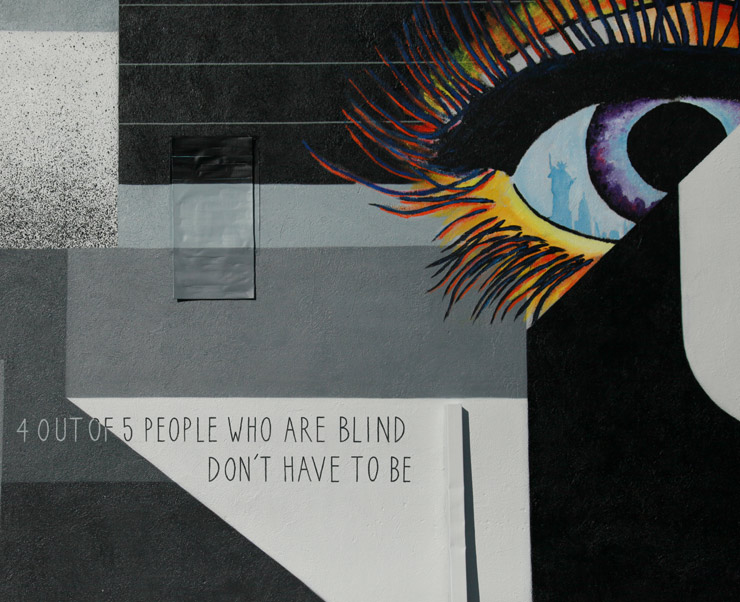
John Bramblitt . Rubin415 for World Sight Day in collaboration with JMZ Walls. (photo © Jaime Rojo)
On this bright and sunny late summer day in an empty Brooklyn lot, everybody was feeling the heat and looking for a cool place to sit while the street traffic charged by and receded into conversations, a gritty thick breeze gradually covering sweaty skin with a film of textured coating.
It’s not always easy to coordinate a small event like this, with artists, equipment, paint, a camera crew, and surprise visitors and inquisitive art fans, including neighbors and even the police, who came to investigate and give a message of support.
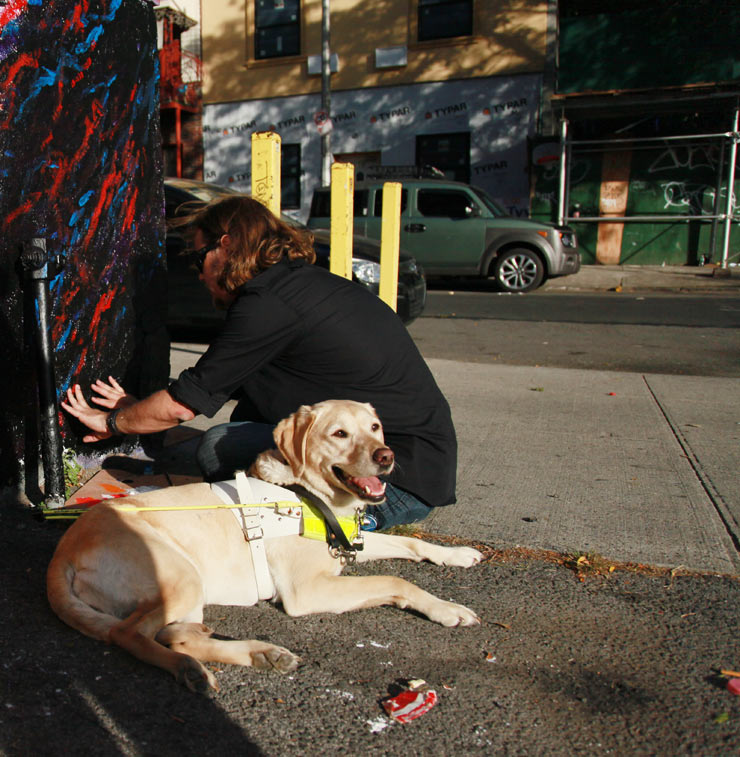
John Bramblitt . Rubin415 for World Sight Day in collaboration with JMZ Walls. (photo © Jaime Rojo)
A project sponsored by the SeeNow campaign and executed by Purpose with JMZ Walls, the whole team want you to know that blindness can be avoided, eyes can be treated and, in cases like the artist John Bramblitt, obstacles can be overcome with fantastic results.
We spoke with the artists and organizers about the new mural, how Bramblitt devised a technique for painting, how they met and how they worked together.
BSA: Did you know each other prior to this project?
John Bramblitt: No. We met for this project – but I am a big fun of Rubin’s work.
BSA: Rubin did you know John’s work prior to this project?
Rubin415: No I hadn’t met him. They asked me if I wanted to collaborate with a visually impaired artist for World Sight Day on October 12th and I said “Sure!” It sounded interesting and I did some research about the organization and about John.
For me collaborating with another artist is all about the person, that is far more important than the work itself. Of course the work is also important – but it’s very important that I can connect and relate with the person. We also talked on the phone and yeah, we clicked. I have collaborated with many artists but never with any artist who is visually impaired.
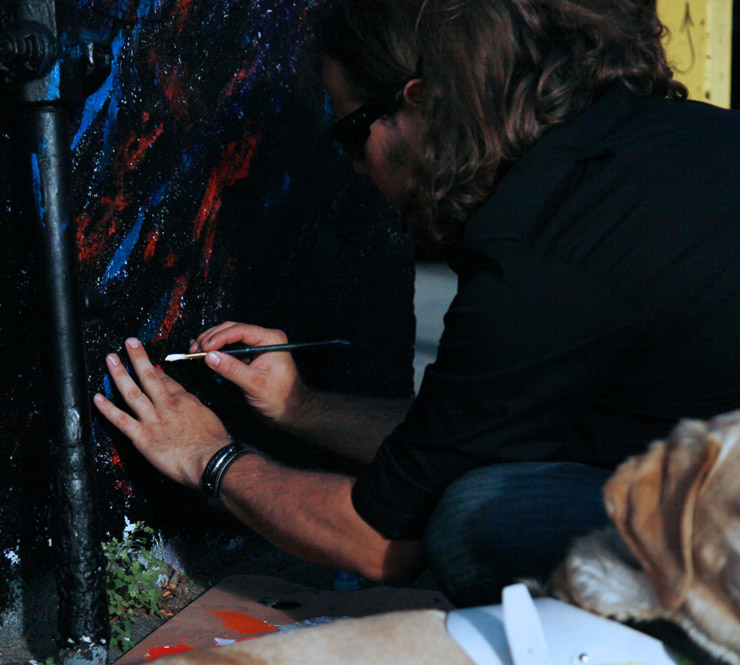
John Bramblitt . Rubin415 for World Sight Day in collaboration with JMZ Walls. (photo © Jaime Rojo)
BSA: John, were you aware of Rubin’s work prior to this project? I am not sure when you lost your eyesight.
John: I wasn’t aware but I’m learning more and more about graffiti artists and street artists. I lost my eyesight in 2001 so it was quite a long ago – so the whole world on the street is incredible and yet I had no idea that all this time I have been walking through these cities and I haven’t been able to see the works and now I realize that I’ve been walking in an open door gallery basically. I was walking through a museum.
This makes me want to go back and revisit every city I have visited all these years since I lost my eyesight. It is incredible how a whole new world has opened up to me. With all this art that so many artists have been making the world is so much more beautiful and an interesting place to be. It’s like the mural we made here and the statement we want to make – we can take Art and make a great statement with art.
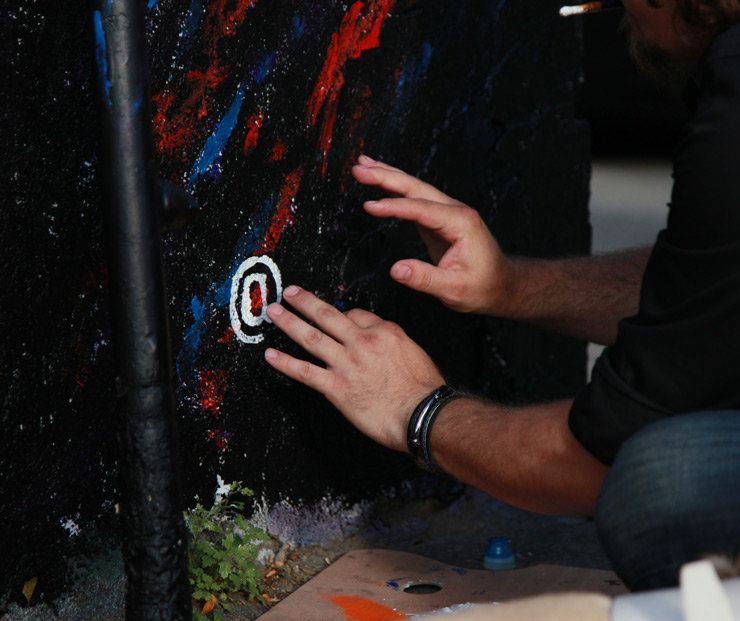
John Bramblitt . Rubin415 for World Sight Day in collaboration with JMZ Walls. (photo © Jaime Rojo)
BSA: John how is your memory?
John: When it comes to art is very good! (laughs) I can remember every painting I have made but when it comes to names my memory is not very good.
BSA: John Are you able to remember colors? How do you mix the colors?
John: It’s through touch. It basically works the same way with a sighted artist and how she or he would work when they mix their colors. With me, instead of using my eyes, I use my hands. Whenever I draw, I draw lines that I can feel. I know the lines are raised. For instance here on this wall the surface is very dry and grainy feeling so the paint that I’m using is slick. So it’s smooth and that makes it very easy for me to tell the lines.
It in my studio I mix mediums with the colors. With every color I actually build differently, like the red will feel differently than the blue because I mix it to feel differently. Here on this wall it’s a little bit different. I didn’t want to get crazy with the mediums; I wanted to be concerned about the weather and that the wall wouldn’t be damaged.
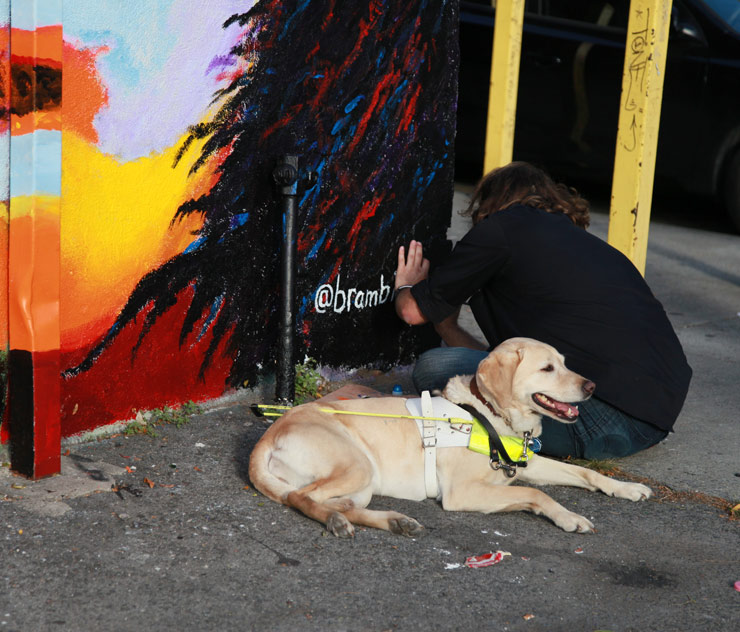
John Bramblitt . Rubin415 for World Sight Day in collaboration with JMZ Walls. (photo © Jaime Rojo)
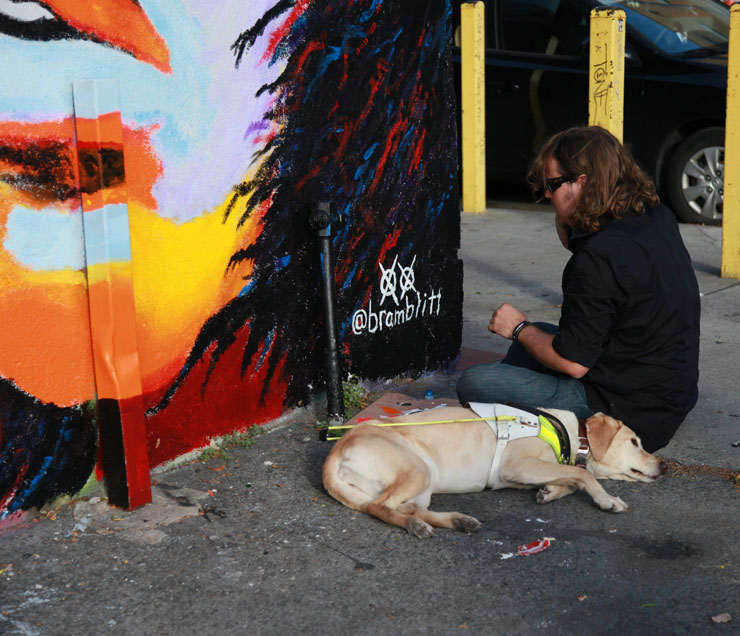
John Bramblitt . Rubin415 for World Sight Day in collaboration with JMZ Walls. (photo © Jaime Rojo)
BSA: Were you trained by an expert to learn how to discern colors by using your hands?
John: No. I am the one who came out with the techniques for painting and one of the things that I do is go to the museums and I go to schools. I work with blind services all over and I try to teach visually impaired children – but there wasn’t anybody to teach me.
When I started I was lucky to learn about drafting and illustration and they were so supportive. So I’m just taking what I learned from that and from my traveling with my guide dog or with a cane. You learn techniques on how to touch and how to understand where you are – and where other things are. So I’m applying that to art. It is the same way I navigate a canvas or a wall. It is the same way I get around the city streets when I leave my house. The more I paint the easier it is for me to get around actually and the more I get around – the easier it’s for me to paint.
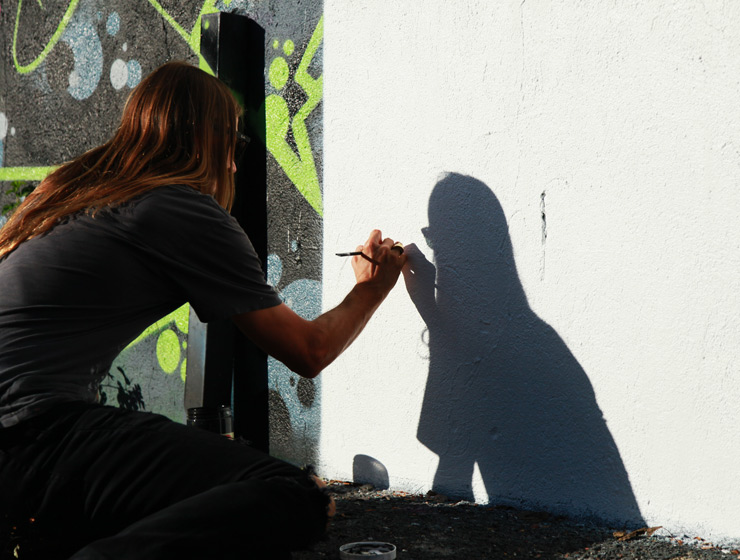
John Bramblitt . Rubin415 for World Sight Day in collaboration with JMZ Walls. (photo © Jaime Rojo)

John Bramblitt . Rubin415 for World Sight Day in collaboration with JMZ Walls. (photo © Jaime Rojo)
BSA: Rubin, was there a time at some point that you tried to describe your work to John?
Rubin: That’s a good question. You know what? Most of the time I forgot that John cannot see. We mostly talked about music and we kept painting listening to music – talking about music.
BSA: So are your musical tastes similar?
John: We actually like a lot of the same music, we were grooving on the same music actually.
Rubin: I asked John kind of a hard question. I asked if you were to pick you favorite musical artist who would that be? And you know he mentioned the same band that I will have chosen too: The Doors. I would also pick the Doors, it is a hard question but when John said that when we were talking about music I tried to go with my gut feeling and I knew that John and I will connect really well on that level.
BSA: It is fantastic that two plastic artists are able to connect and find common ground through a different artistic expression.
John: Oh my goodness. In my studio I have this technology where I can have a photograph and make it a raised line. I have 3-D printers and I can print things out. When Tony and I were talking about all of this I was able to feel his artwork. I was able to feel the lines, the geometry. The shadiness, of course, I couldn’t but the complexity I could. So as soon as I was feeling it I thought “Oh, I can’t wait to meet this guy. It’s just going to be so great.”
One concern I had because I cannot see when I’m working with another artist and I don’t know what they are doing – I don’t know what’s going on. But the moment I talked to Rubin and the moment I was able to feel his work – all of that went away. I thought “This is going to be brilliant. I cannot wait to get here and meet him and to see what he does on the wall, even though I worked on the wall as well. I also had the joy of being an spectator and to see his creative process.
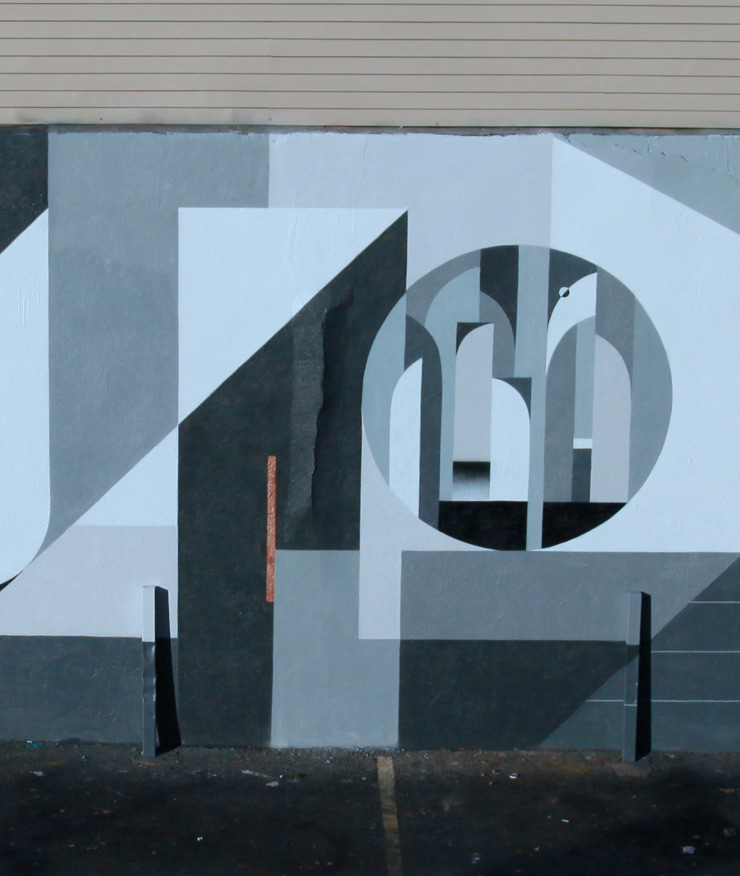
John Bramblitt . Rubin415 for World Sight Day in collaboration with JMZ Walls. (photo © Jaime Rojo)
BSA: So the difference between the museums and the street is that on the street you can actually touch the works but in museums you usually cannot go and touch the works, can you?
John: Not usually but it depends. The museums that I work with – we try to make the artwork more of a visceral experience. On the tour that I’m a part of when I’m giving talks we may actually go and touch the sculptures, or we will learn some dance – anything that we can do to use any of our other senses. In life we use all of our senses to get around the world and to appreciate things around you, so when you go to a gallery or to a museum and suddenly they say, “No you can only use your eyes,” its so restrictive. So this is one of the great things about street art. People can come and touch the artwork. They can have a picnic in front of it if they want.
BSA also talked with Joonas Virtanen from Purpose, who is the Creative Lead of the project:
BSA: Joonas how did you get involved with this?
Joonas: We were asked to do something interesting to raise awareness for World Sight Day. We decided not to do a normal traditional ad campaign, instead we decided to try something different and raise awareness through art. We have seen John’s work online and he blew us away with his processes and we are also big fans of street art – so we felt like how crazy would it be to see if John would be able to do some street art and essentially make the world’s first Street Art piece painted by a blind person.
But we also wanted to make sure that John was comfortable and that the whole piece was actually interesting so we needed to pair him up with an actual street artist and we were looking through some different options. We wanted to find someone whose style is distinct enough from John’s so that it compliments it instead of competing with it and I have seen Rubin’s work, I live here in Bushwick. I thought that he would be the perfect partner for this because of his work with its geometric lines, monochrome colors whereas John’s work is more like super colorful in his style, so I felt like those styles worked really well together. The first time I talked to Rubin over the phone I knew that he was going to be a very good partner.

John Bramblitt . Rubin415 for World Sight Day in collaboration with JMZ Walls. (photo © Jaime Rojo)
See Now | The movement to end avoidable blindness
www.seenow.org
International Agency for the Prevention of Blindness (IAPB)
On World Sight Day, the IAPB will be releasing new country-specific data on avoidable blindness in your country.
www.atlas.iapb.org
Editors Note: The interviews were recorded and slightly edited for brevity and clarity.

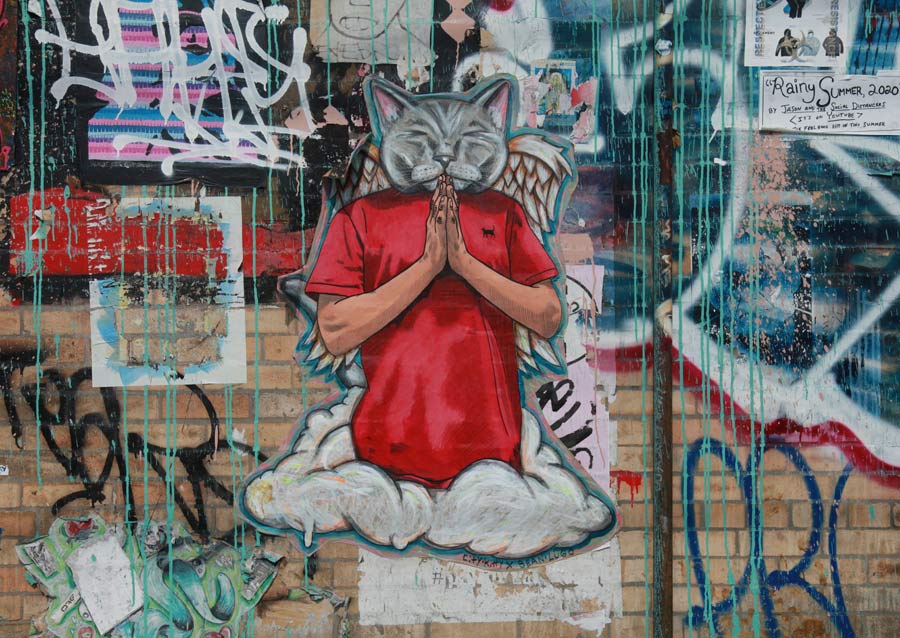
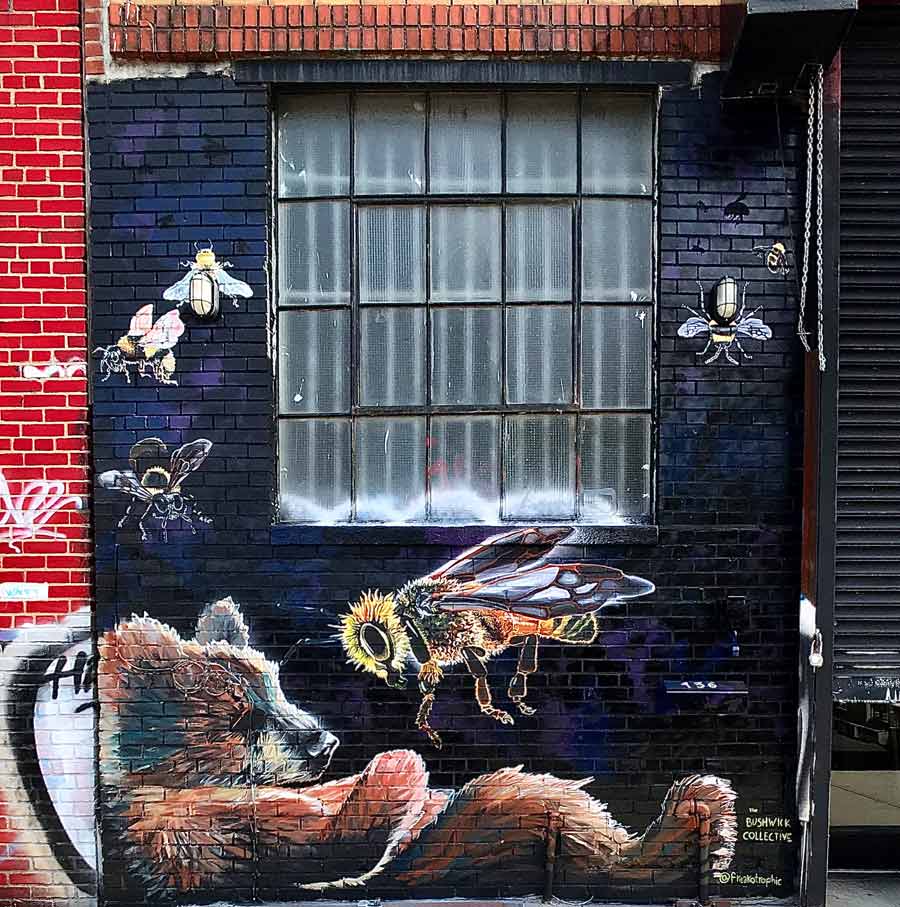
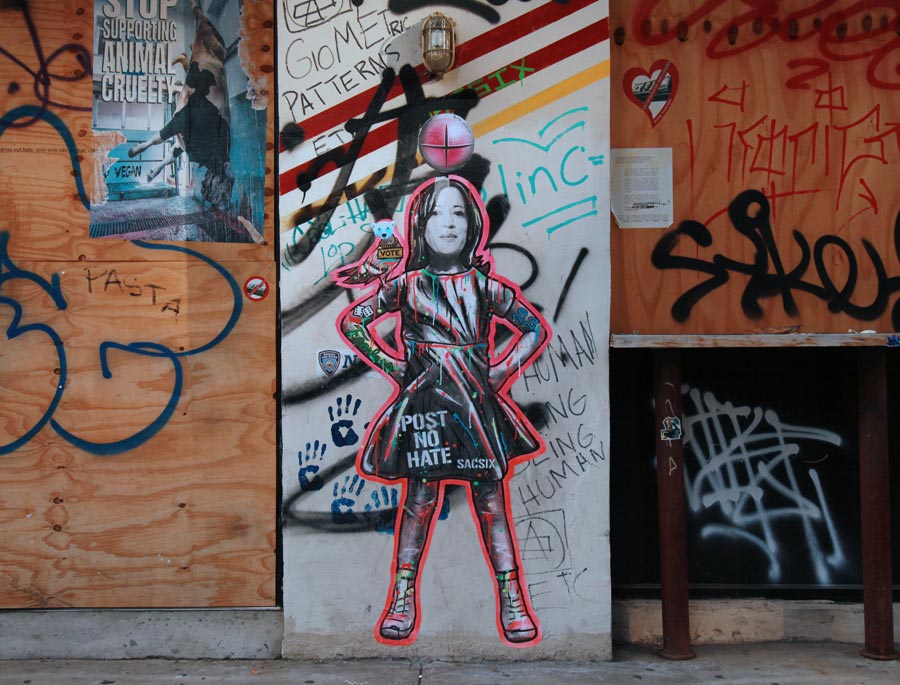
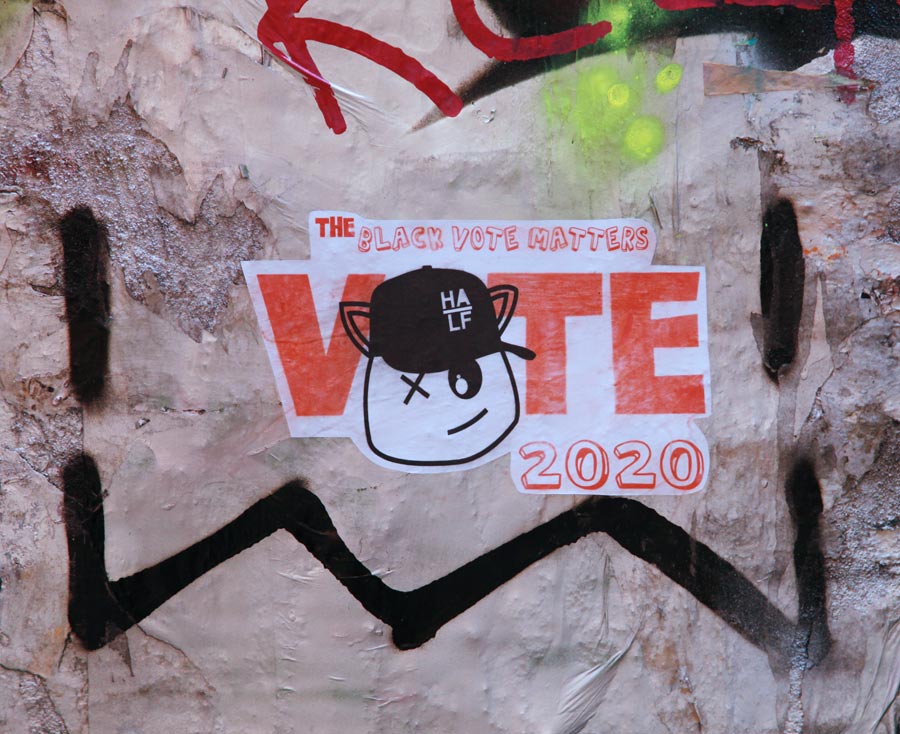
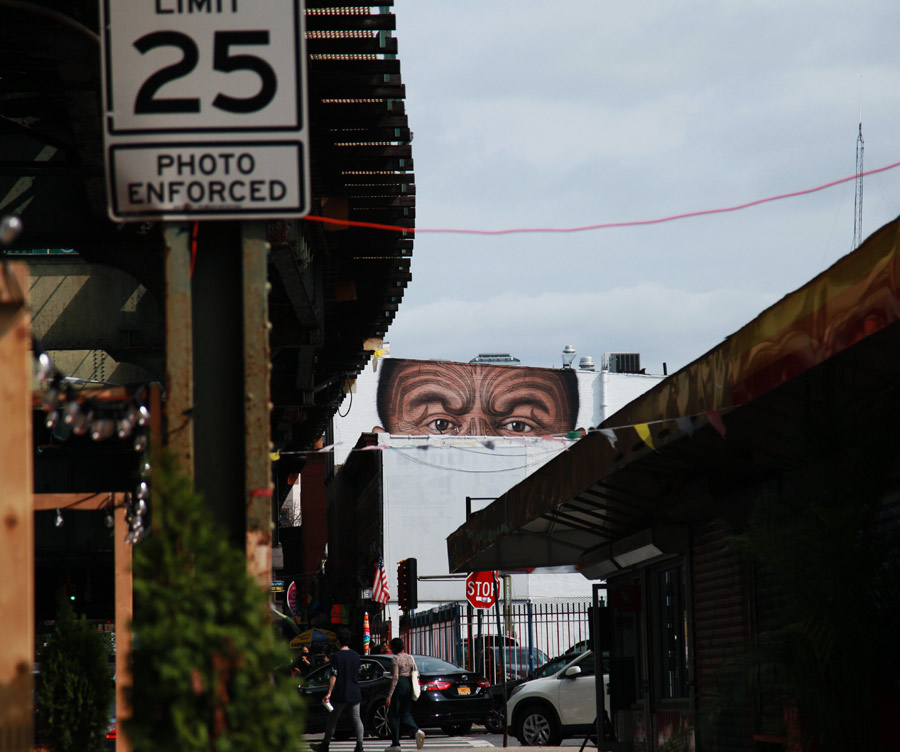
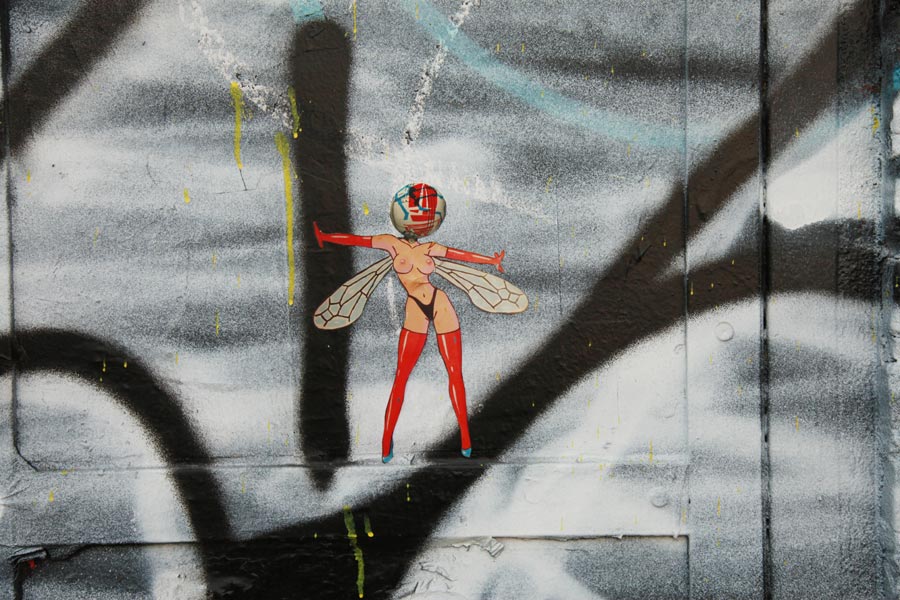
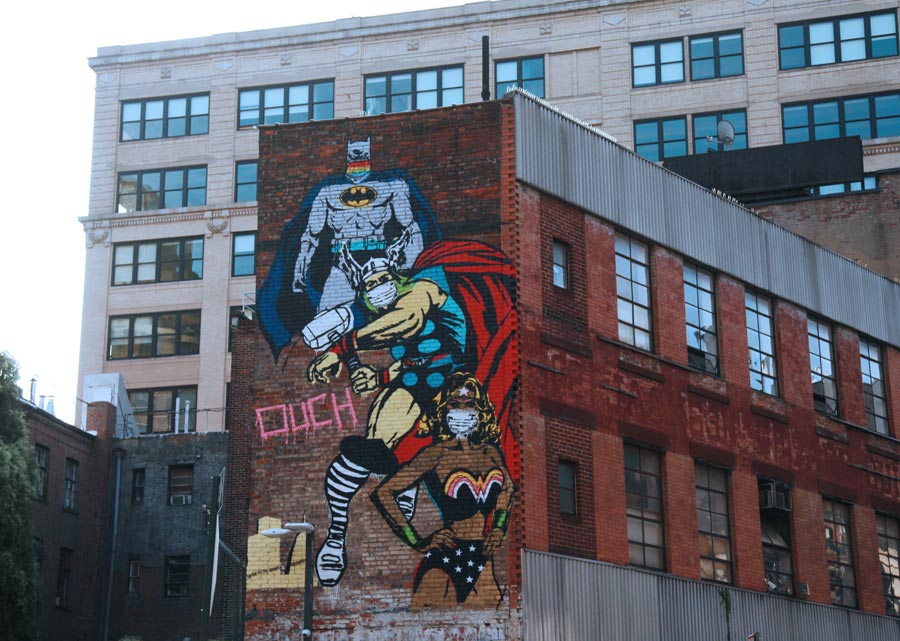
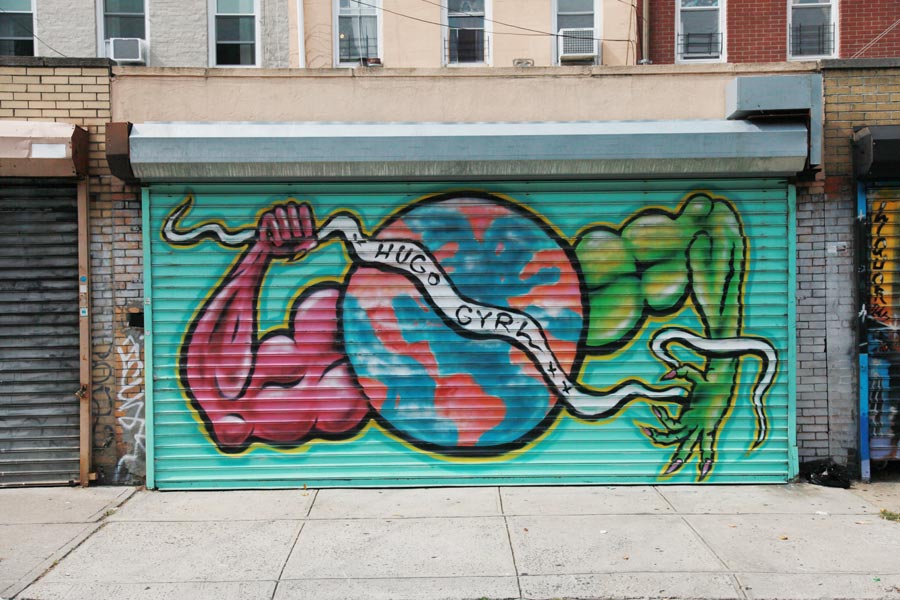
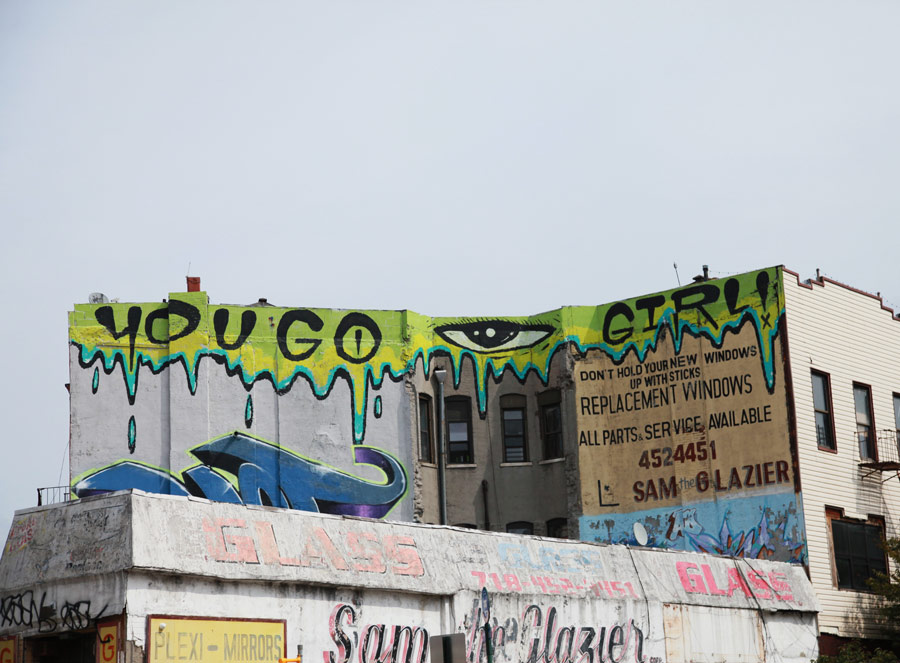
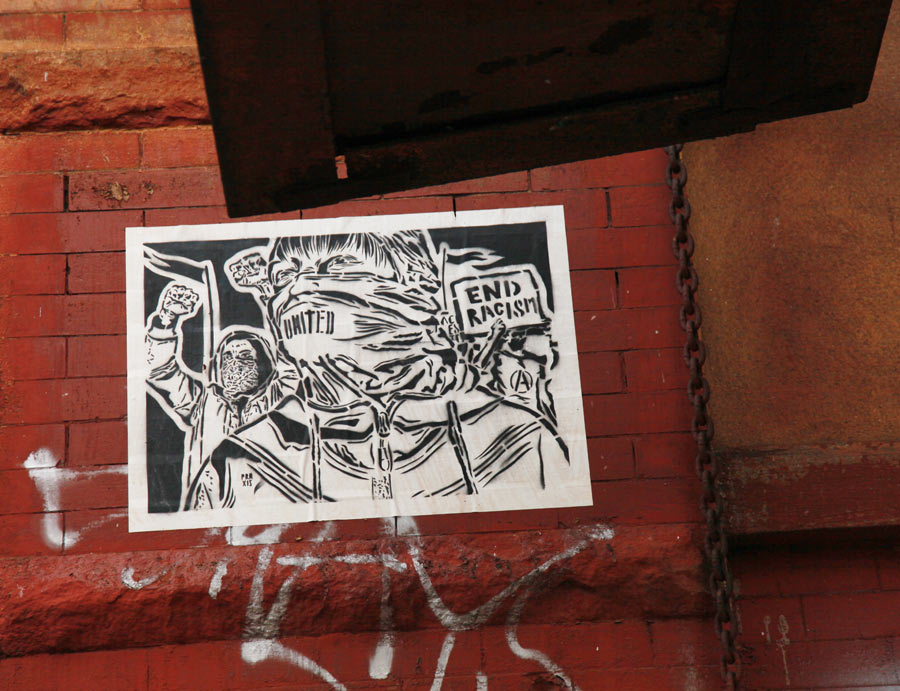
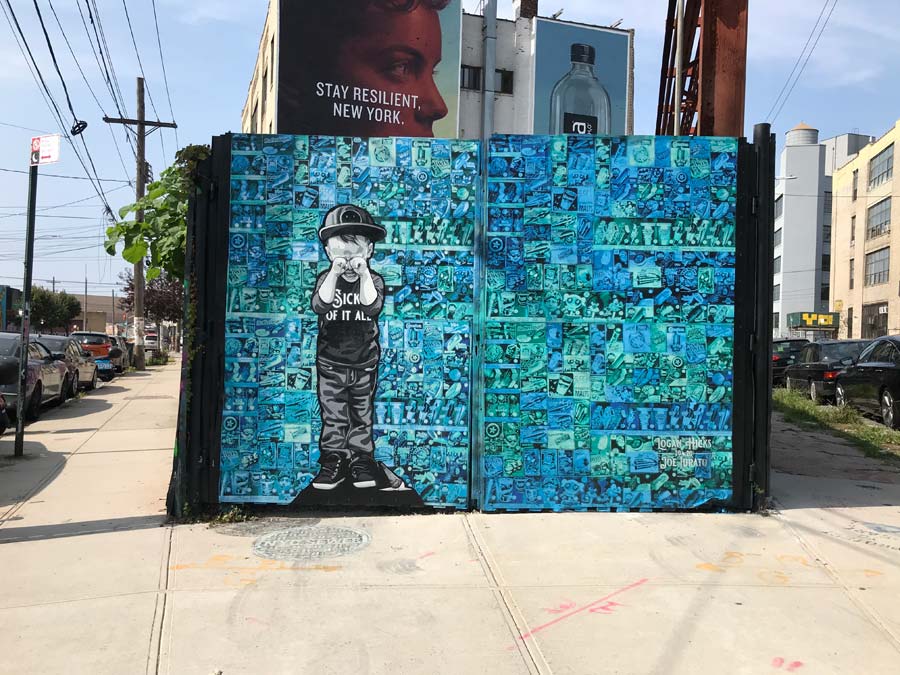
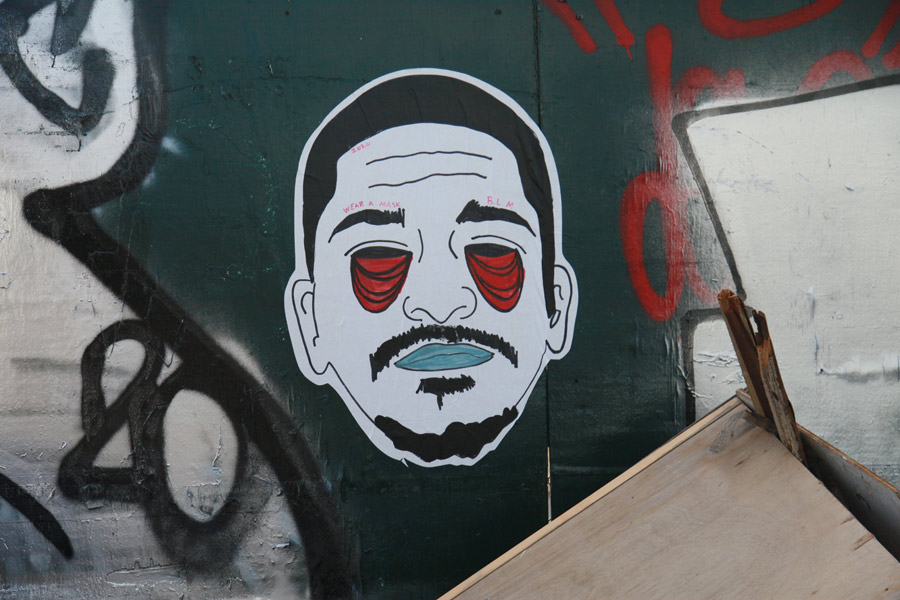
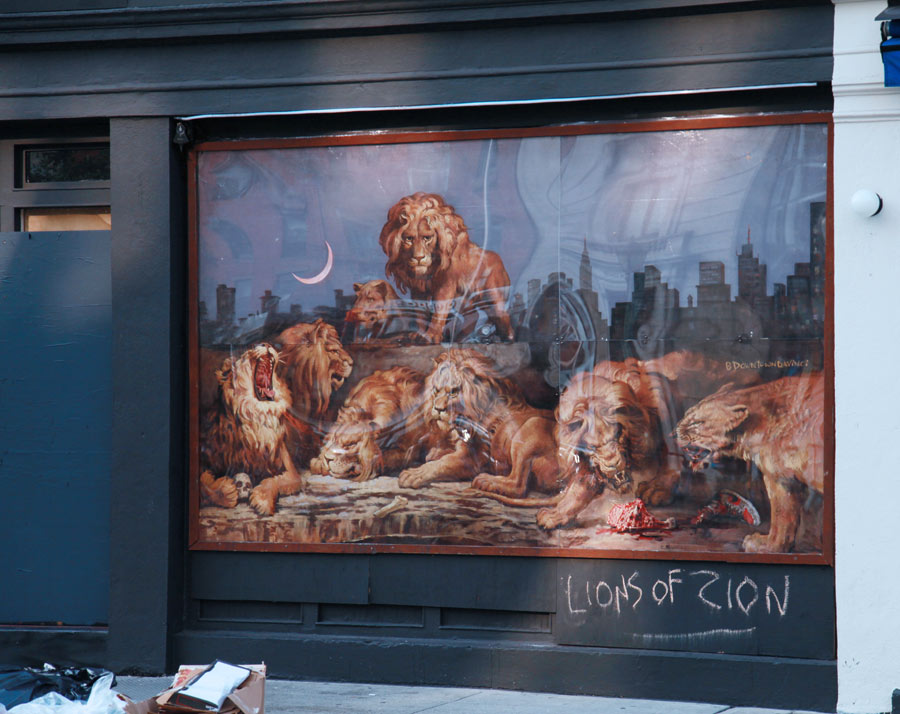
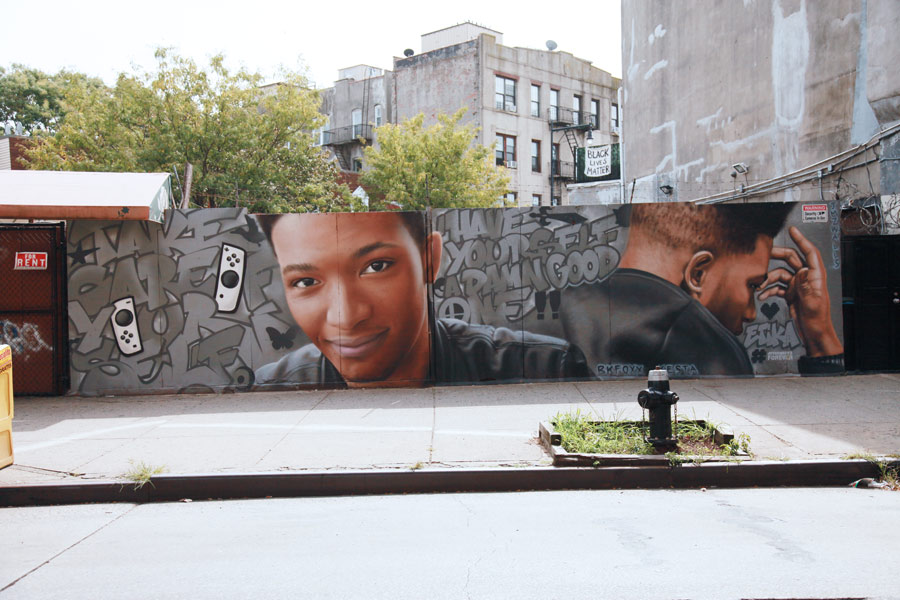
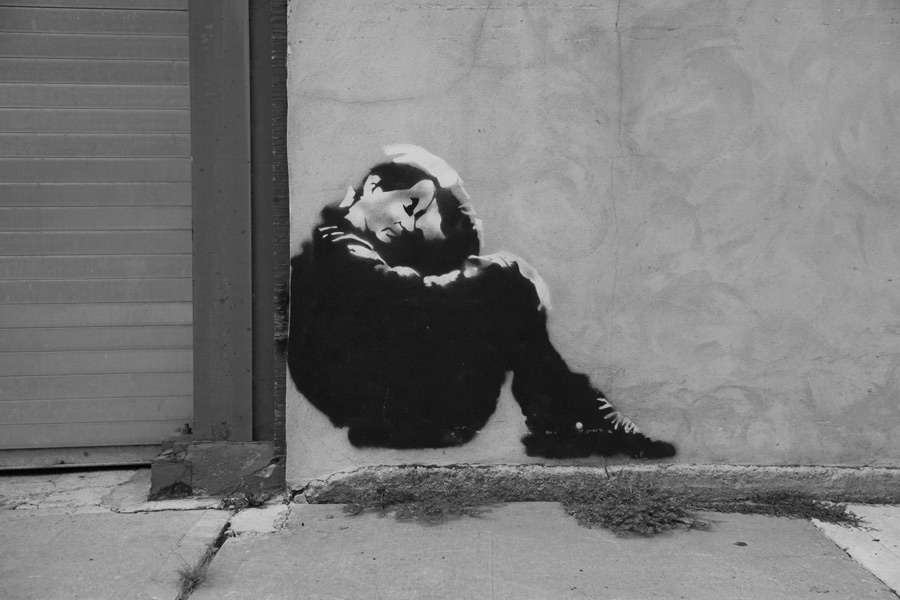
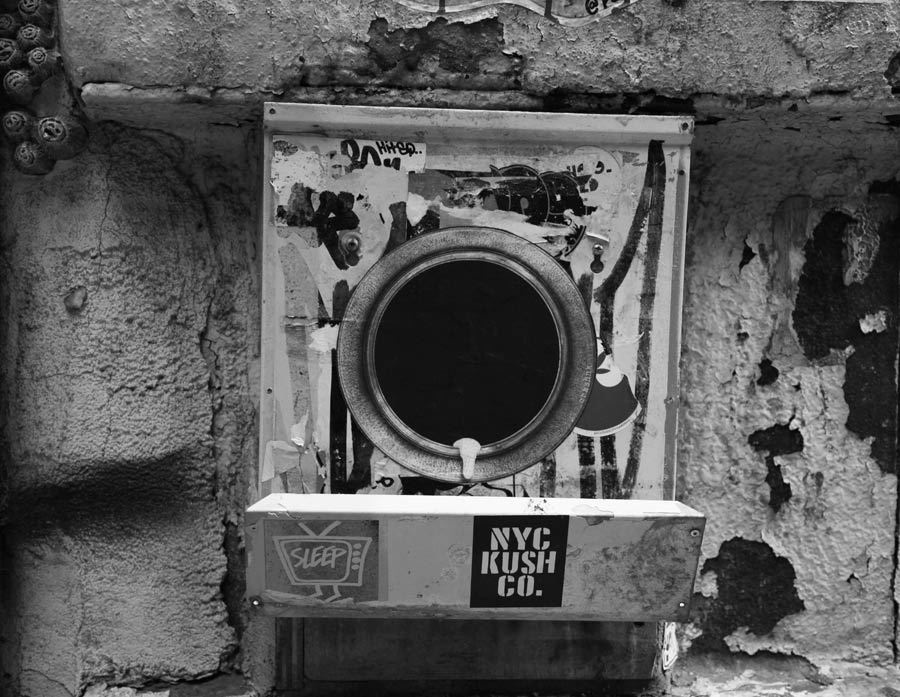
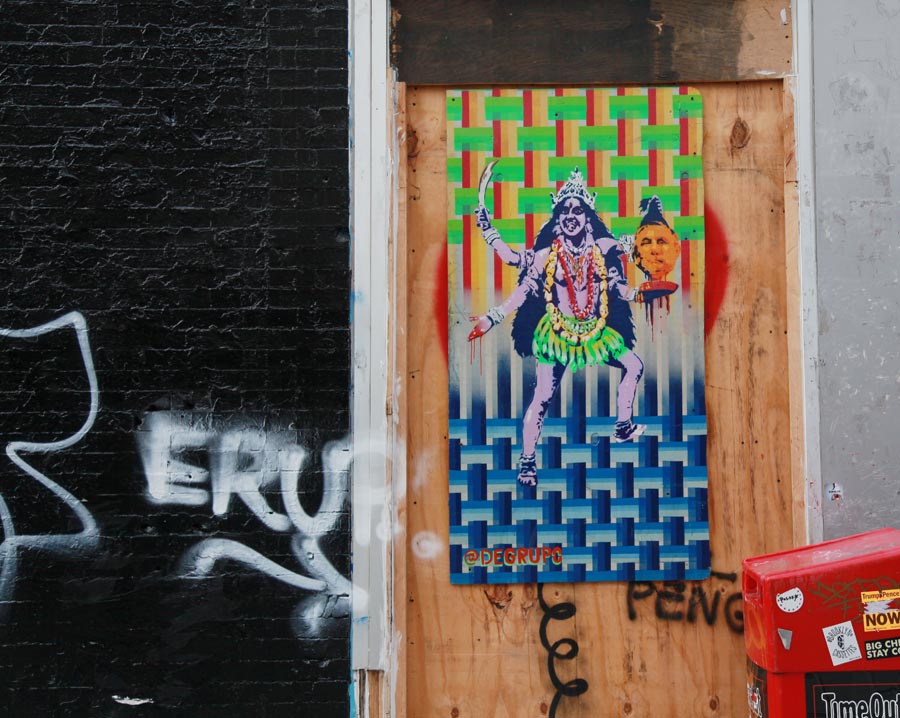
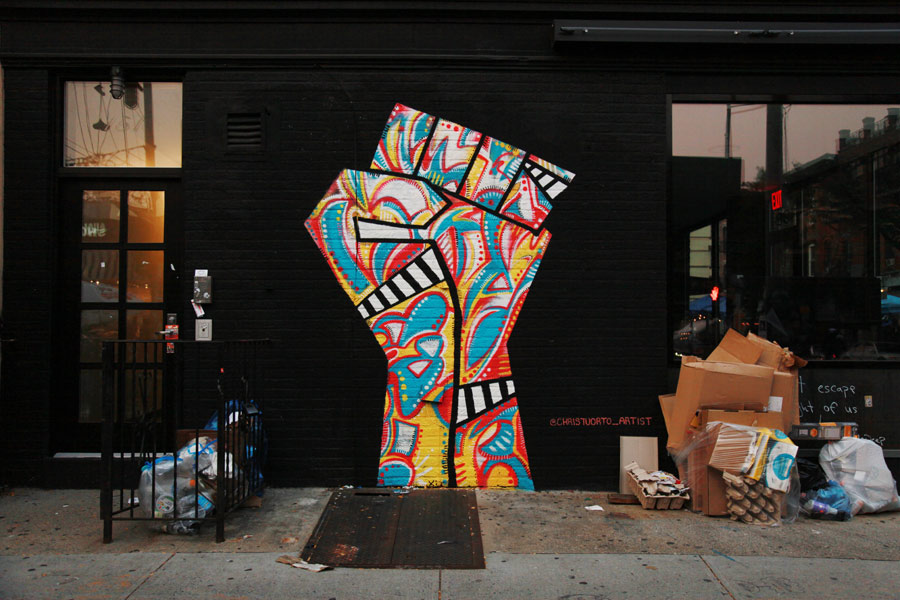
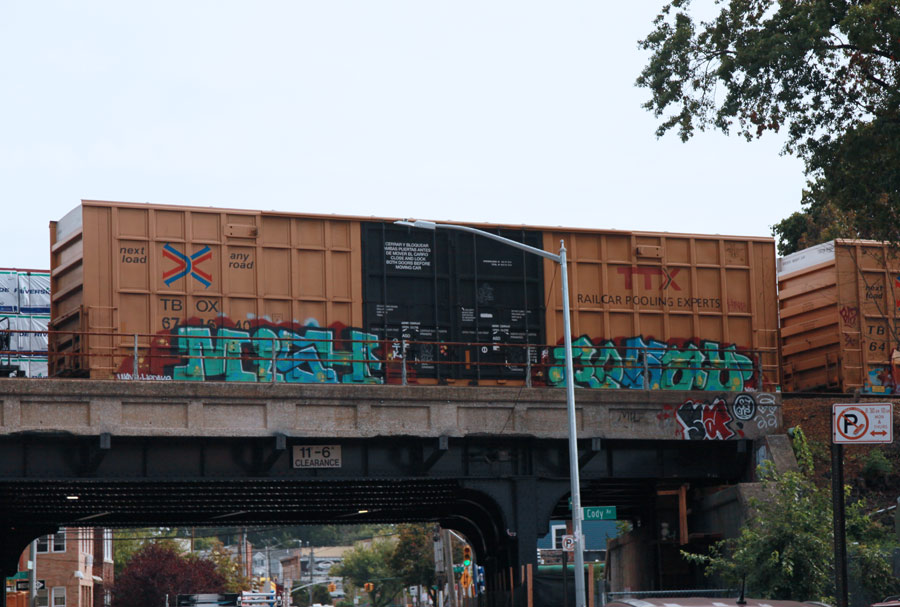
 BROOKLYN STREET ART LOVES YOU MORE EVERY DAY
BROOKLYN STREET ART LOVES YOU MORE EVERY DAY